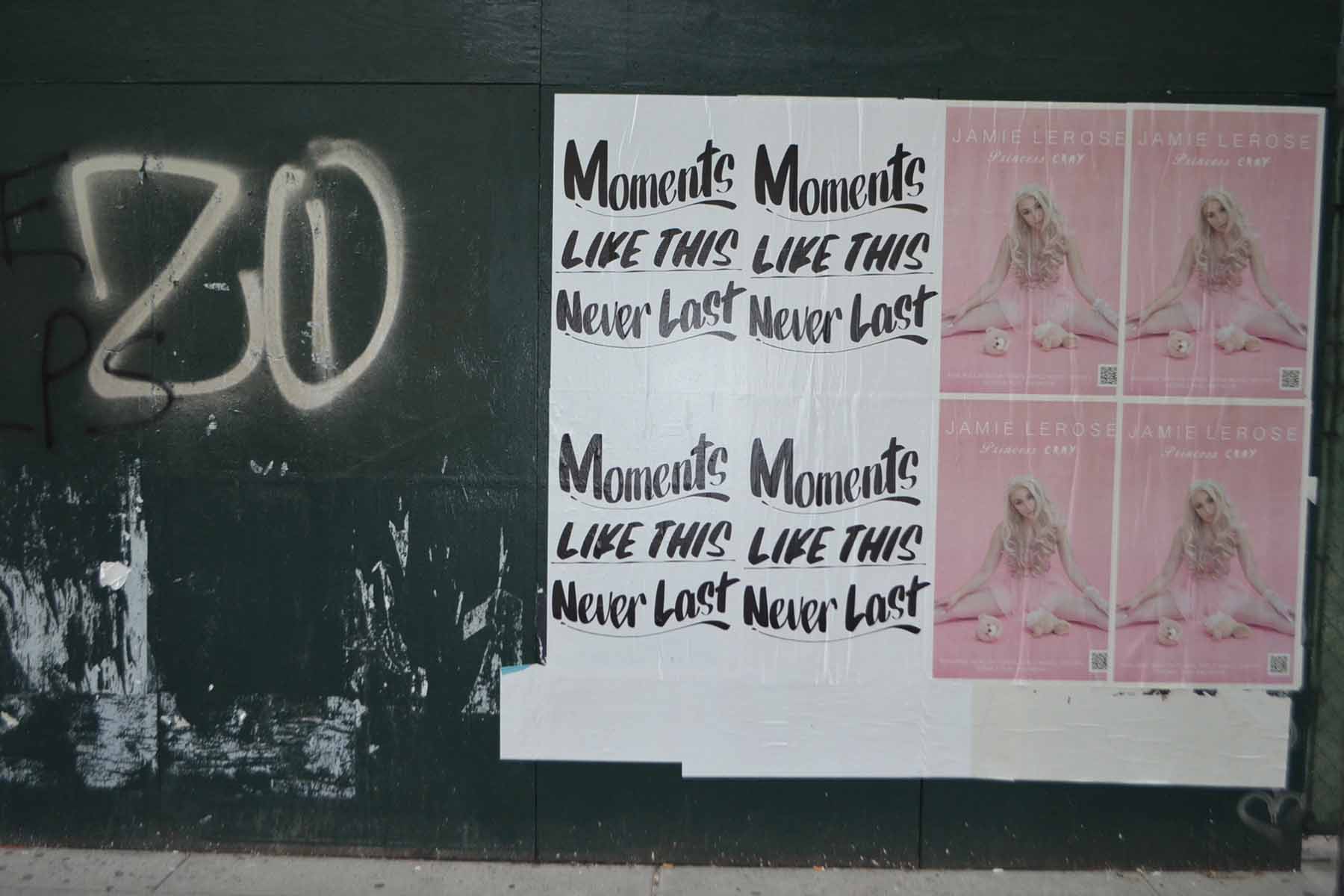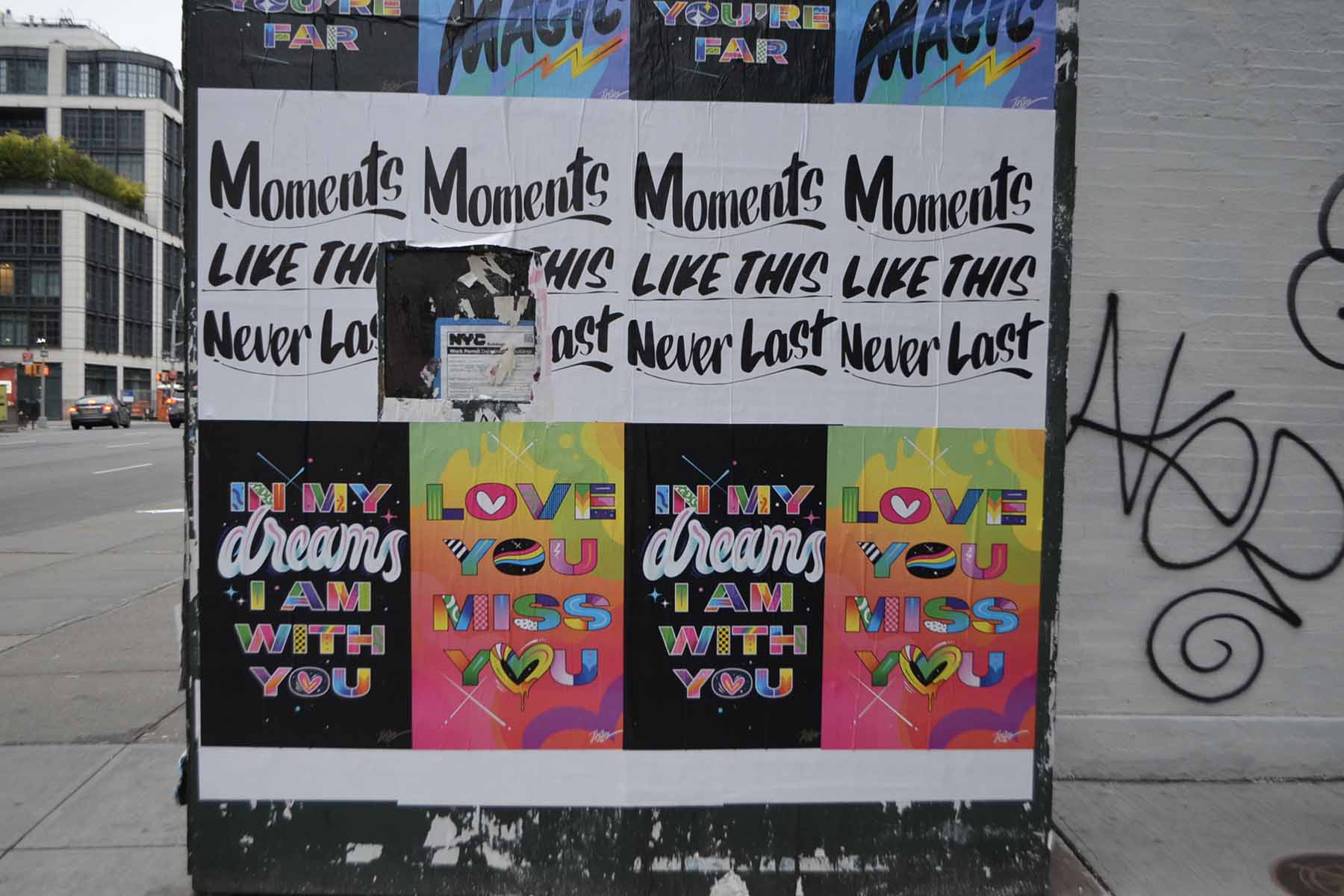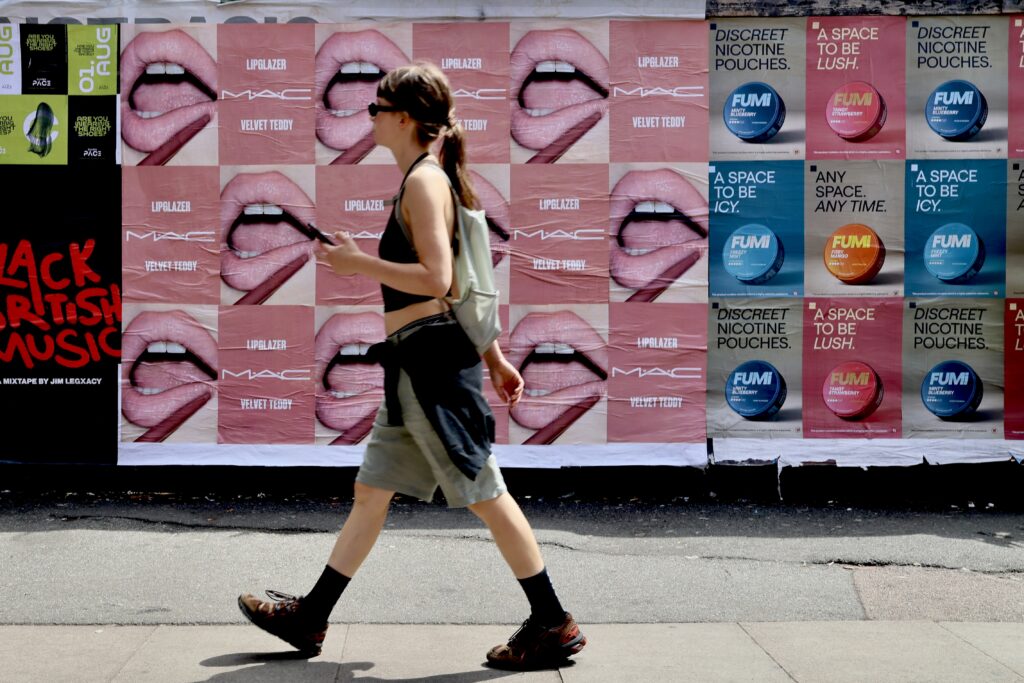
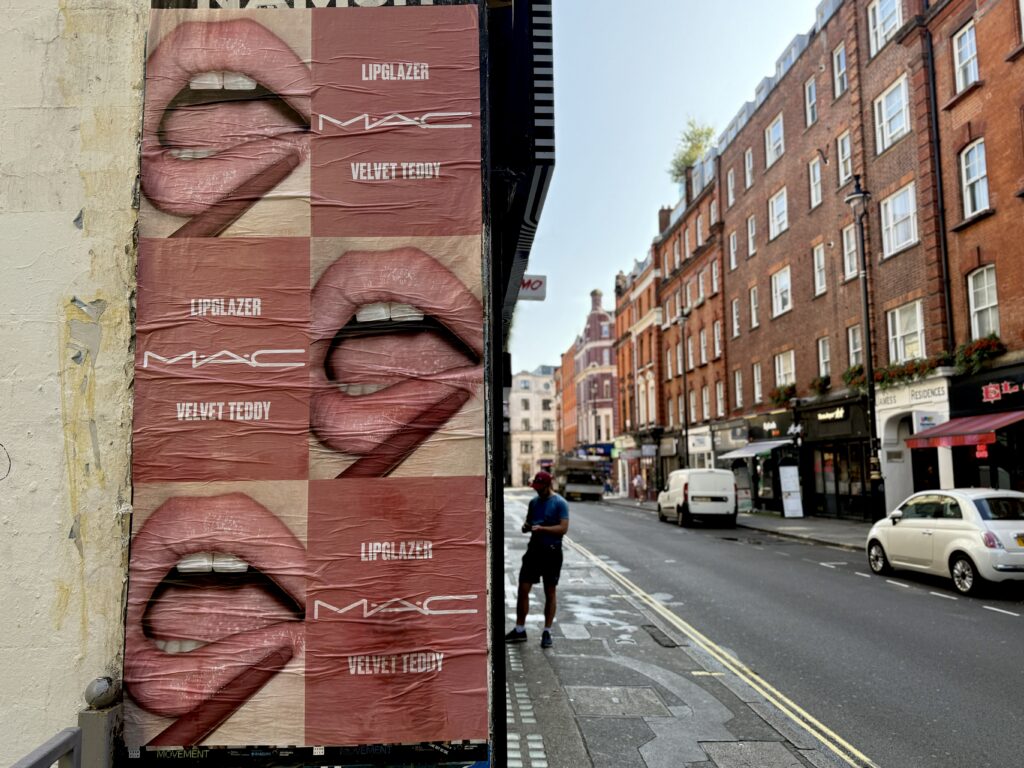

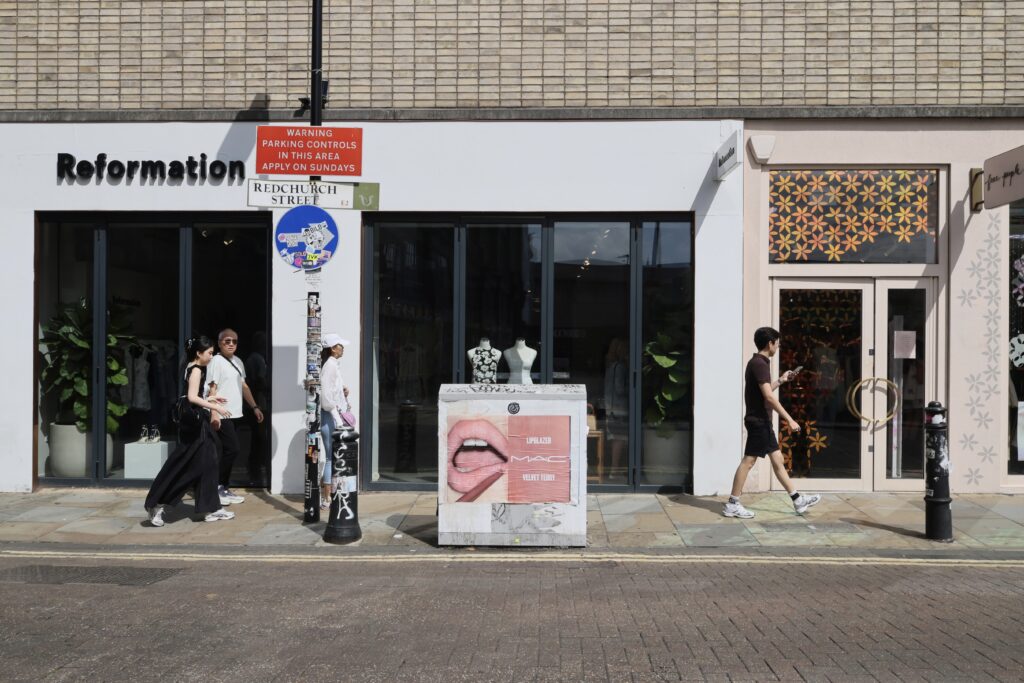
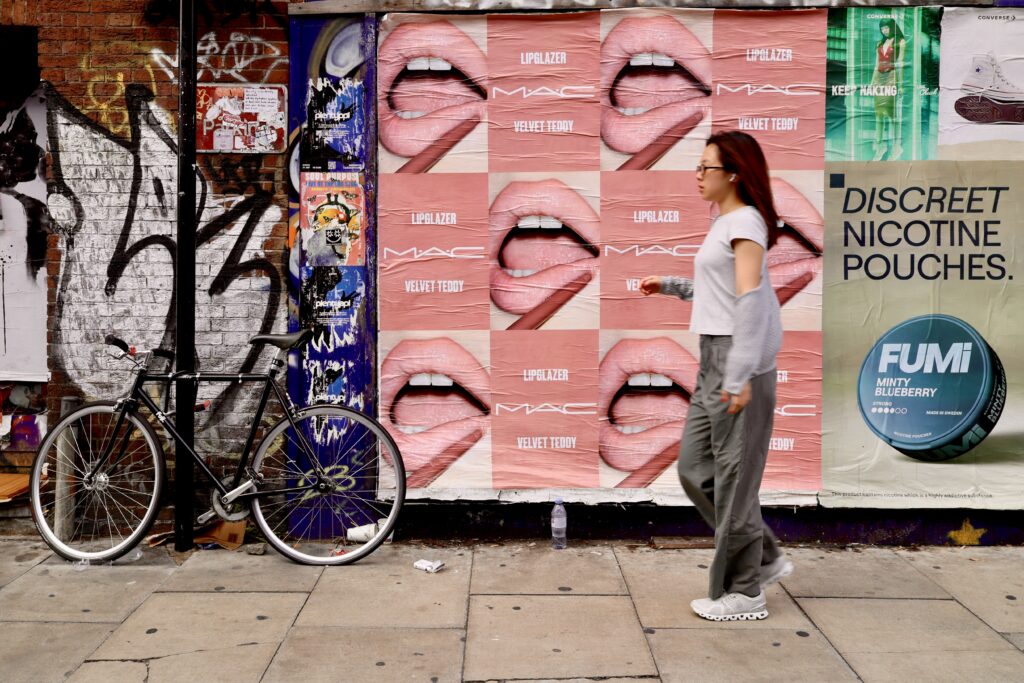
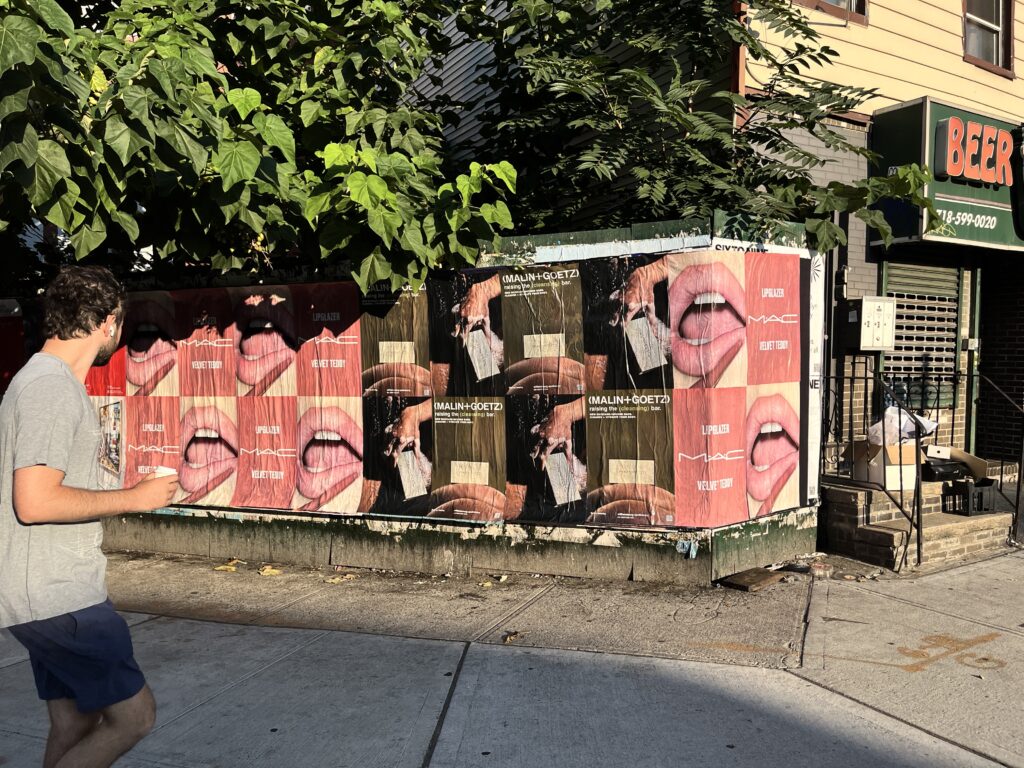
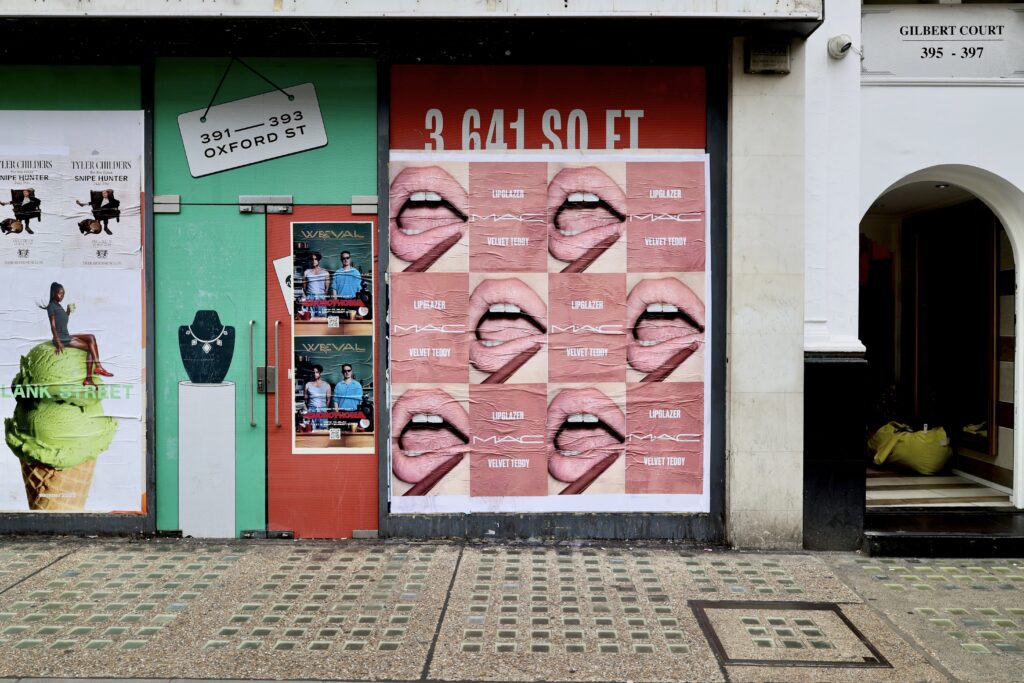









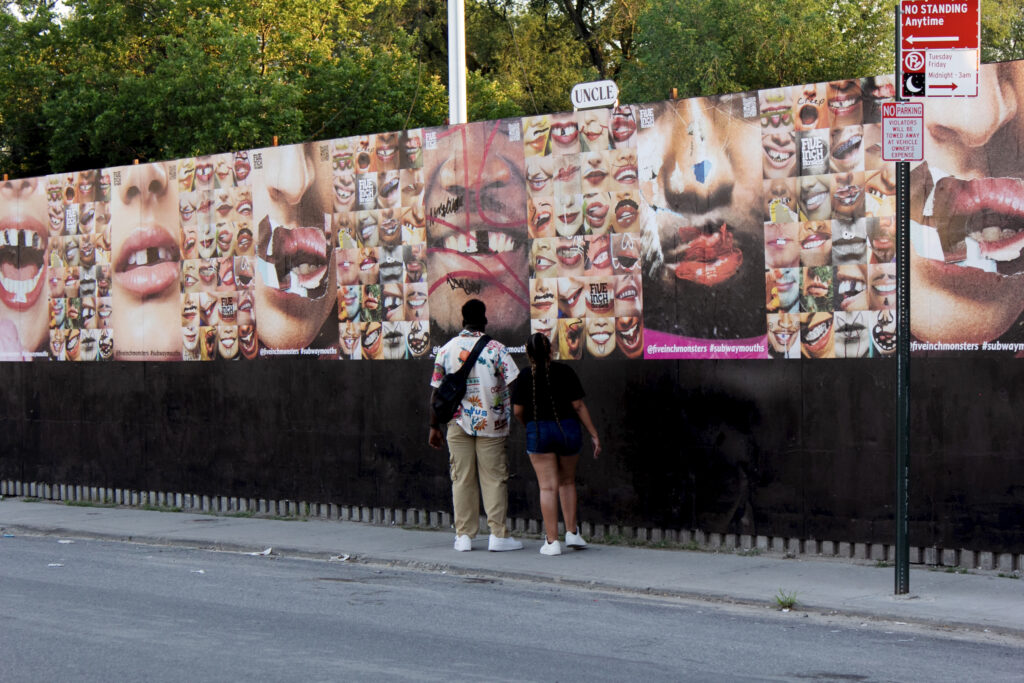
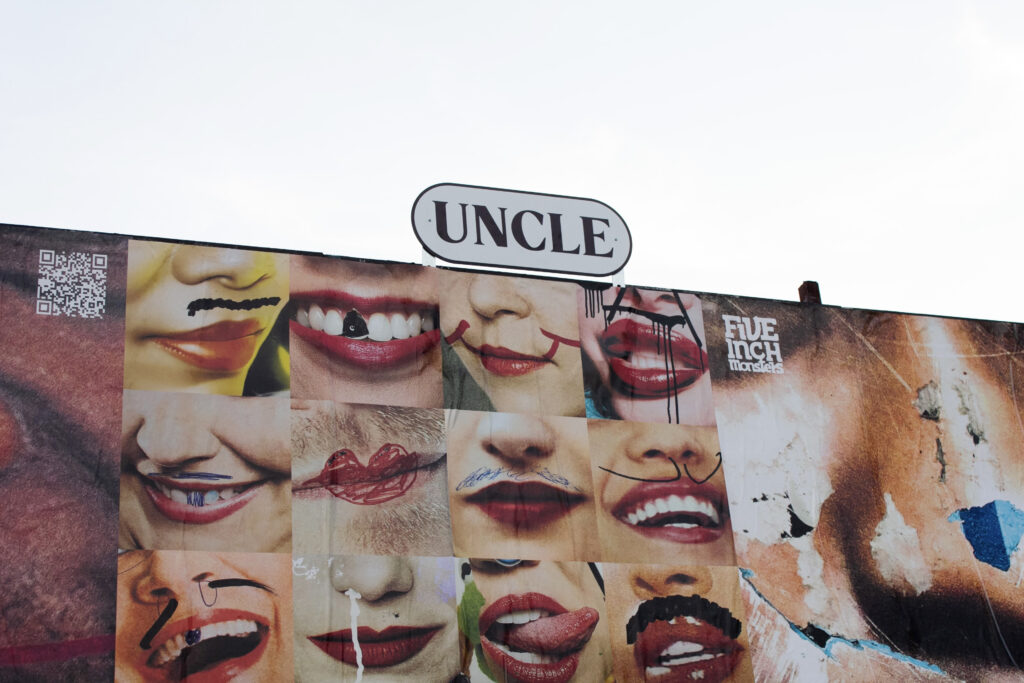

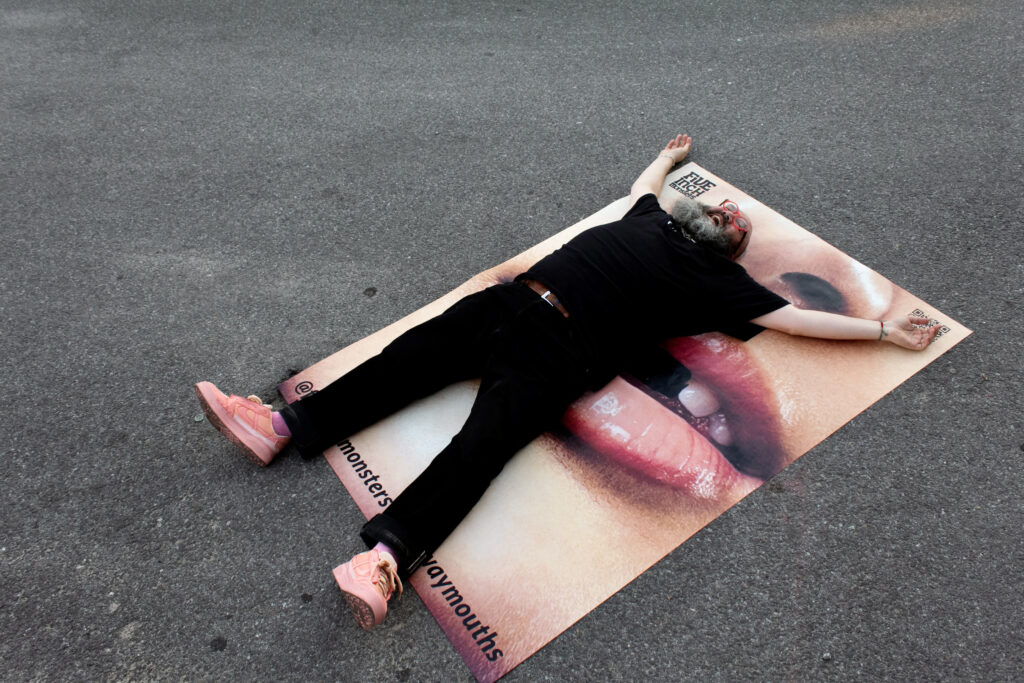
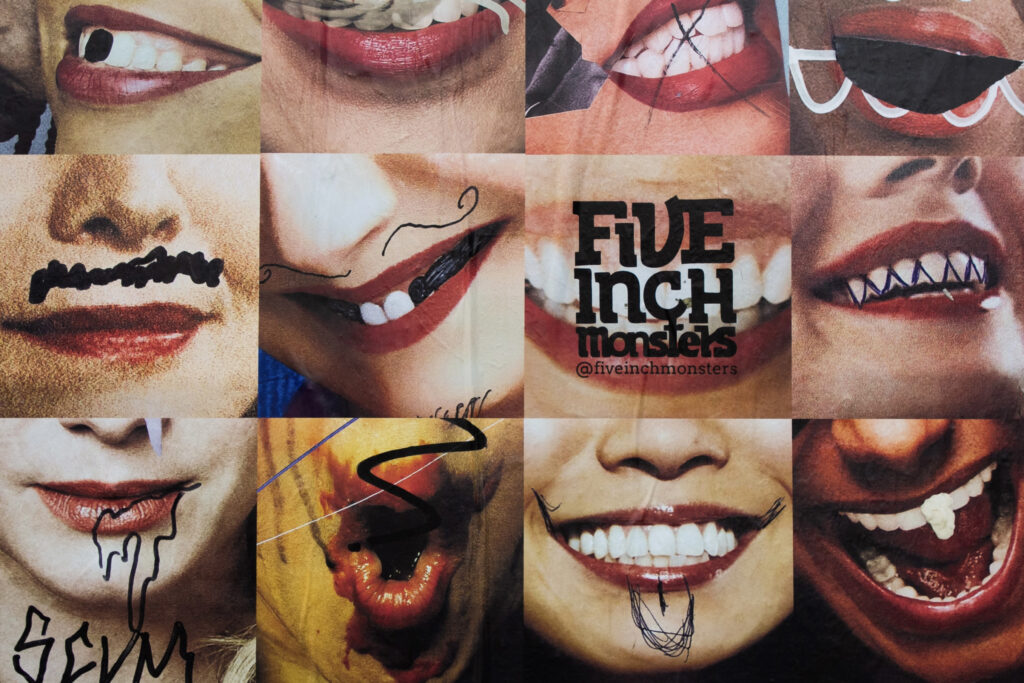
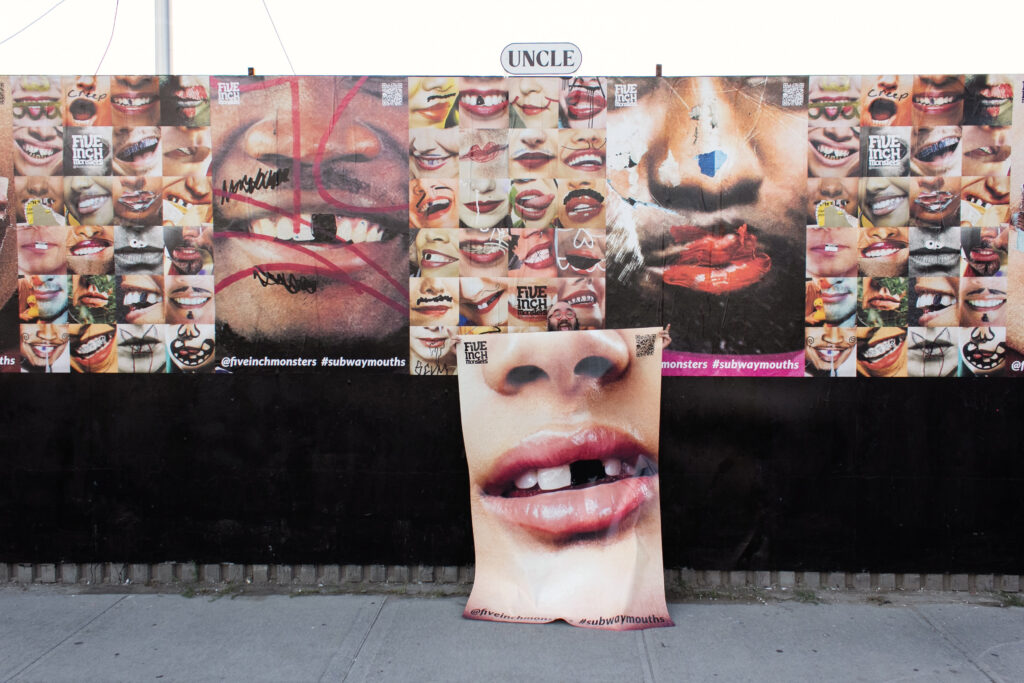
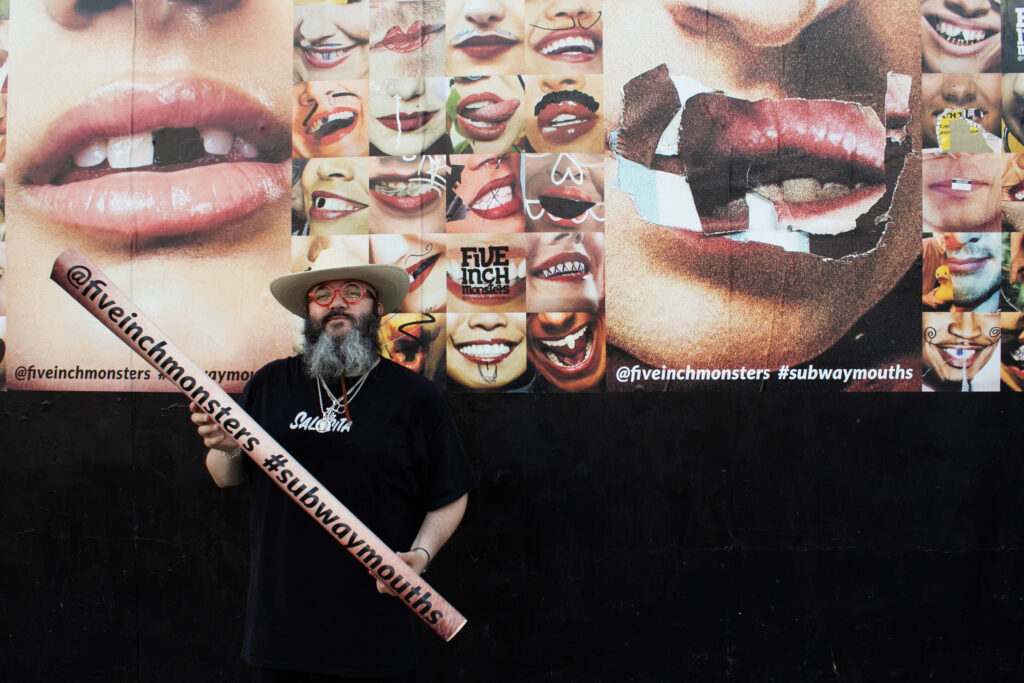
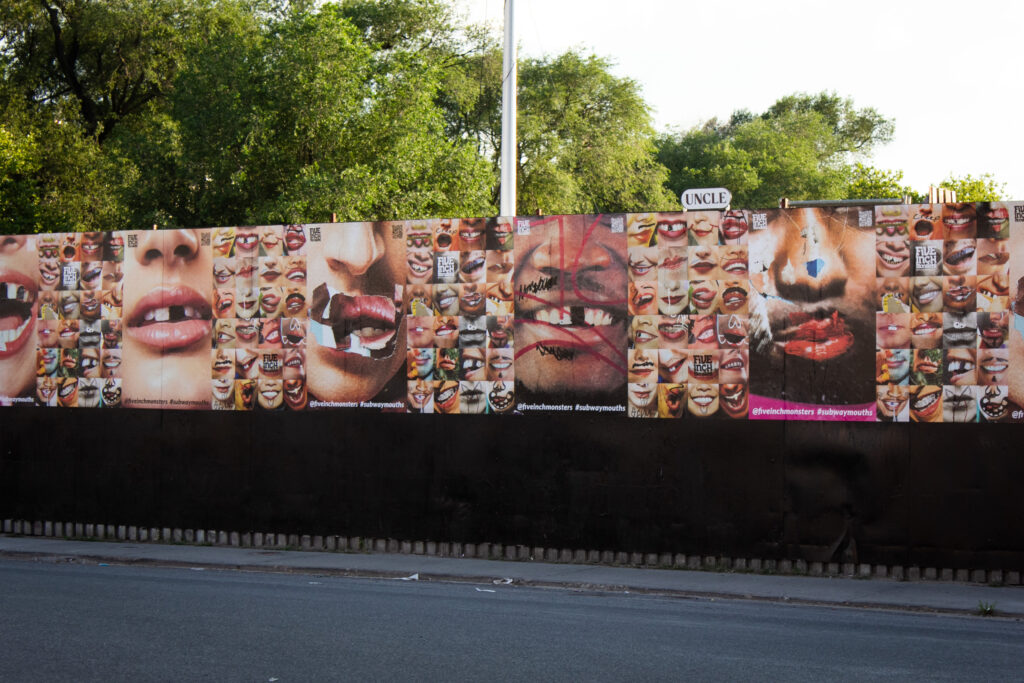
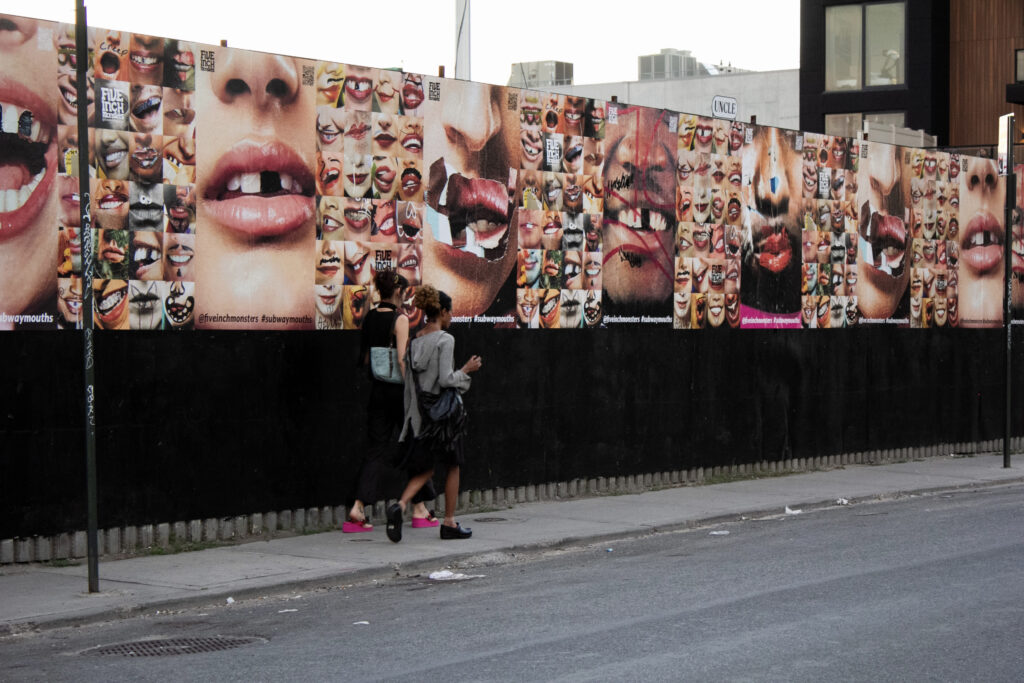
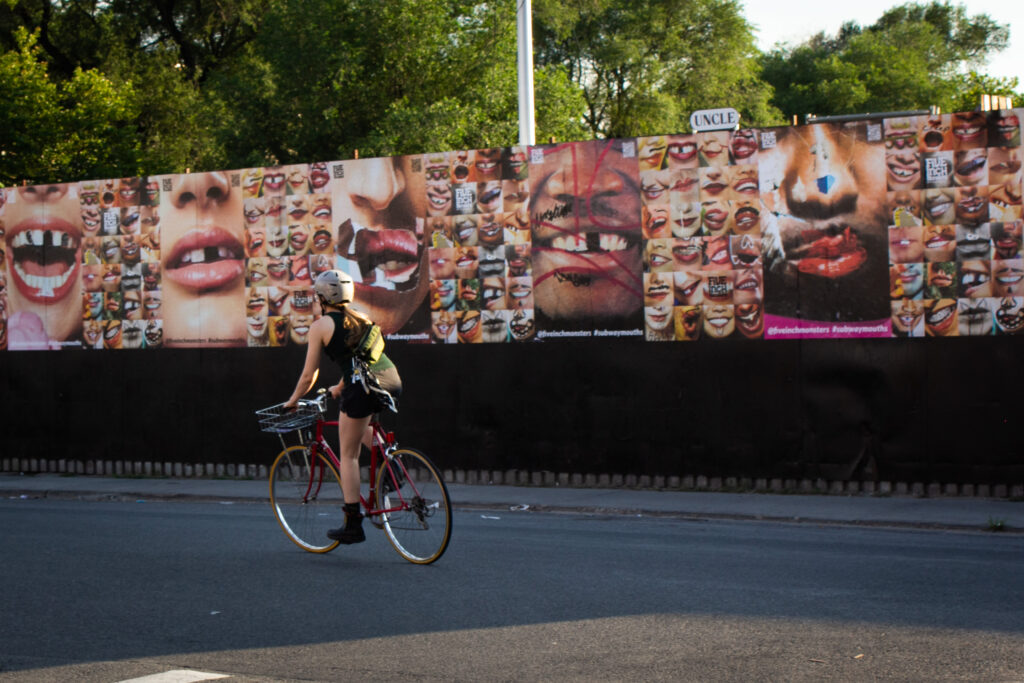
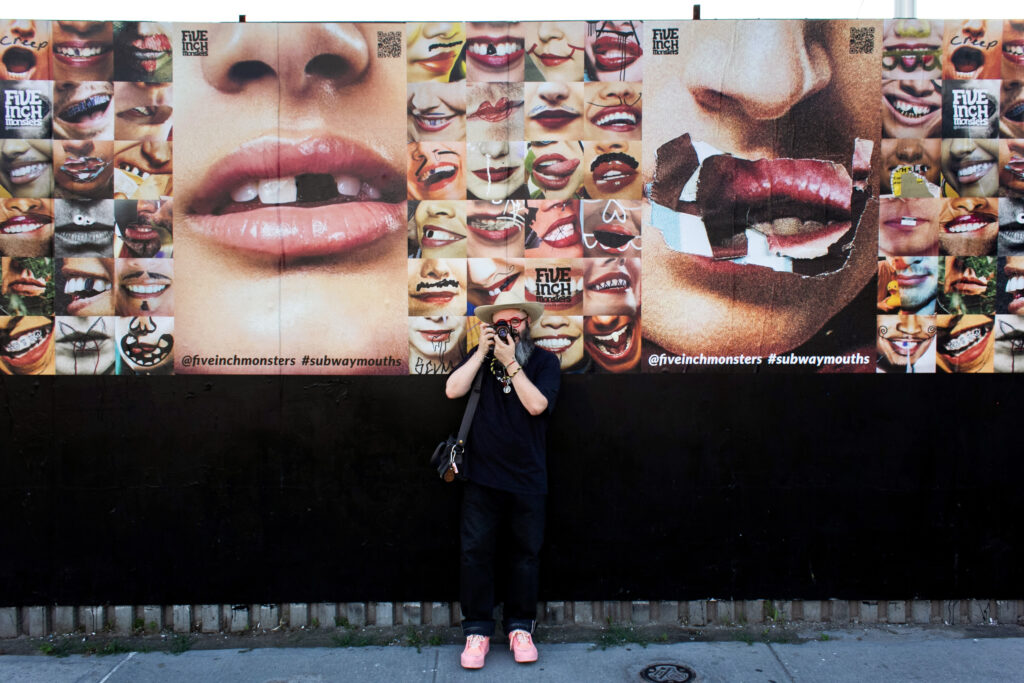
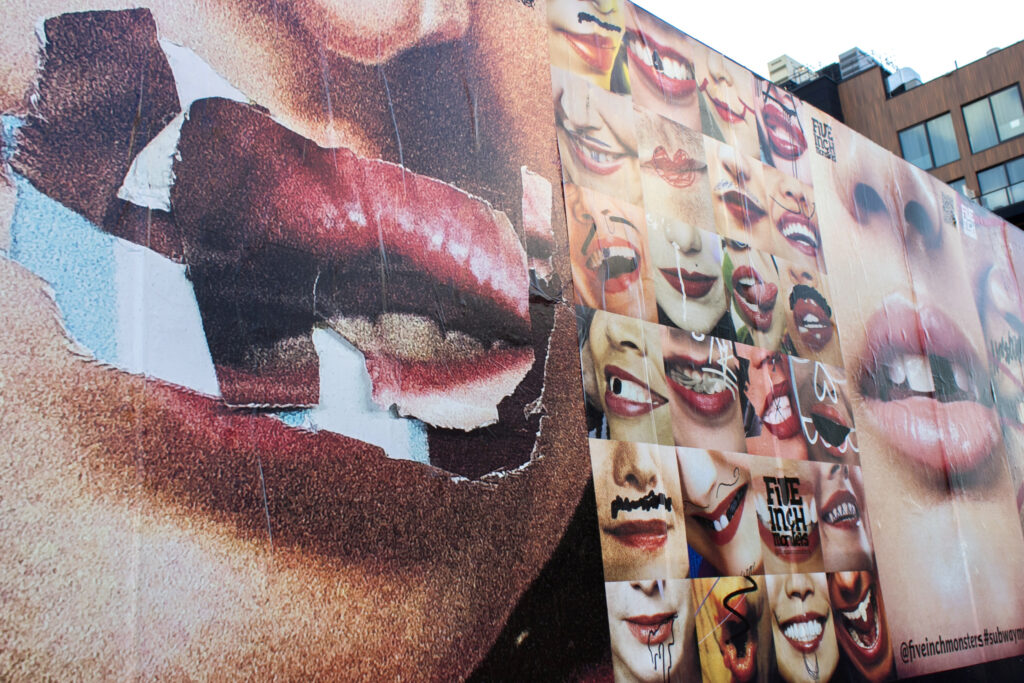

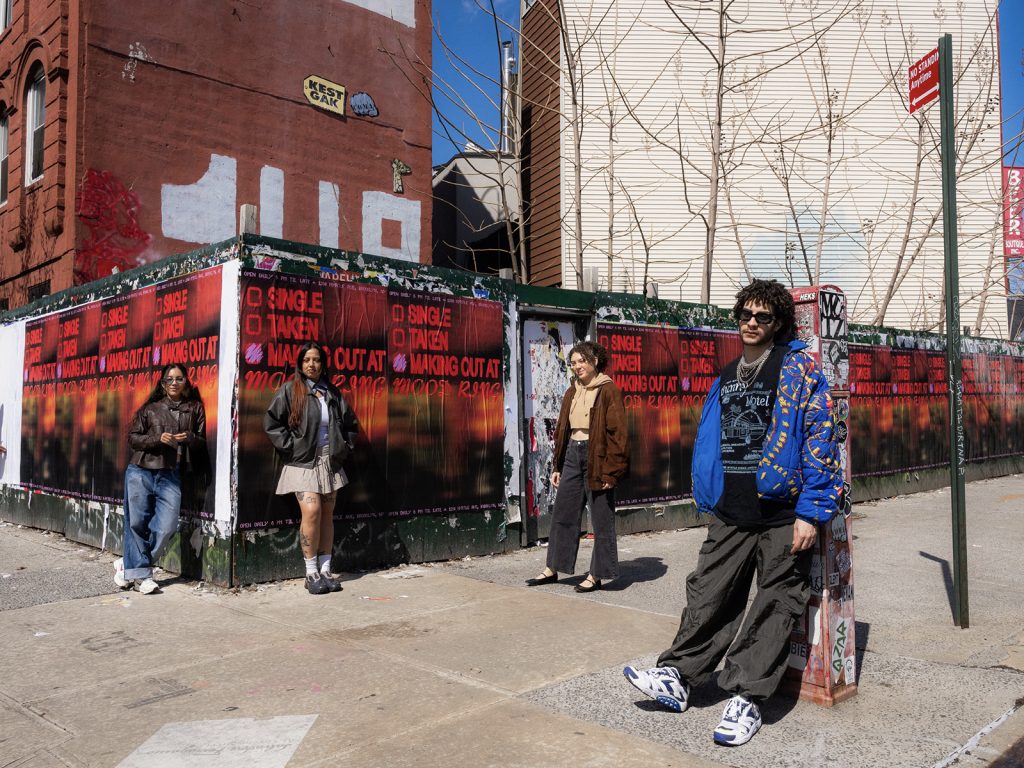
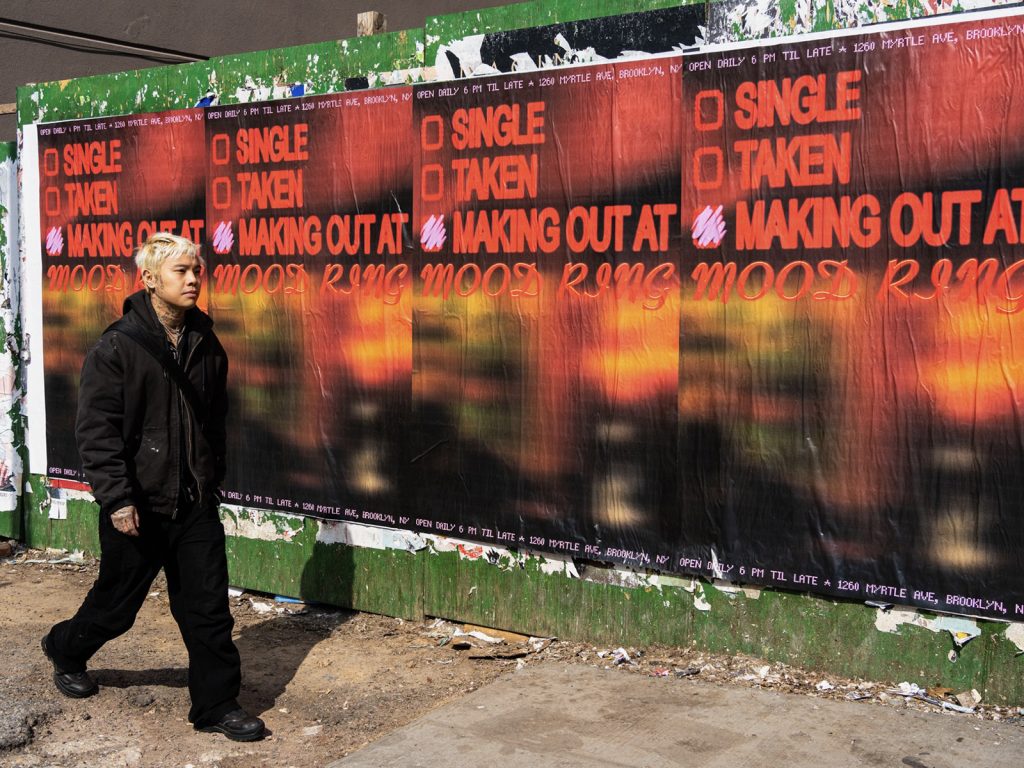
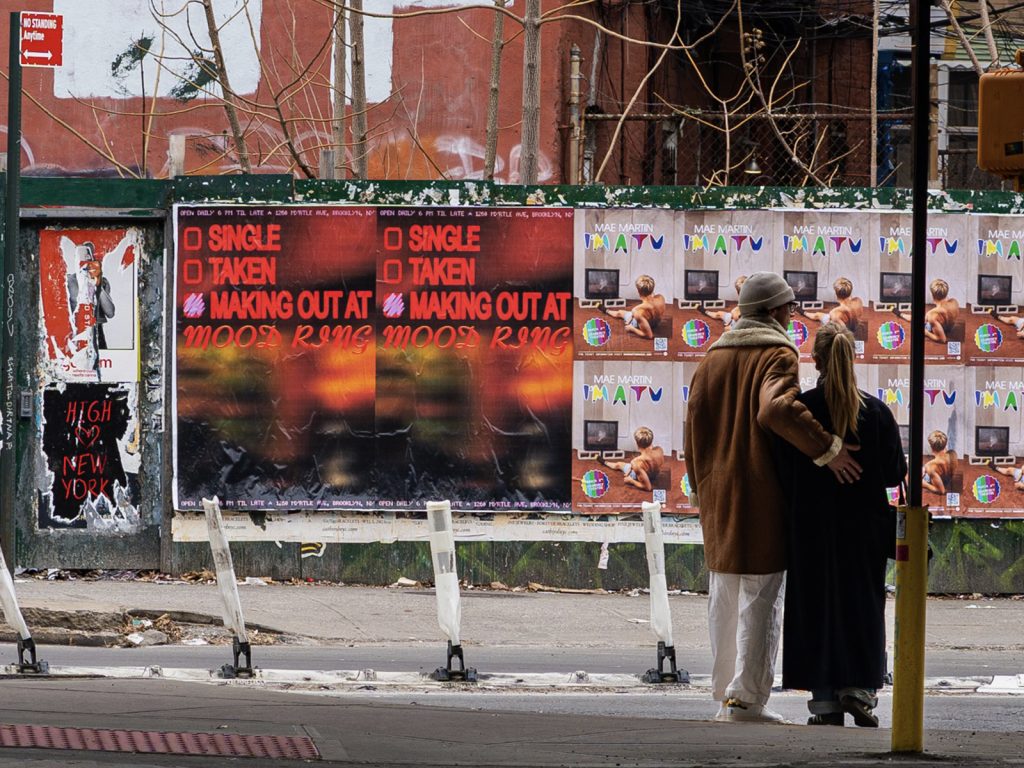
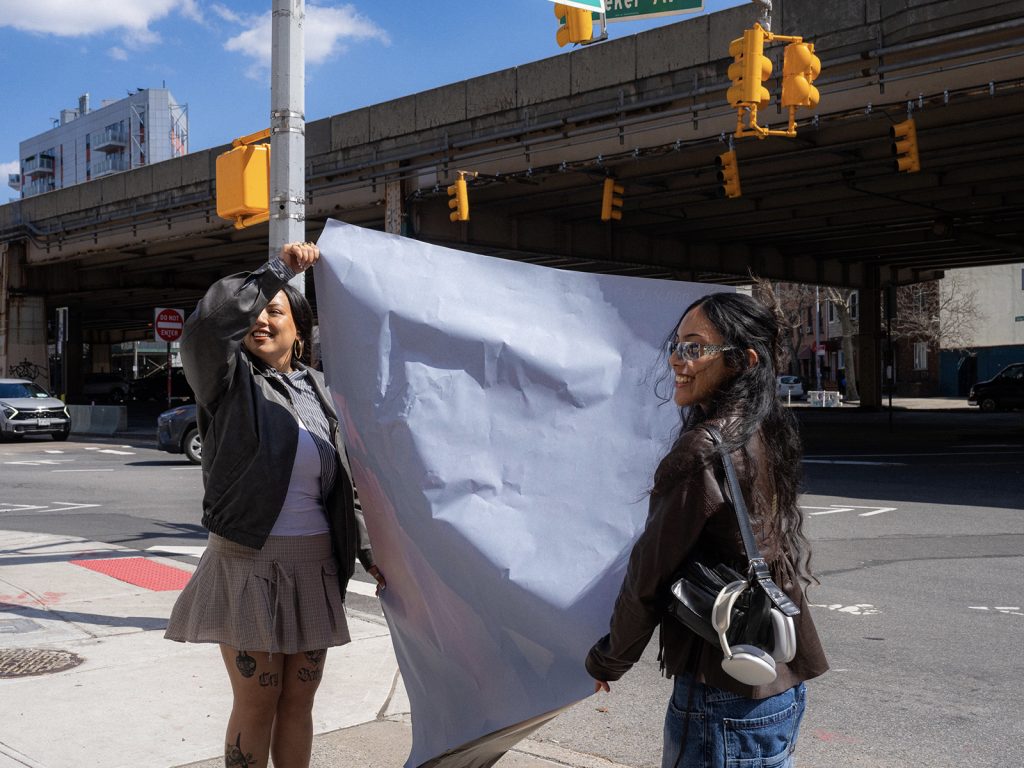
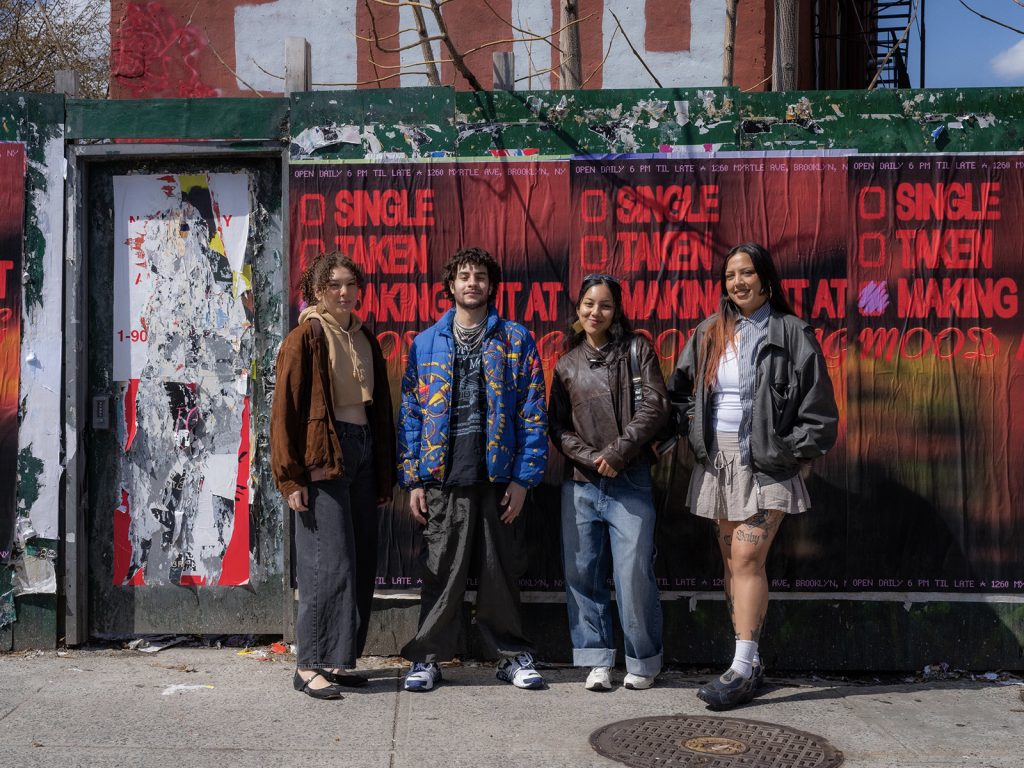
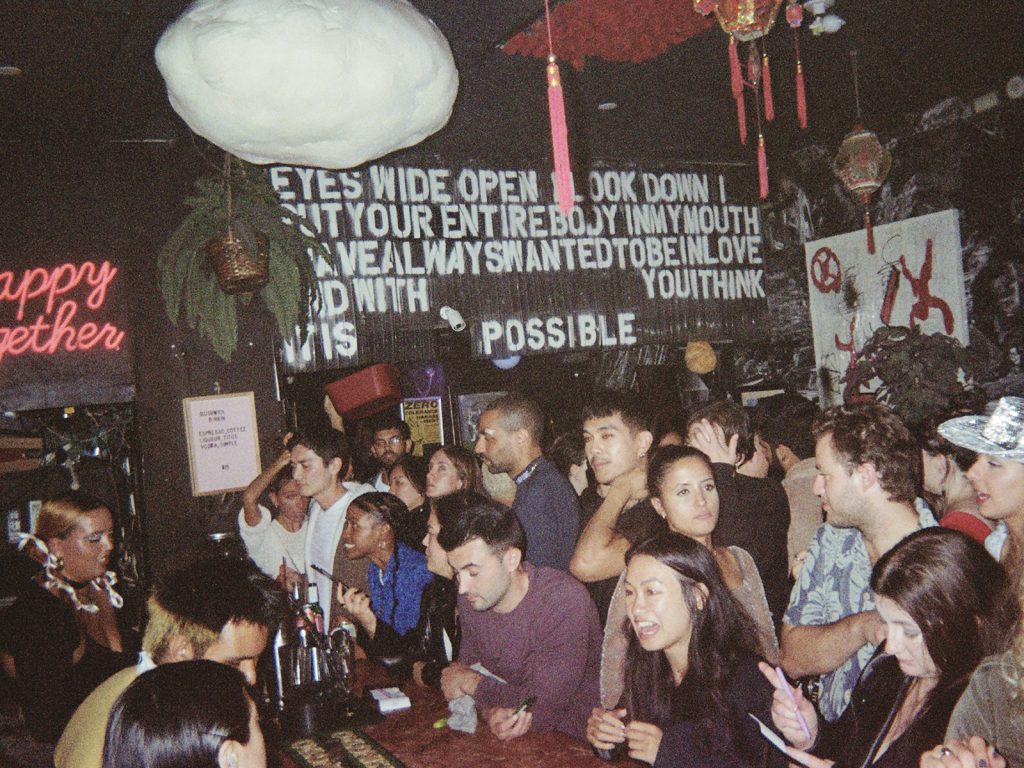


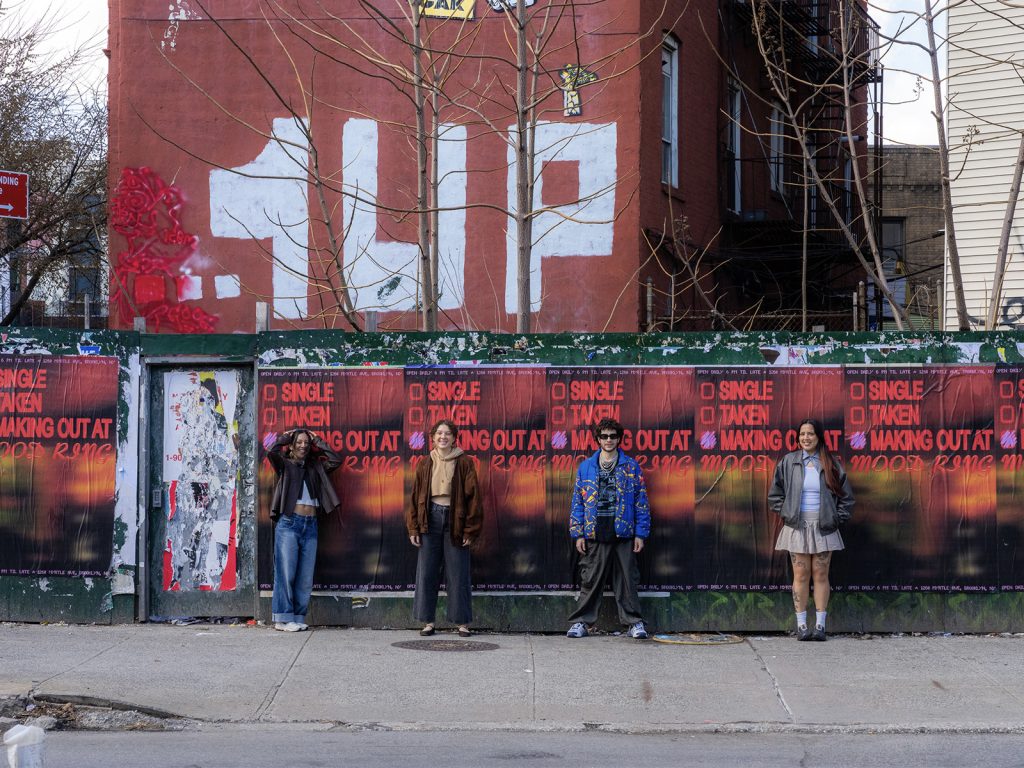
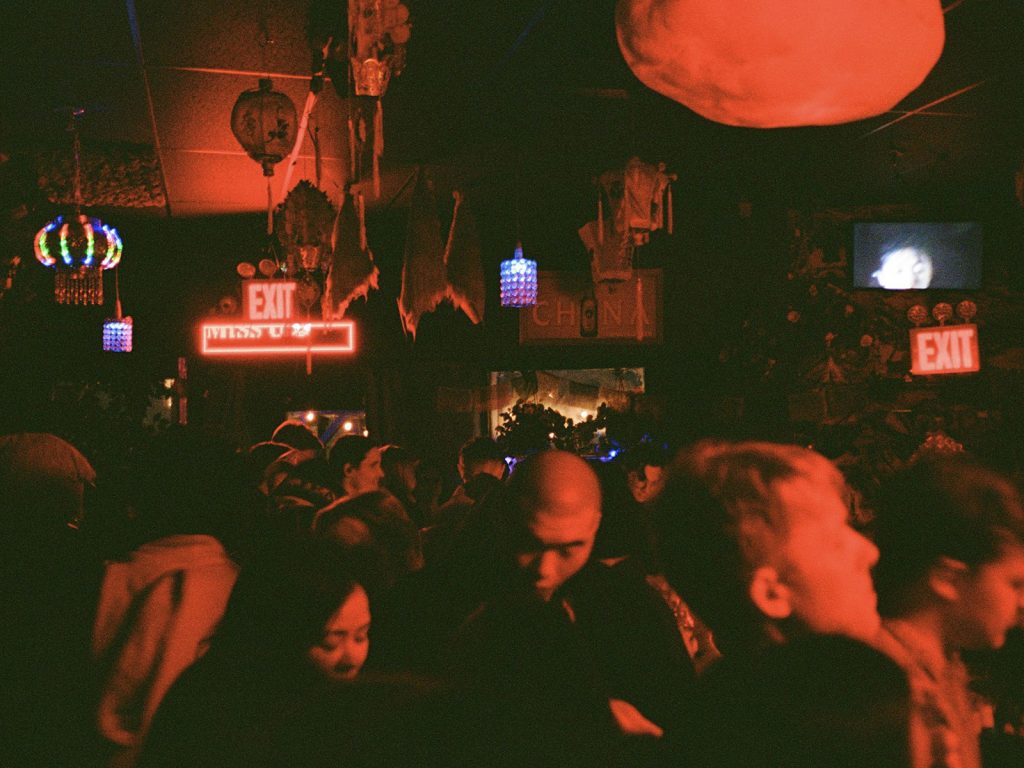
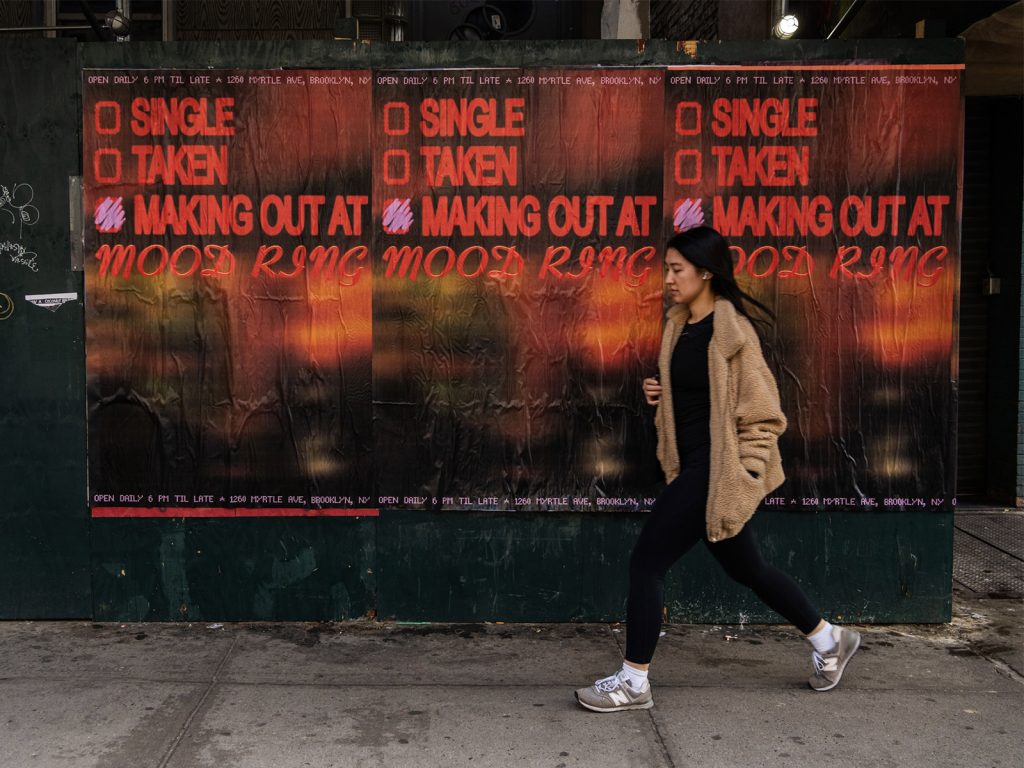

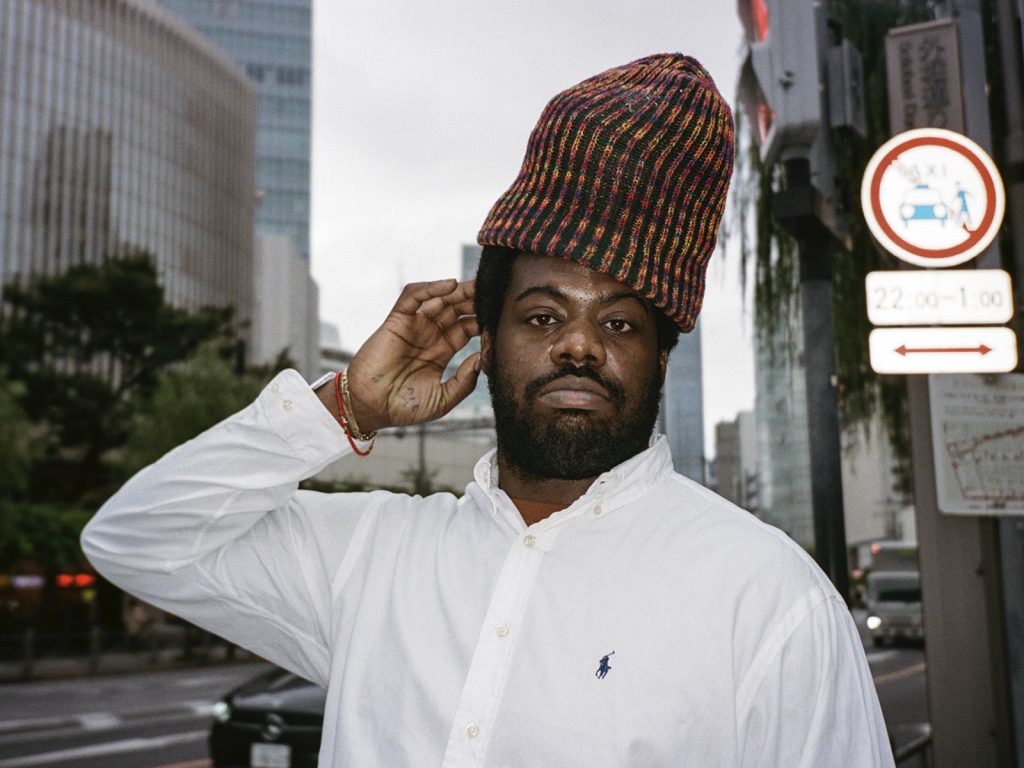

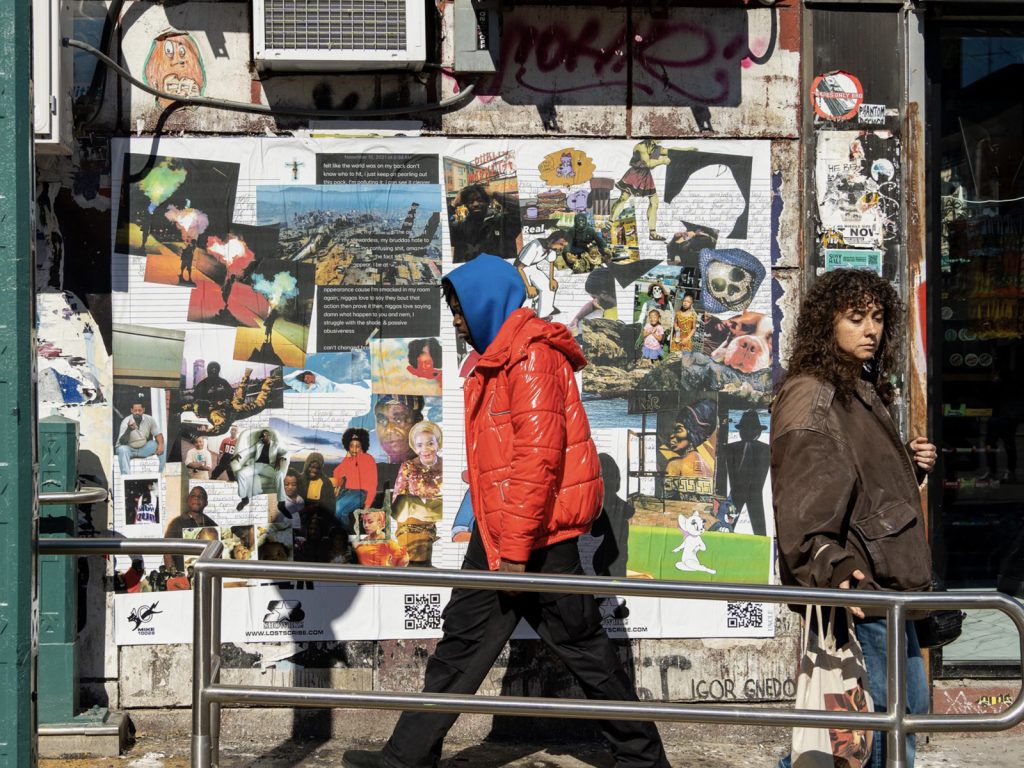
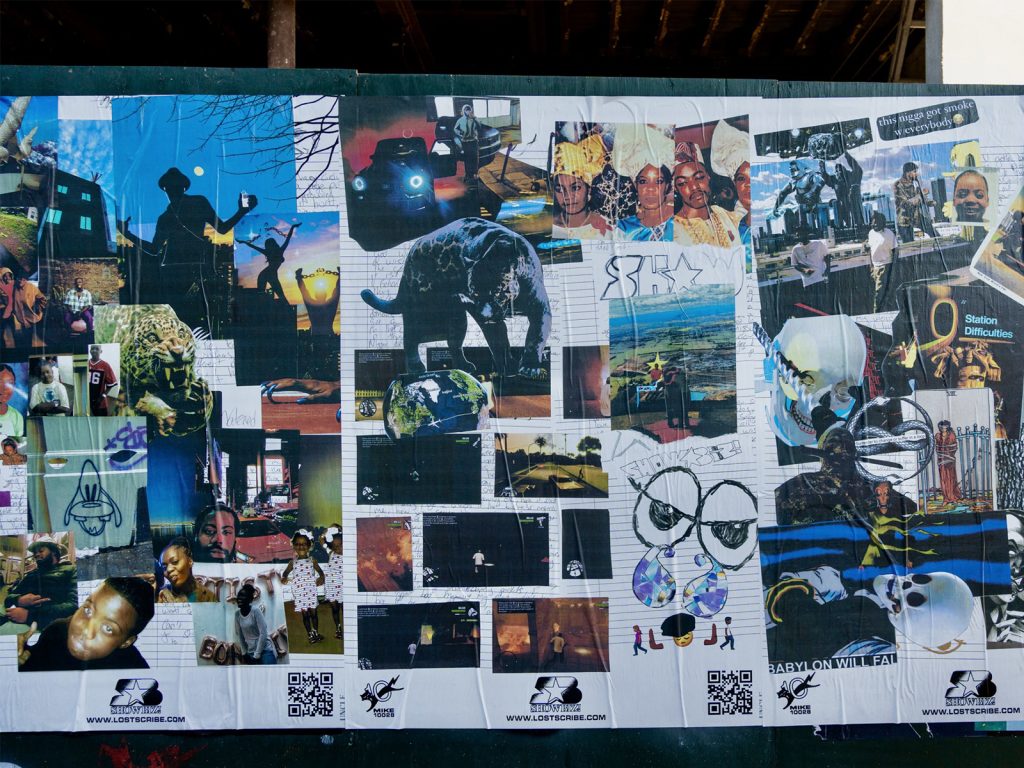
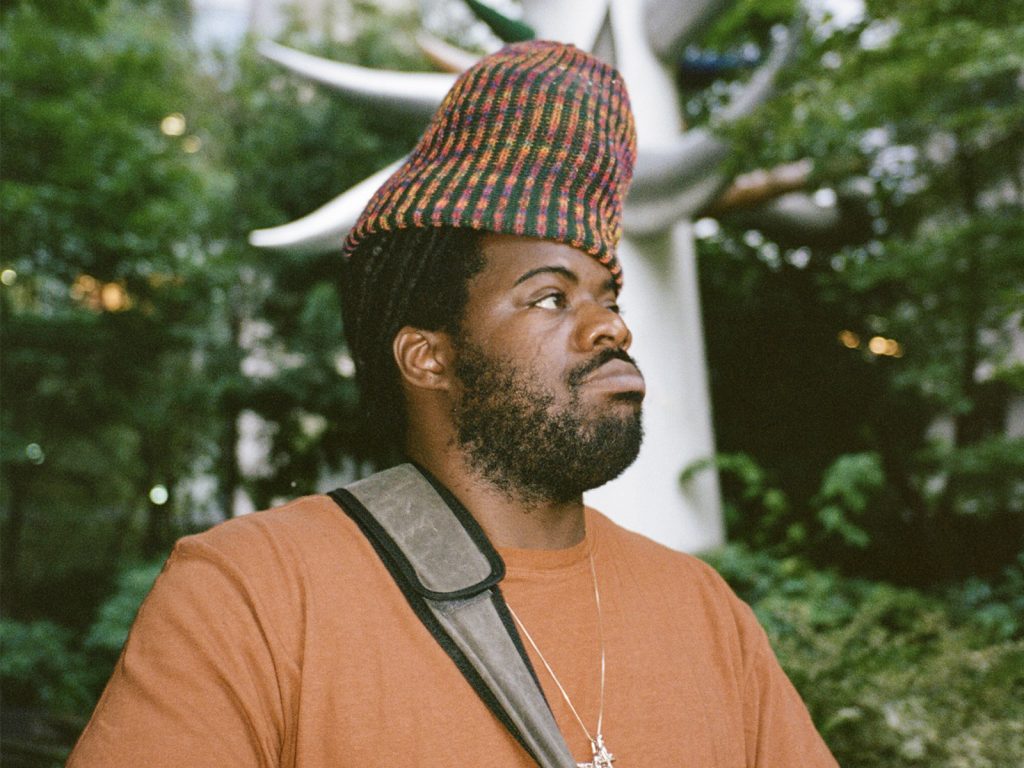
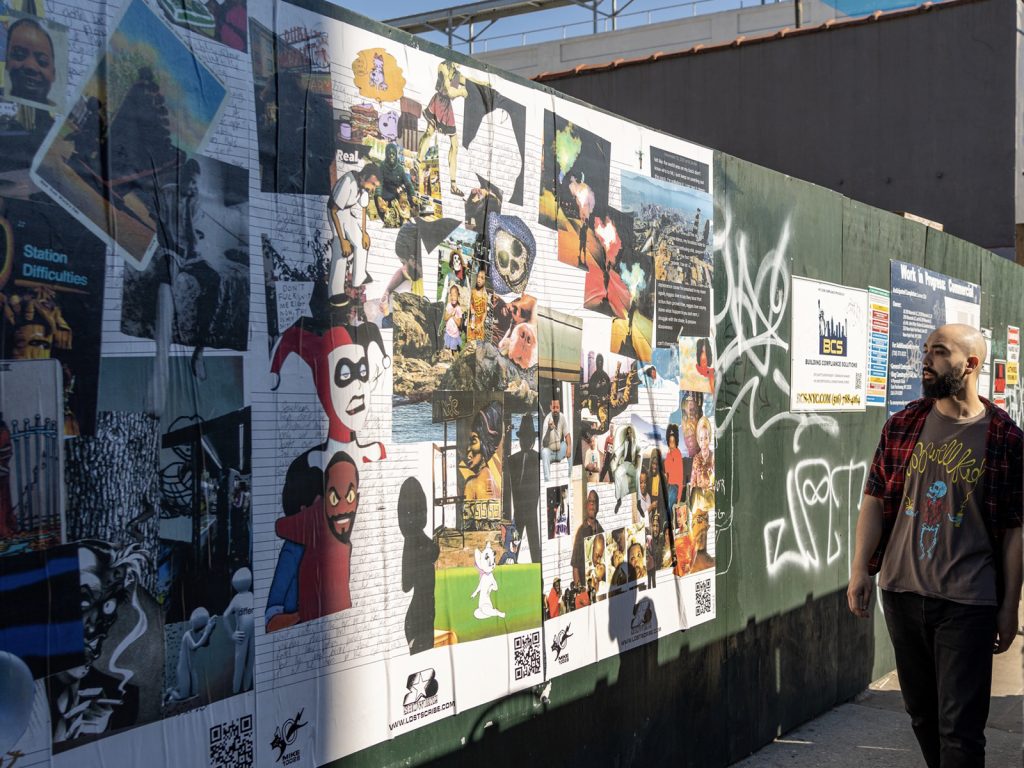
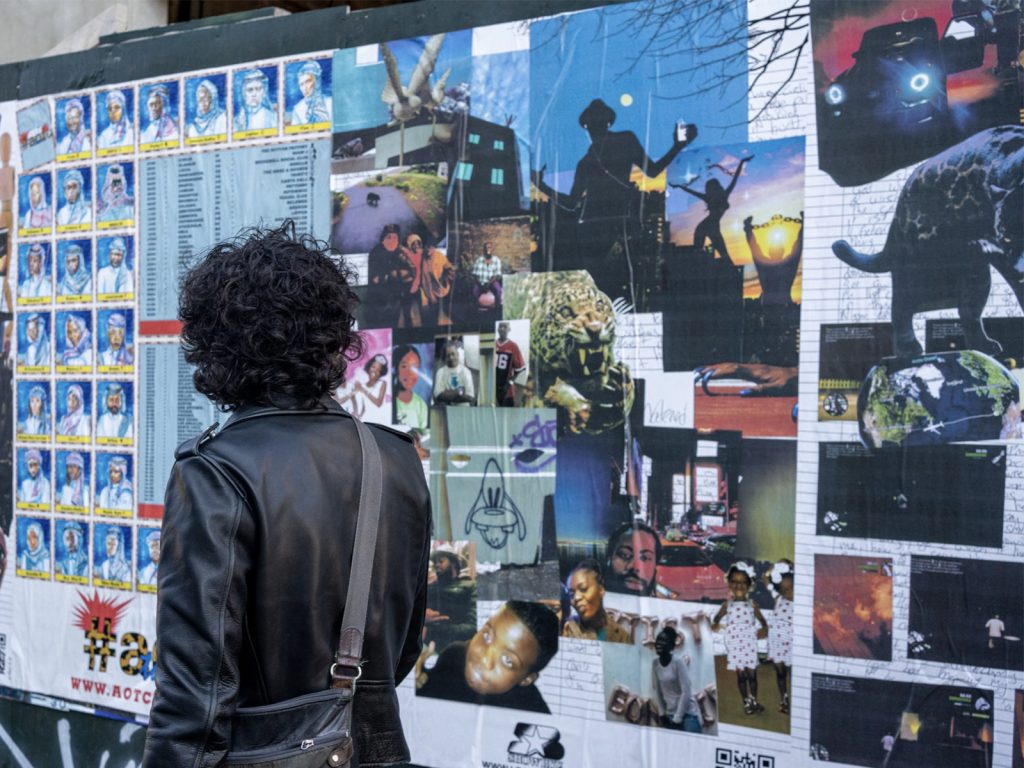
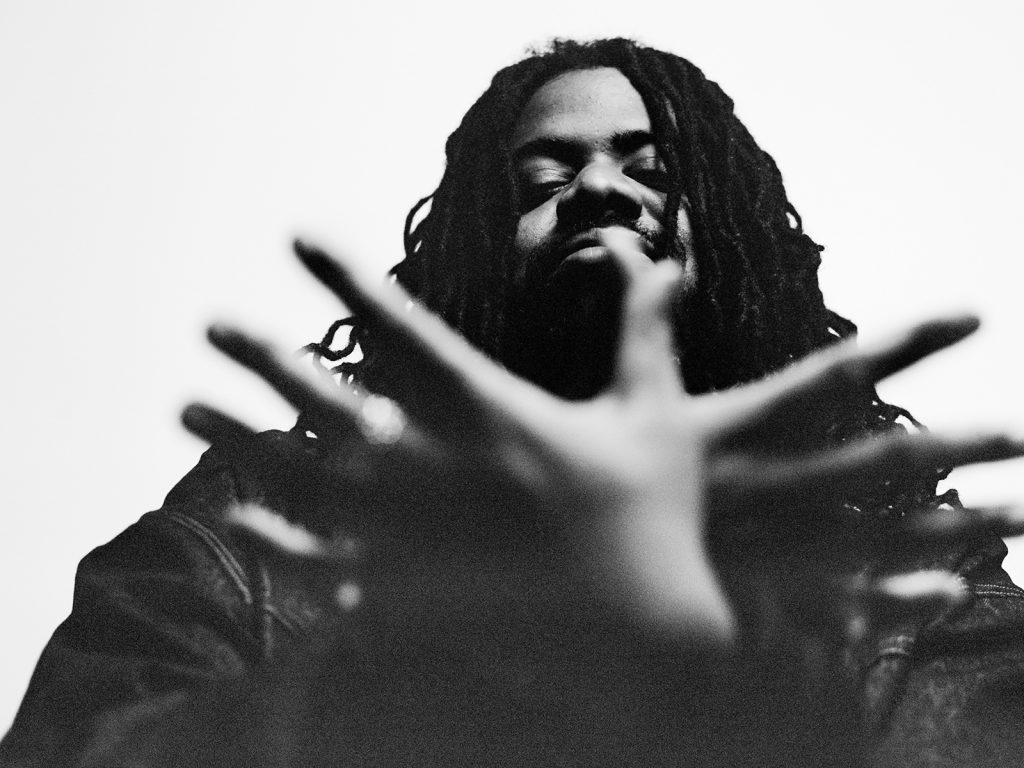
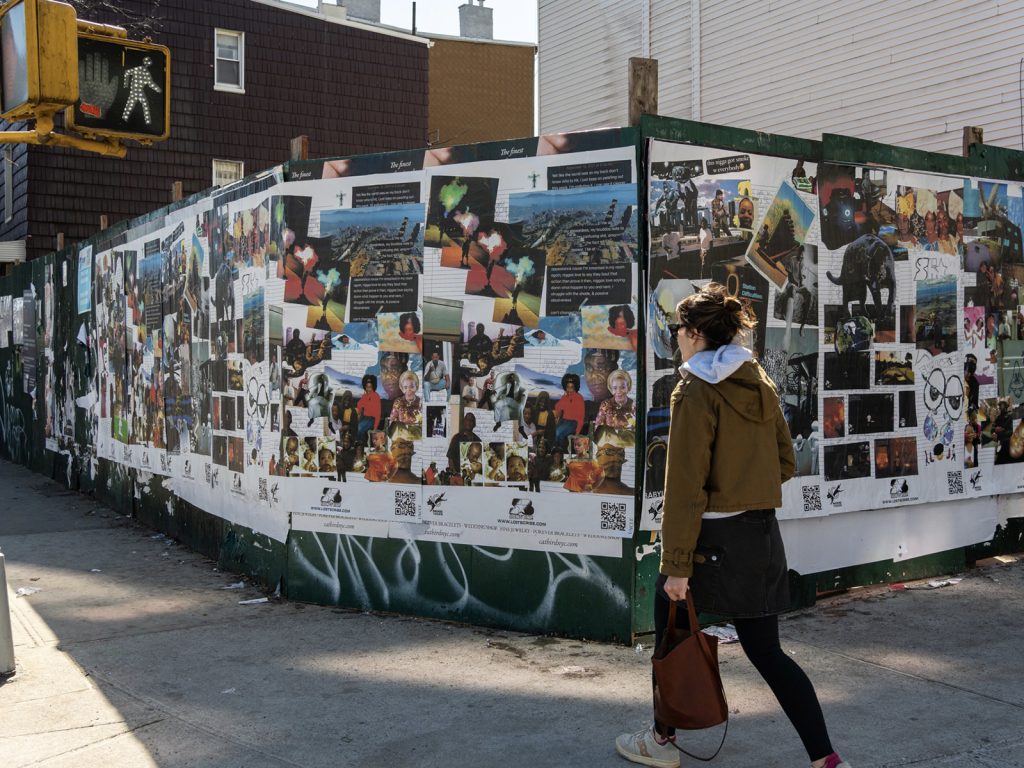
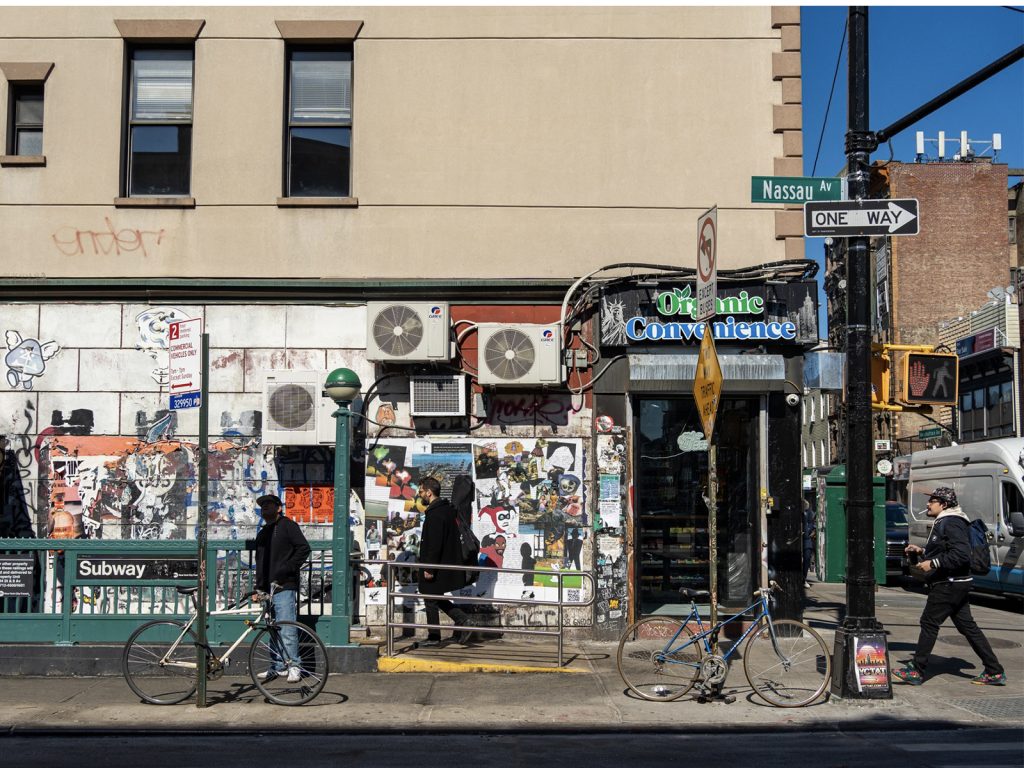

“This mattered. This deserves to be remembered.”
That’s part of the ethos of Queens-raised, Brooklyn-based artist Emily Manwaring. Her paintings and sculptures capture moments, memories, and joy – like a shared camera roll for New York’s Caribbean community. From busy dancefloors to self-care in solitude, from Haitian Tap Tap buses to the changing streets of the Brooklyn, Manwaring collects hundreds of references for each piece she lovingly curates: smartphone photos, items found on the streets of her Flatbush neighbourhood, flyers for dancehall raves from yesteryear, and jewellery lost and found at Carnival.
Her work – both finished and in progress – is the backdrop of our interview as she chats from her apartment during New York’s bleak mid-winter. The art warms the scene, combining brushstrokes, dyed canvases, and real-life artefacts to create something transformative: future artefacts, archives of culture that, in her own words, “hasn’t been preserved or remembered in the ways it deserves to be.”
This approach is evident in works like ‘SoUNd Bath’, where two women bask in sunlight and sound, a pink iPod Nano by their side as they share headphones. It’s a scene as intimate as it is universal – a snapshot of quiet joy shared between friends. For Manwaring, these moments of closeness, especially among women, are at the heart of her art. Her early fascination with family photo albums – frozen frames of love and connection – inspired her to honour these relationships on a larger scale.
Inspiration has also come from artists like Kerry James Marshall and Jordan Casteel, both of whom showed her how identity could take up space on a gallery wall. But Manwaring’s early experiences in Queens were equally formative. With limited access to the arts in her hometown, she would often cut school to visit galleries in Brooklyn or Manhattan. Those trips, along with her time working at the Studio Museum in Harlem, taught her to value art as a form of storytelling and preservation.
Manwaring’s work has been featured in prominent galleries such as Thierry Goldberg, Great Hall Gallery, Swivel Gallery, and Monti 8 in Italy. She’s also received critical acclaim in publications like The New Yorker, JUXTAPOZ, Artnet, and It’s Nice That. Most recently, she was selected to exhibit in the Brooklyn Museum’s Brooklyn Artists Exhibition – a significant milestone that cements her place among the city’s most exciting emerging artists.
Yet her work is not confined to galleries or institutions – if anything, the idea of having it on the streets excites her more. Her art thrives in public spaces, where it can directly connect with the communities it reflects.
Her collaboration with UNCLE brings her Back 2 Life project to these public spaces. Inspired by dancehall flyers’ bold colours and compositions, this work reimagines those designs at a monumental scale. “I’m imagining an auntie walking past one of my wild posters and seeing herself in it,” Manwaring says.
Archiving moments and shared memories, her art takes up space where it matters most – on the streets, where stories of joy can be celebrated by the people they belong to.
HOW DO YOU APPROACH A NEW PROJECT OR IDEA? COULD YOU WALK US THROUGH YOUR CREATIVE PROCESS, FROM INITIAL INSPIRATION TO THE FINAL PIECE?
It often starts with a memory – a specific moment that sticks with me—and I begin thinking about how I want to bring that to life. From there, I map out the composition, especially if I’m working with a square canvas. I’ll think about what’s happening in each corner, what’s coming out of the frame, and how the shapes will work together. Sometimes I break the frame entirely and explore how to present the work in a completely different way.
I use a folder filled with references – hundreds of photos for a single painting. It might be a colour I noticed on the street, the texture of a feather on the pavement, or the way jewellery sparkles. I also take my own reference images, which might capture a pose, an outfit, or the way light hits a certain surface. All of these pieces come together to create something cohesive – a sort of amalgamation of all these little inspirations.
I also think a lot about 3D elements. What can pop out of the canvas? How can I ground the viewer in the world I’m creating?
TELL US ABOUT THE ROLE OF MATERIAL AND THESE 3D ELEMENTS IN YOUR WORK… HOW DO YOU CHOOSE THEM?
My boyfriend and I are always collecting things we find on the street – flyers, objects, anything that feels like it could spark inspiration. Those materials sometimes end up in my work, and I love the idea that they bring a piece of the world into what I’m creating.
Materiality is so important to me because it bridges the world I’m creating in my art with the real, tangible world around us. When I include objects like a bracelet, a necklace, or even concrete, they act as grounding techniques. These elements bring familiarity – they make people stop and think, “I know that; I’ve worn that; I’ve seen that before.” It draws them into the piece, helping them feel connected to the world I’m portraying.
For example, I did a painting with a hammock, and I used lamps to hold it up. Those lamps weren’t just decorative; they became part of the sculpture, part of the functionality and presentation of the work. It was about making the piece feel alive, like it existed in a space rather than just on a canvas.
WE’VE ALREADY SPOKEN ABOUT JOY AND CARIBBEAN CULTURE, BUT ARE THERE ANY OTHER THEMES THAT ARE CENTRAL TO YOUR WORK?
A lot of my work is centered around women and the interactions we have with each other. It’s about what it means for me to be a woman and the spaces where we find connection, joy, and sanctuary. Those moments of interaction, whether they’re big or small, are something I love to explore through my paintings.
“Back 2 Life” is inspired by flyers for dancehall waves, combining nightlife and visual culture in such a striking way. Could you tell us about the inspiration behind this piece and how it fits into your broader body of work?
Back 2 Life is such a special piece for me because it represents a shift in my practice. It was one of the first times I broke free from the square frame and traditional stretcher bars to really ask myself: What am I trying to say here? The inspiration came from walking around Brooklyn, especially in Flatbush, and seeing all these incredible Jamaican and Caribbean flyers pasted up everywhere.
There’s something about the composition of those flyers – the colours, the faces, the text—that feels so alive and futuristic, even though many of them come from years ago. I started collecting them, building this archive of visuals, and one flyer in particular stood out to me. It became the foundation for Back 2 Life.
The process was just as important as the inspiration. I began by dyeing the canvas, letting the colours bleed and interact with each other naturally. That was like creating a living, breathing base layer. Then I started layering the imagery on top – rendering the figures, adding the vibrant text elements, and blowing up the flyer’s scale to almost command the space it’s in.
What’s exciting about this piece is how interactive it feels. People look at it and ask themselves, “Is this a real event? Should I call the number on the flyer?” It creates a sense of curiosity, almost like the flyer is coming alive again. For me, this work is a way to honour the visual culture of the Caribbean diaspora and to get it back on the streets.
DO YOU SEE PAINTING AS A USEFUL WAY TO ARCHIVE?
I definitely see painting as a form of archiving, especially for Caribbean culture. There’s so much that hasn’t been preserved or remembered in the ways it deserves to be. When I was younger, I’d spend hours looking through my family photo albums and thinking about how to honour those moments in a new way. That’s how I first started painting, by recreating those photos and reflecting on what they meant to me.
Now, my work has grown to include not just personal memories but collective ones too. I’m working on a piece right now that holds objects you’d find during Carnival, like pieces of jewellery or feathers and that’s another way of capturing these moments that are so rich but often fleeting.
For me, painting is about saying, “This mattered. This deserves to be remembered.” It allows me to take fleeting or ordinary moments and transform them into something lasting, something people can look at and connect with for years to come.
WHAT’S BROOKLYN LIKE AS A PLACE TO LIVE AND WORK AS A CREATIVE?
Living in Brooklyn is just amazing. I don’t want to talk too deeply about Flatbush because I don’t want them coming in and gentrifying all my shit. But being here is so special to me, it’s full of Caribbean culture, and it feels like home in every way.
I take what I call grounding walks, where I’ll just go out and photograph anything that inspires me the colours, textures, moments. Brooklyn has so much life and history; you’ll see something on the street that unlocks a memory from years ago, and suddenly, I’ll want to create a whole body of work based on that.
I walk down the street and I’m a reflection of it.
WHO ARE SOME OTHER ARTISTS FROM NEW YORK WE SHOULD KNOW ABOUT?
I have to shout out my boyfriend, Oji Haynes, he’s an all-around artist who works in photography and sculpture. Our home is filled with our creations, and it’s such a unique way to live and collaborate.
I’ve gotta shout out my friends, basically. Tyinghe Fleming who works in photography and Aicha Cherif who works in cinematography, directing and production. What I love about New York is this culture of mutual support, we’re all pushing each other to create and grow.
FAVOURITE PLACE TO SEE ART IN NYC?
MoMA holds a special place in my heart. It was the first major museum I explored as a teenager, often skipping school just to spend hours there. Those early visits shaped my understanding of what art could be.
I also love the galleries in Chelsea, where you can find some of the most inspiring contemporary shows. And of course, the Brooklyn Museum, it’s such a dynamic space that feels connected to the community.
FAVOURITE MUSIC VENUE IN NYC?
Brooklyn Paramount is a standout for me I’ve seen some incredible shows there, like Chief Keef and Cash Cobain. It’s got that real New York energy.
Another favourite is Nowadays, where I’ve danced until the early hours with friends. Those DJ sets mean so much to me, music and dancing are such important parts of my life. Dancing is definitely my love language. If I weren’t a painter, I think I’d be a dancer!
FAVOURITE PLACE TO GET FOOD IN NYC?
I’d have to say Brooklyn. I love Fisherman’s Cove – unfortunately they’re taking it down due to gentrification, but that’s the best ox tail.
Your art belongs in the physical realm, but much of its audience discovers it online. What challenges do you face translating the vibrancy of your work to digital spaces, and how do you approach sharing it on platforms like Instagram?
Instagram is weird, but it’s also necessary. For me, it’s like a LinkedIn now, just a way to connect with people and share what I’m doing. I grew up in the Tumblr era, and I think I still treat Instagram like a blog, posting things that remind me of different moments in my life or my work.
I try to use it as a tool to show my process or highlight parts of my paintings, but it will never compete with seeing the work in person. When someone sees my art online, I hope they feel drawn to come experience it physically because it’s a completely different energy. Social media is useful, but I value real human interactions and the experience of seeing art in real life so much more.
WITH YOUR UPCOMING COLLABORATION INVOLVING WILDPOSTING IN NEW YORK, WHAT EXCITES YOU MOST ABOUT DISPLAYING YOUR ART IN PUBLIC SPACES?
What excites me most is how accessible it is. Art shouldn’t only exist in galleries or fairs, it should be part of the world, on the streets, in places where people actually live their lives. With this project, I’m imagining someone in Flatbush walking past a billboard or a wild poster and seeing themselves in it, seeing their culture reflected back at them.
There’s one scenario that keeps coming to mind – aunties, the elders in our community, walking by and seeing themselves or their stories represented. Maybe it’s someone who hasn’t had the chance to go to a gallery or a museum, but they look at that poster and feel seen. That’s what I love about this format, it’s for everyone.
It’s not locked behind closed doors or dependent on who can afford to visit a gallery. It’s right there for people to engage with, and that feels really powerful. The streets are full of stories, and this is my way of adding to that, of giving something back to the community while connecting with people in a real, direct way.
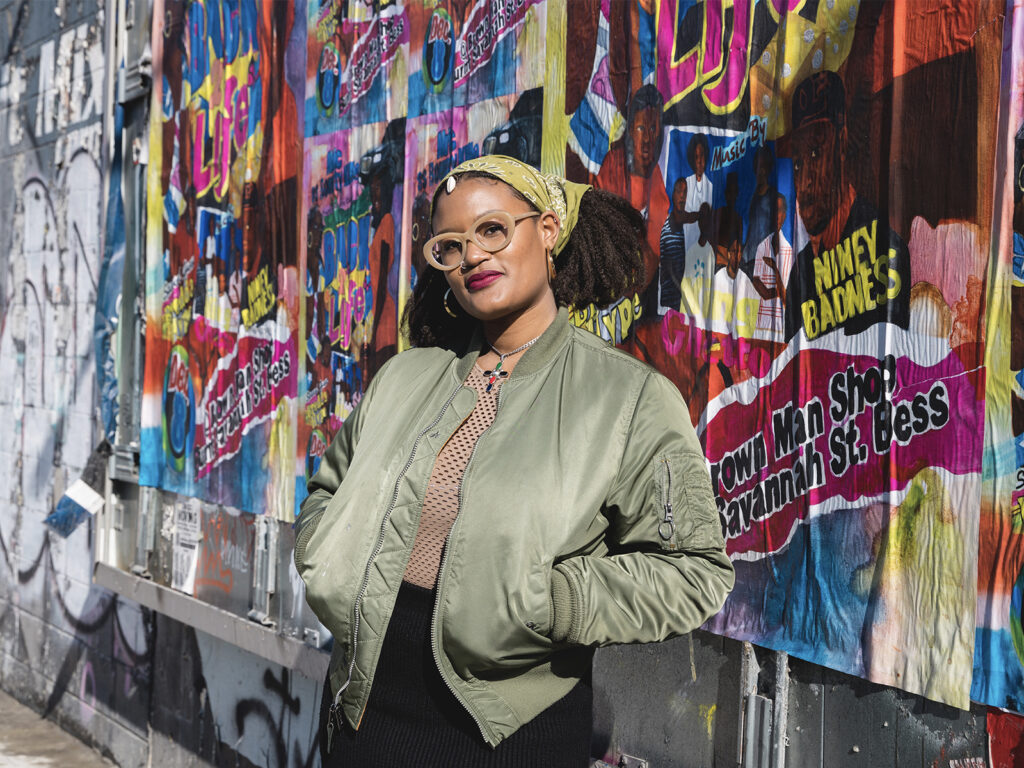
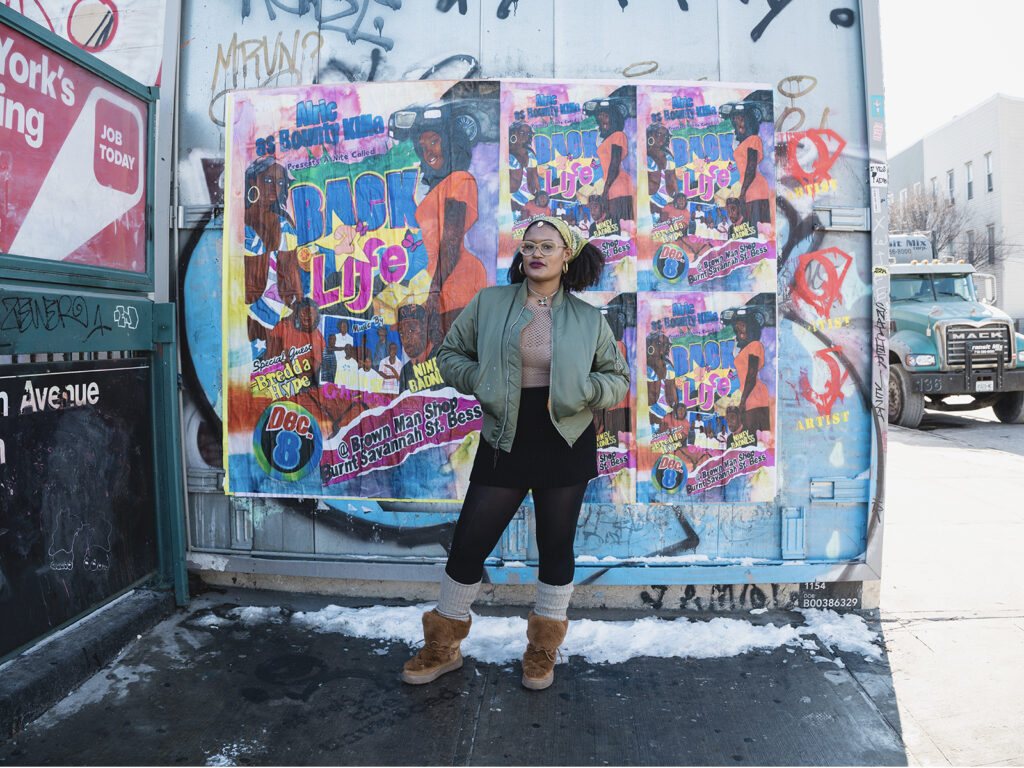

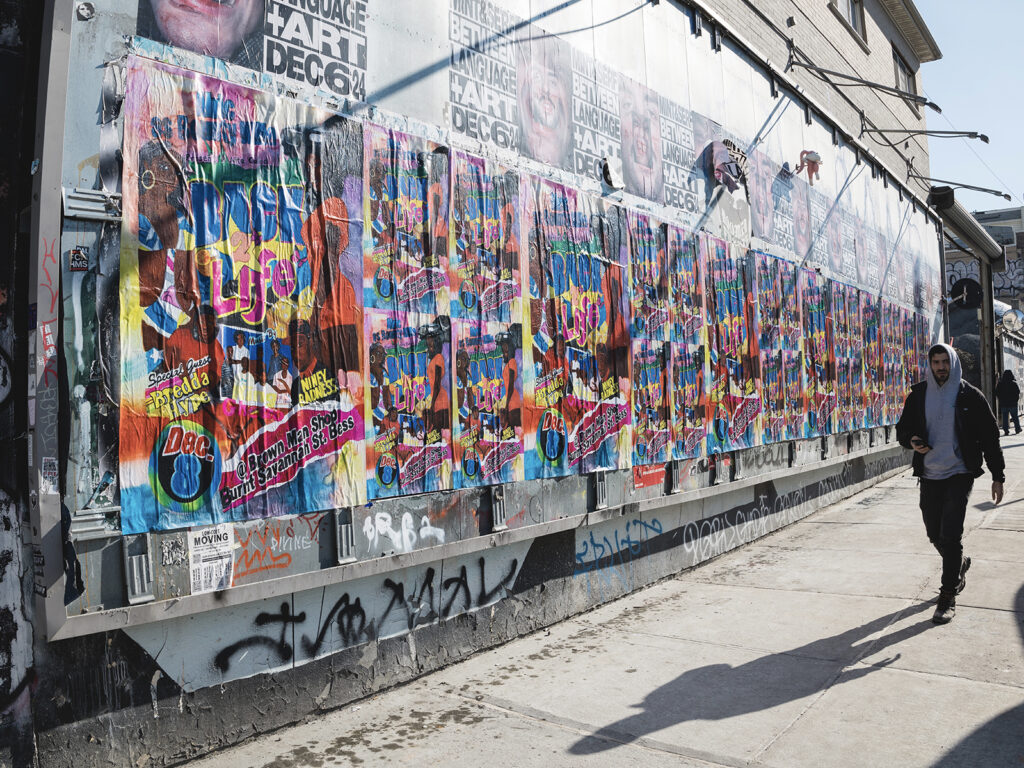
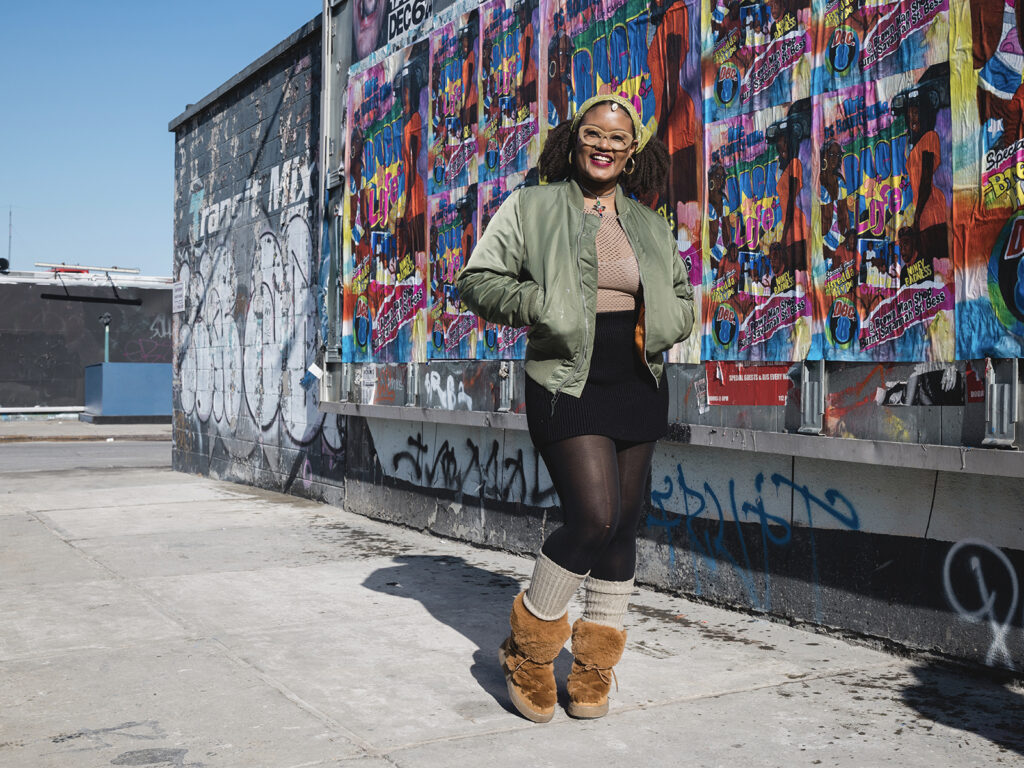
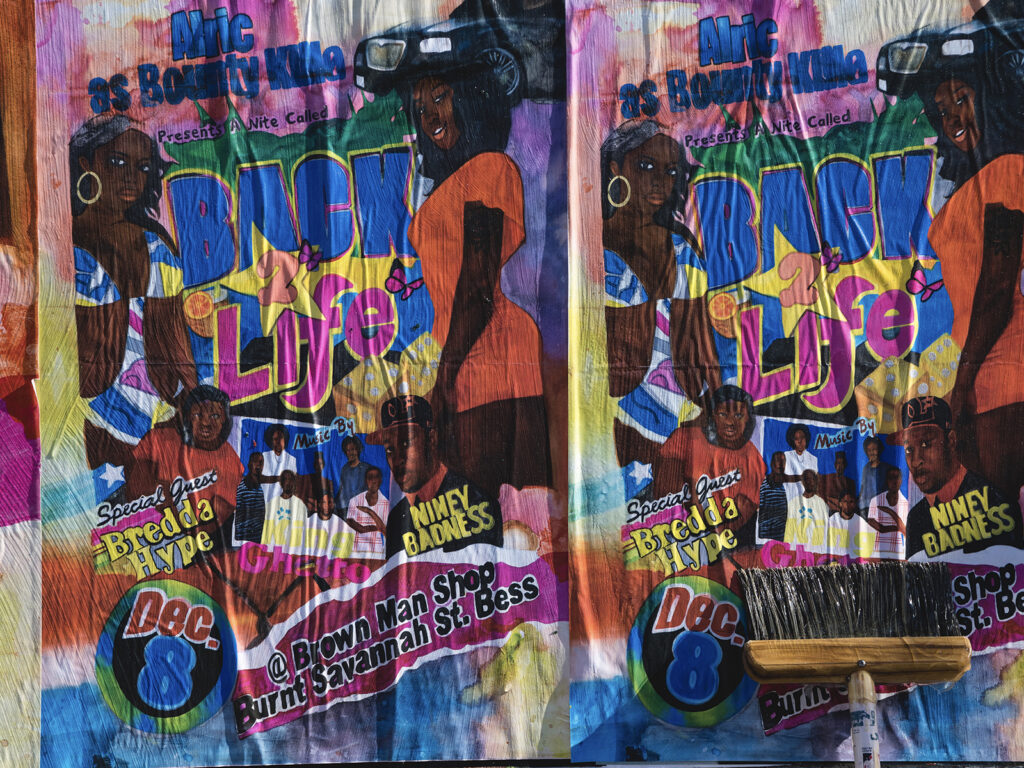
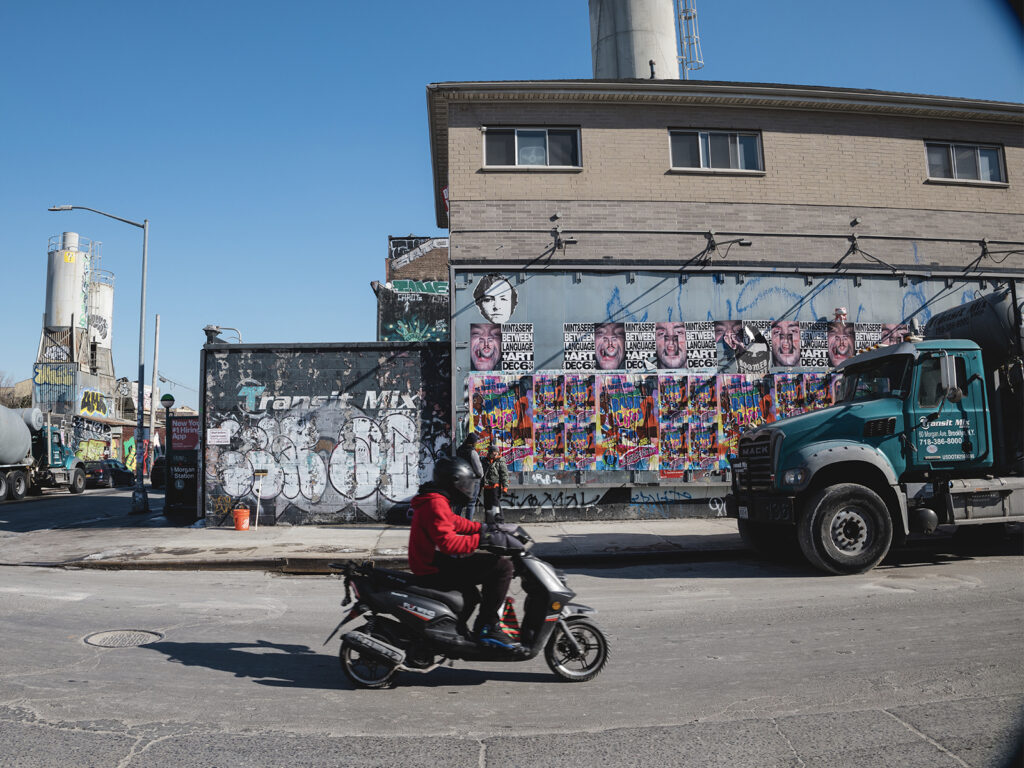
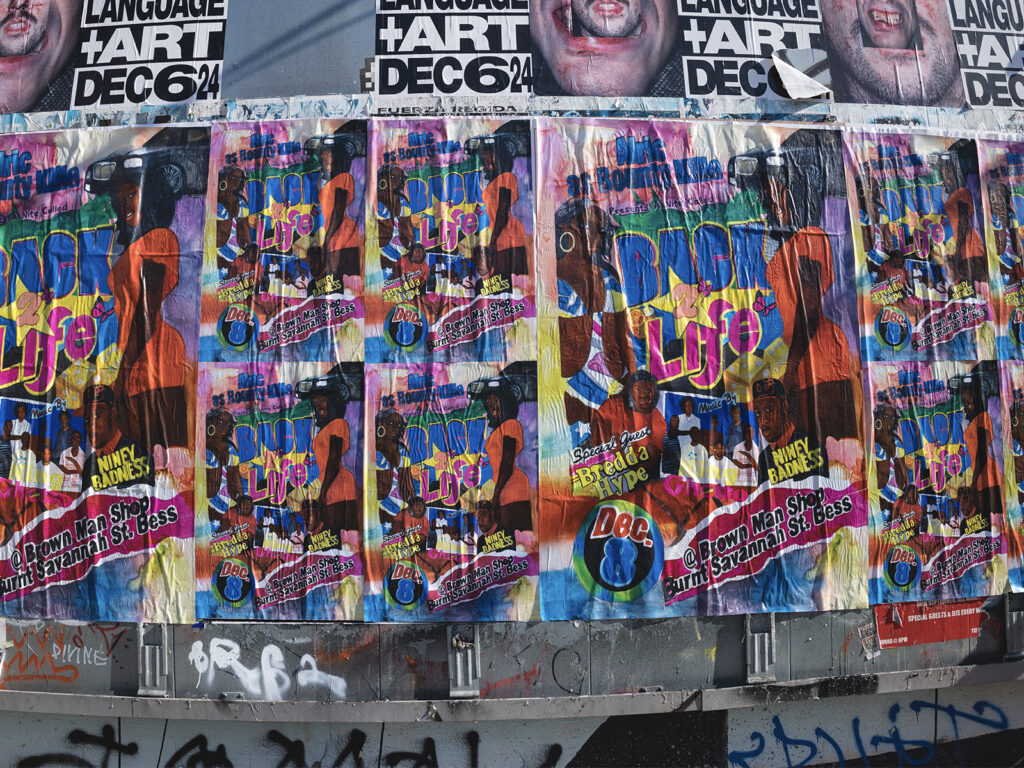

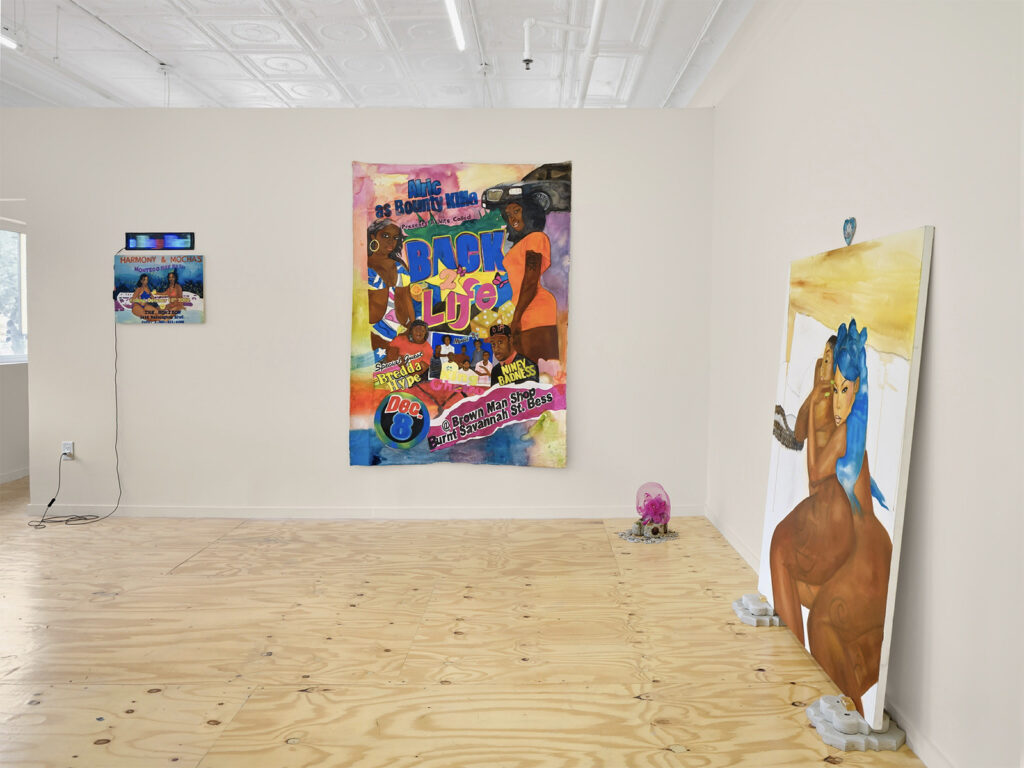
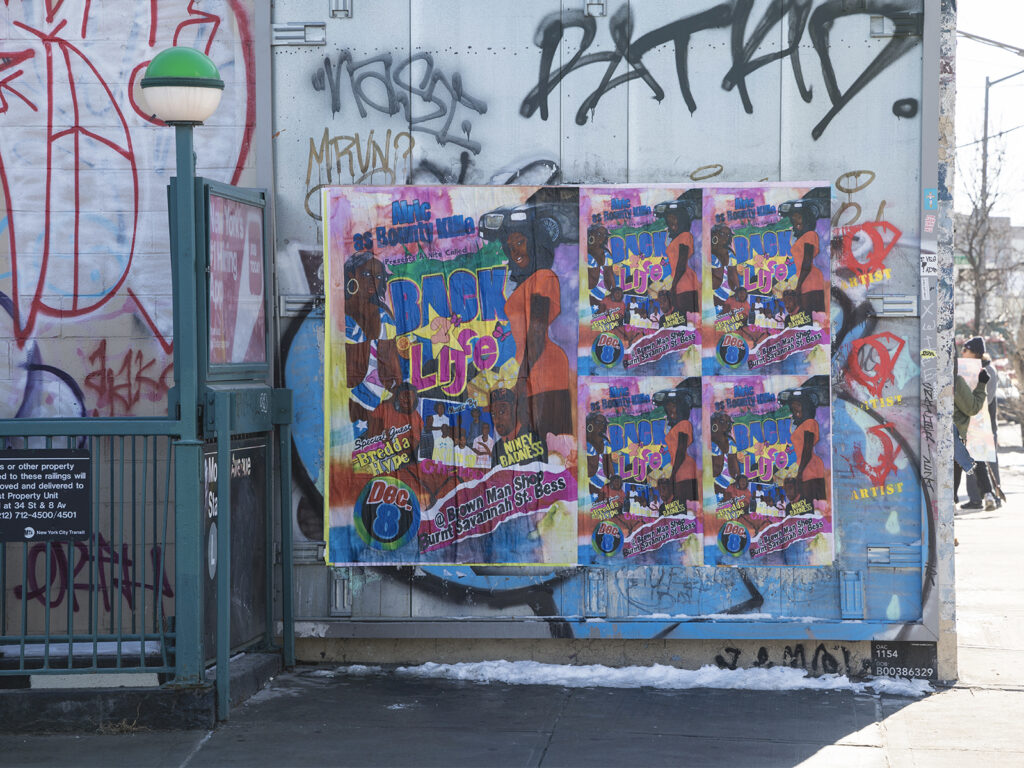
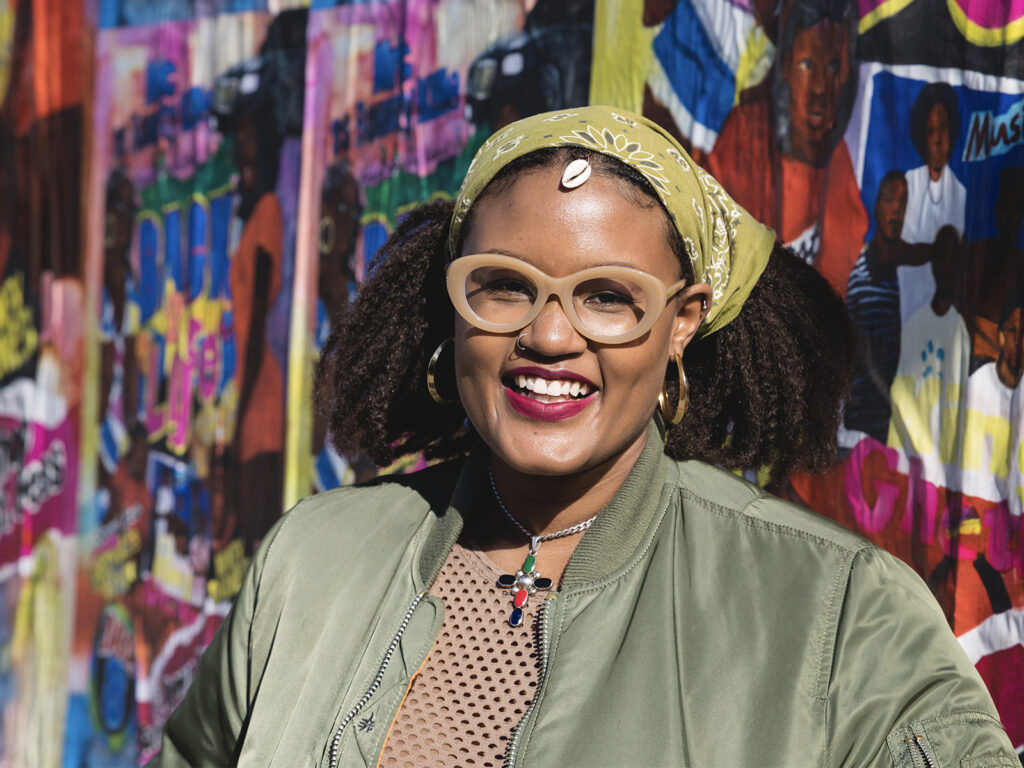
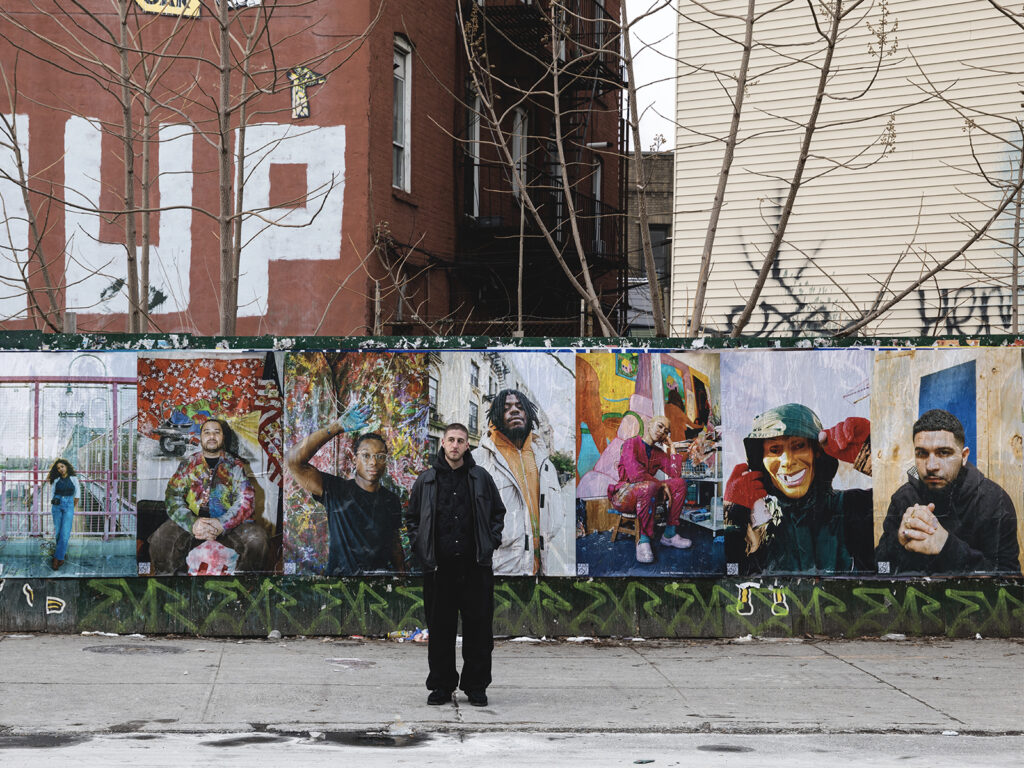
Jacob Consenstein believes New York art is in a golden age right now.
It’s a big statement, but one made by someone who has covered lots of ground and documented just as much in the last decade or so. Jacob was one of the teenagers snatching disposable cameras off CVS shelves – not for mischief, but to capture what was happening around him and his peers in his hometown.
It wasn’t about capturing a “scene” – labels like that come later, applied in hindsight. It was about instinctively preserving moments that felt meaningful: friends creatively reinterpreting the city around them, graffiti becoming more than marks on walls, skating, and parties where hanging out might be the main prerogative, but the sharing of new music and meeting of like-minds an unexpected party favour.
Inspired by those who came before him in street photography, film, music, and more, Jacob sees young New Yorkers carrying on a lineage of creativity that, from the outside, can seem like a rite of passage for growing up in the city. But the idea that New York’s culture and creativity simply “happen” is a myth. The competition, the cost, and the constant motion drive people to connect, collaborate, and create.
For Jacob, this dynamic is reflected in the way art forms intersect. His photography doesn’t just stand alone; it blends seamlessly with music, writing, and storytelling. Projects like his self-published Artist Series – currently wheatpasted by UNCLE on city walls – amplify voices across disciplines, featuring the likes of MIKE, duendita, Deem Spencer, and Sabrina Santiago. Through portraits and interviews, Jacob captures not just individuals but the collective energy of a city that thrives on collaboration.
It’s this hustle and exchange that has fueled Jacob’s wider success, from commercial campaigns with NIKE and adidas to exhibitions across New York. These accomplishments don’t just showcase his talent; they underscore how deeply his work is rooted in the city’s ethos – one that rewards those who contribute something meaningful to its ongoing narrative.
This exchange of energy, effort, and ideas is what keeps New York ticking. Its rich cultural history sets a high bar but for Jacob, it’s a source of inspiration and a challenge to contribute something meaningful to the city’s ever-evolving creative lineage. As he puts it, “If you contribute positively and are prolific, what you give to the city, it gives you back tenfold.”
Even a city as famous for culture and creativity as this one needs people to get off the couch, snatch a couple of film cameras, and make it happen. Golden age or otherwise.
INTRODUCE YOURSELF IN YOUR OWN WORDS. HOW WOULD YOU DESCRIBE WHO YOU ARE AND WHAT YOU DO AS A PHOTOGRAPHER?
My name is Jacob Consenstein. I’m a photographer and director, born and raised in New York. For the past twelve years, I’ve focused on capturing streetwear, youth culture, music, graffiti, and fashion. Over the last few years, I’ve also delved more into commercial and campaign work. At my core, though, I see myself as a creative and a storyteller – someone who uses photography to reflect and amplify the culture around me.
HOW DID YOU FIRST GET INTO PHOTOGRAPHY, AND WHAT DREW YOU TO IT AS A CREATIVE MEDIUM?
I didn’t come from a family with a background in the arts – both of my parents were community college teachers, and most of my extended family worked in education or social services. So, I stumbled into photography pretty organically.
I transferred high schools and ended up at one that offered internships instead of traditional classes. My advisor there was the first person to suggest that a creative path was even viable. That idea had never really been presented to me before. I ended up leaving high school a semester early and cold-emailed people at places I was drawn to at the time, like Mass Appeal magazine and Only NY.
At the same time, my friends and I were immersed in graffiti, skateboarding, and throwing parties around New York. I was so proud of what was happening in that world that I wanted to document it. I started shoplifting disposable cameras from CVS to take photos constantly. Eventually, a friend gave me my first real camera in 2014 or 2015. Photography was the first thing I felt genuinely good at, it clicked with me in a way school never did.
From there, I just kept documenting my surroundings and figuring it out as I went. It’s been a very non-traditional route to get to where I am now, but it’s always felt natural to me
WERE THERE ANY EARLY INFLUENCES I.E. PHOTOGRAPHERS, ARTISTS, OR MOMENT THAT SHAPED YOUR APPROACH TO PHOTOGRAPHY?
A lot of my early influences came directly from my surroundings. Growing up on the Upper West Side of Manhattan, I was constantly surrounded by culture. It’s the birthplace of hip-hop, and my sister, who’s eight years older than me, was into punk, ska, and hip-hop. My dad was a Deadhead, my mom loved disco and the B-52s, and I got deeply into ’90s hip-hop and boom bap. That mix of styles and cultures really shaped me.
I was fascinated by uptown New York culture – how vibrant and raw it was. The ‘old heads’ on the street, the music, the style, it all inspired me. I also admired downtown kids like Harold Hunter and the OG Supreme crew. They were like blueprints for how creativity and culture could intersect.
A lot of my inspiration also came from streetwear. When I was working at those brands, I met a lot of scrappy people doing cool stuff. One founder used his friends’ screen printing labs at FIT (Fashion Institute of Technology) to launch his brand. People were just hustling – skateboarders, graffiti artists, musicians – they were all making things happen, and I thought it was amazing and I really connected to the grassroots nature of it.
That passion turned into an obsession. I started to nerd out about the culture, researching and dedicating time to understanding it. My peers and surroundings were my biggest inspirations. They still are, in many ways.
YOU OFTEN SHOOT ON FILM, WHAT APPEALS TO YOU ABOUT FILM PHOTOGRAPHY COMPARED TO DIGITAL? DO YOU FIND THE PROCESS OR RESULTS DIFFERENT?
There’s something about film photography that feels timeless. For me, it’s the process as much as the results. I love the delayed gratification – taking a photo, letting the roll sit until it’s finished, and then waiting to develop and scan it. That slower, physical process makes each shot feel more intentional.
Film also has a tactile quality that I find really appealing. Even with my digital work, I’ll sometimes print and scan it to give it more texture and life. There’s an innate depth to film that’s hard to replicate digitally – it feels more human, and I think people naturally respond to that.
I started on film, too. Someone gave me a Pentax K1000, and it was the first camera I owned. It taught me the fundamentals—how to understand aperture, lighting, and the mechanics of photography. That hands-on learning shaped how I approach every photo I take.
That said, I’ve grown to appreciate digital photography in its own way. It’s industry standard for commercial work, and I’ve found a creative relationship with it over time. I wouldn’t say I prefer one over the other anymore—they’re both equally interesting to me now, just in different ways.
SOCIAL MEDIA PLATFORMS LIKE INSTAGRAM WERE ONCE PHOTOGRAPHY-FIRST SPACES, BUT THEY’VE SHIFTED TOWARD VIDEO CONTENT AND ALGORITHMS. HOW HAS THIS IMPACTED YOU AS A PHOTOGRAPHER?
I think there’s no denying that Instagram and similar platforms have shifted significantly over the years. When I first got on Instagram, it felt like a space where photos could be appreciated as an art form in their own right. Now, with the push toward video content and algorithm-driven trends, it’s harder for photography to stand out in the same way.
That said, I’ve always seen the value of presenting work physically. There’s something uniquely impactful about seeing art in person on the street or in a gallery, rather than on a screen. That’s part of what I love about this project with UNCLE, where the work exists in public spaces for everyone to see. It removes the hierarchy of galleries and makes art accessible in a raw, immediate way.
The changes in social media remind me how important physical displays of work are. They’ve encouraged me to focus on projects like this, where the art exists outside the digital space.
DO YOU SEE SOCIAL MEDIA AS A TOOL OR A CHALLENGE FOR SHOWCASING YOUR WORK TODAY?
For me, social media has been mostly positive. I’ve always treated Instagram like a portfolio – a way to share my work and tell the stories behind it. I think that mindset has helped me stay grounded as the platform has evolved. It’s a tool for connecting with a community and showcasing what I do, but I try not to let the pressures of algorithms or trends affect my creative process too much.
Of course, social media has its challenges, especially with how saturated it’s become. But I’ve been lucky to grow a network of people who genuinely appreciate my work. Every post feels like an offering to them, and I focus on creating something meaningful with each one. It’s not without its frustrations, but overall, I’d say it’s been a tool that’s opened up a lot of opportunities for me.
THE ARTIST SERIES, YOUR PROJECT CHOSEN TO COLLABORATE ON WITH UNCLE, HIGHLIGHTS PORTRAITS OF NEW YORK’S CREATIVE COMMUNITY. WHAT INSPIRED YOU TO FOCUS ON THESE INDIVIDUALS, AND HOW DO THEY REFLECT THE CITY’S CREATIVE ETHOS?
This project started in early 2020 as a way to capture and celebrate the people in my immediate circle who I felt were doing something truly special. These are individuals I’ve admired for a long time – people I’ve partied with, collaborated with, or just been inspired by.
The focus is on artists in New York who are making substantive contributions to their fields, whether that’s music, painting, or other creative disciplines. What ties them all together is their dedication to their craft and their ability to bring something unique to the cultural landscape.
For me, this series is about more than just documenting – it’s about weaving a narrative. Each artist I feature represents a thread in the larger web of New York’s creative community. They’re people I believe are contributing to what feels like a golden age in New York art right now. Through their portraits and accompanying stories, I want to show how interconnected and vibrant this scene truly is.
HOW DOES IT FEEL TO SEE YOUR WORK PRESENTED ON THE STREETS OF NEW YORK, AS PART OF A WILDPOSTING CAMPAIGN, INSTEAD OF IN A GALLERY OR ONLINE?
There’s a rawness to presenting art in public spaces that you just don’t get in a gallery or online. It feels immediate, accessible, and democratic – anyone passing by can engage with it, no matter who they are or where they’re from.
What I love most is how it removes the barriers that often exist in the art world. There’s no hierarchy to it. It’s not about exclusivity or curated experiences; it’s about the art being part of the city itself. For me, that’s a beautiful way to connect with people and to bring art into their daily lives.
WHAT DO YOU LOVE MOST ABOUT NEW YORK CITY?
To be honest, it’s hard for me to talk about New York without sounding biased – it’s such a big part of who I am and the growth I’ve experienced as an artist. The city has this incredible, unmatched energy. The pace, the movement, the constant exchange of ideas – it all creates an environment where creativity thrives.
What you put into New York comes back to you tenfold, and that’s something I’ve experienced firsthand. There’s also this sense of history here. Growing up, I was surrounded by the stories and images of people who had made their mark on the city. It’s inspiring to be part of that legacy, to contribute something to a place that has already given so much to the world.
And of course, the cliches are true, ‘If you can make it in New York, you can make it anywhere.’ It’s a tough city, but if you navigate it the right way, it pays you back in ways you couldn’t imagine.
WHAT DO YOU FIND CHALLENGING ABOUT BEING A CREATIVE IN NEW YORK?
New York is an amazing place, but it’s also one of the toughest cities to make it in, especially as a young artist. The cost of living is sky-high, and working independently can feel like an uphill battle. You really have to be on top of your game to sustain yourself here while also trying to create meaningful work.
WHAT DO YOU HOPE PEOPLE TAKE AWAY FROM YOUR WORK, WHETHER THEY’RE SEEING IT ON THE STREETS OR SCROLLING PAST IT ON A SCREEN?
I hope people take the time to really look at my work and see the connections within it. Across everything I do, whether it’s street photography, portraits, or more conceptual projects – I’m telling one interconnected story. It’s about culture, energy, and the things that bring people together.
What I want people to understand is that my work isn’t about isolated moments; it’s all woven together. I think of people like Wolfgang Tillmans, who can present vastly different projects and still make them feel like part of a larger, cohesive narrative. That’s the kind of impact I hope my work has.
Whether it’s someone walking past my photos on the street or scrolling through them online, I want them to pause and see the depth and substance behind the image. Each photo is more than just a moment – it’s part of a bigger cultural conversation, a reflection of the energy and movement happening around us.
Ultimately, I want people to feel something, to connect with the story I’m telling, and maybe even be inspired to look at their surroundings a little differently.
WHAT WAS THE LAST ALBUM YOU LISTENED TO ALL THE WAY THROUGH?
Ultimate Love Song Collection by Doris. It’s such a great listen – 41 minutes of beautifully crafted songs. It’s an underground gem I came across, and I’ve been playing it almost every time, start to finish.
WHAT IS YOUR FAVOURITE PLACE IN NEW YORK TO SEE LIVE MUSIC?
Brooklyn Paramount. It’s this stunning old theatre in downtown Brooklyn that they recently reopened. The high ceilings make it feel open and vibrant, even when it’s packed. Every show I’ve seen there has been incredible.
ANY ADVICE FOR PEOPLE WALKING PAST YOUR WORK ON THE STREET WHILST IT’S UP ON THE WALLS OF NEW YORK CITY?
Take a moment to really look. Read the passages and learn more about the artists featured. Everyone in this series is doing something substantial in music, painting, or other forms of art. It’s a chance to engage with work that you might not see anywhere else, it’s all right there in front of you.



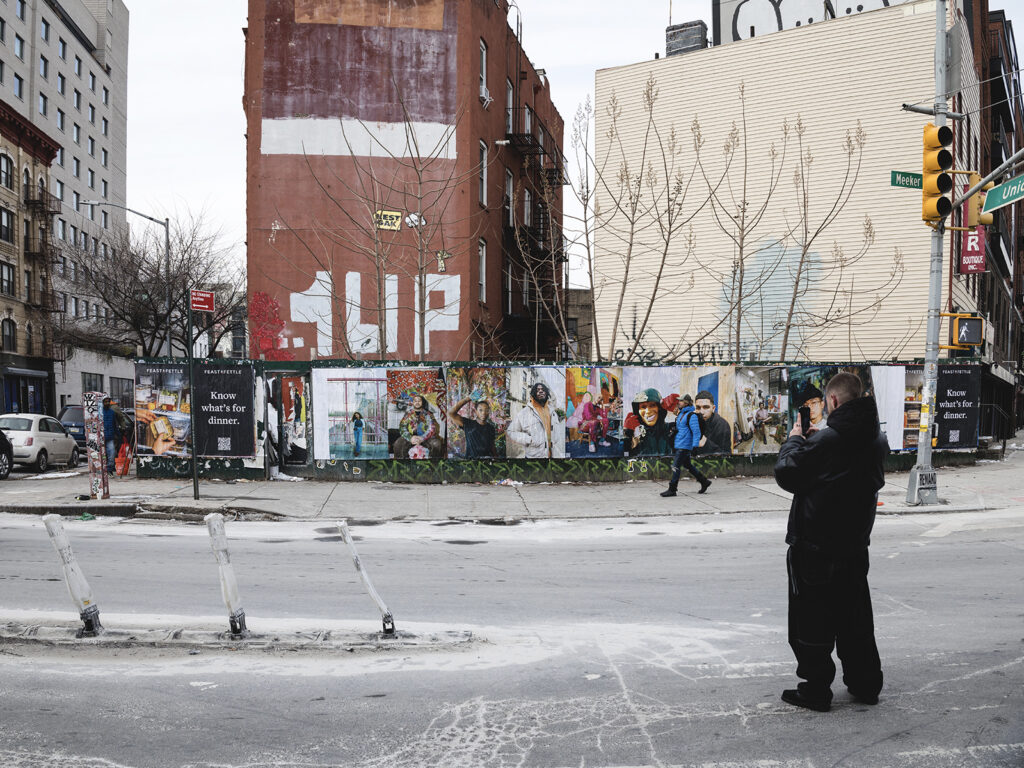
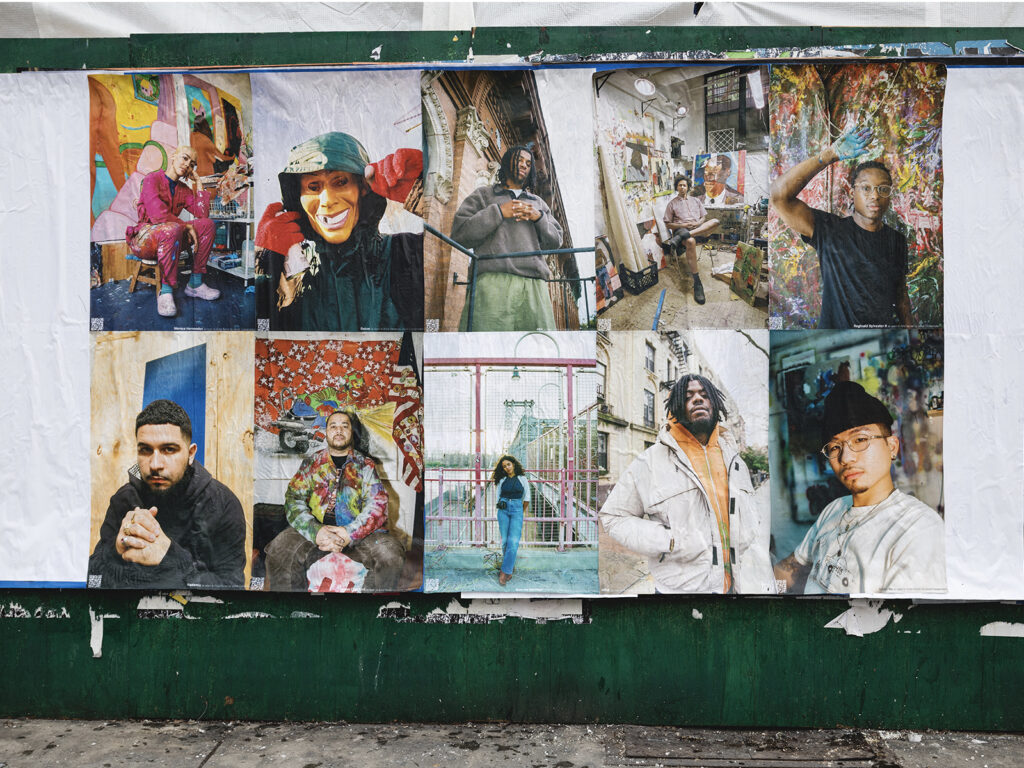
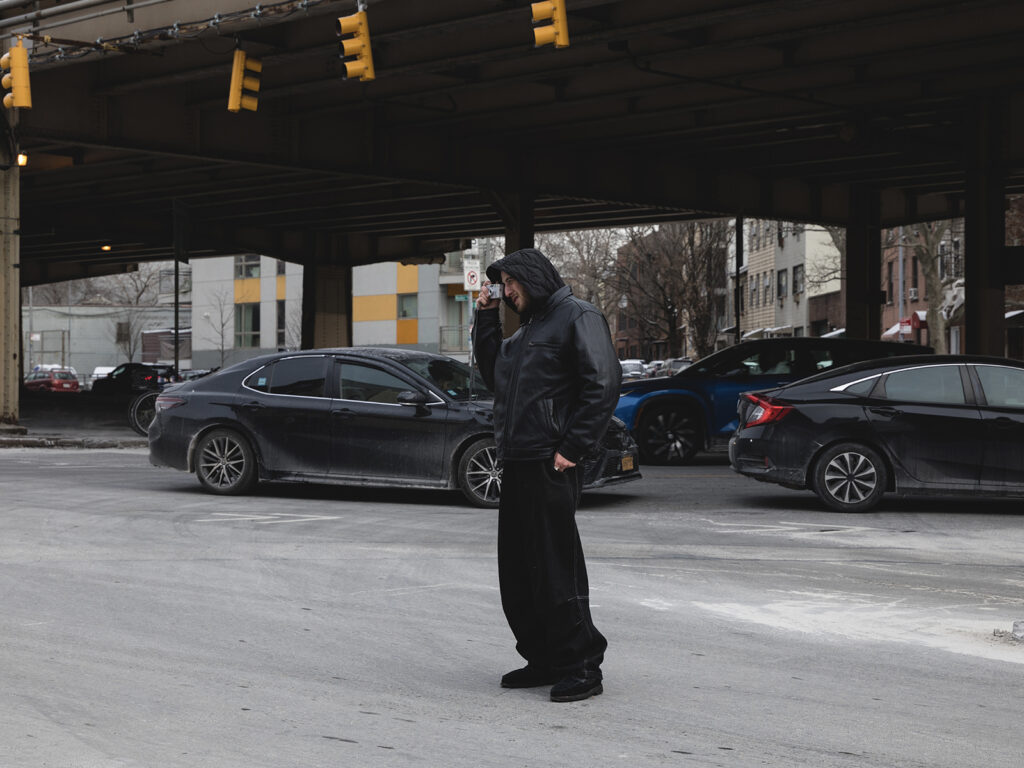
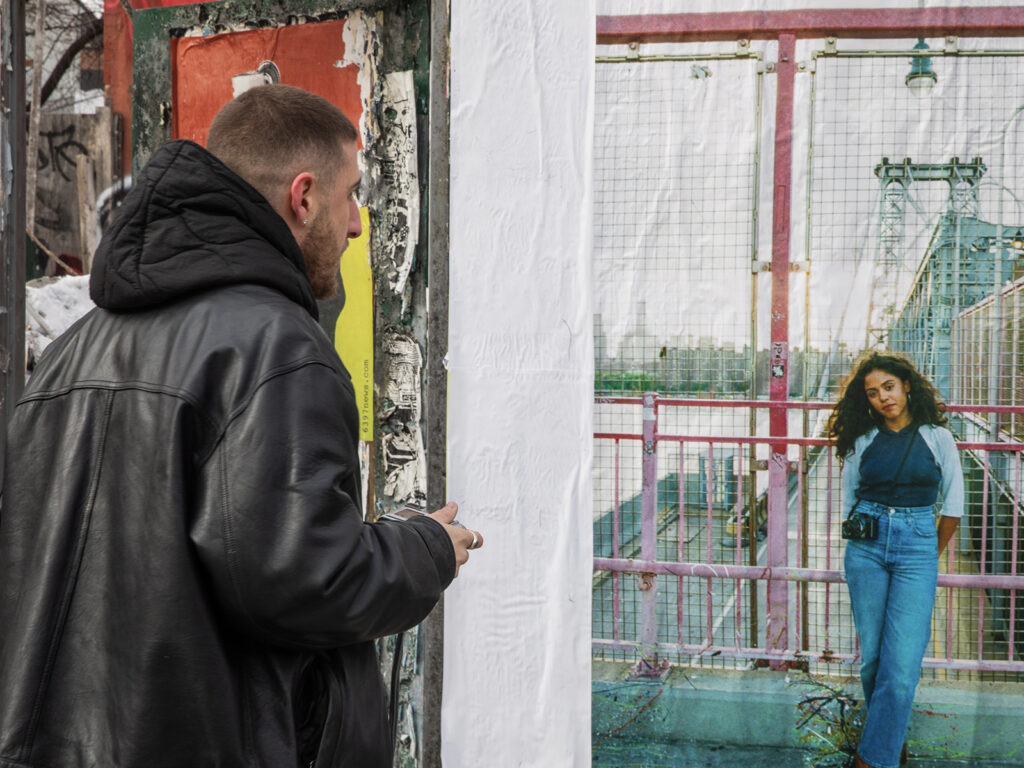

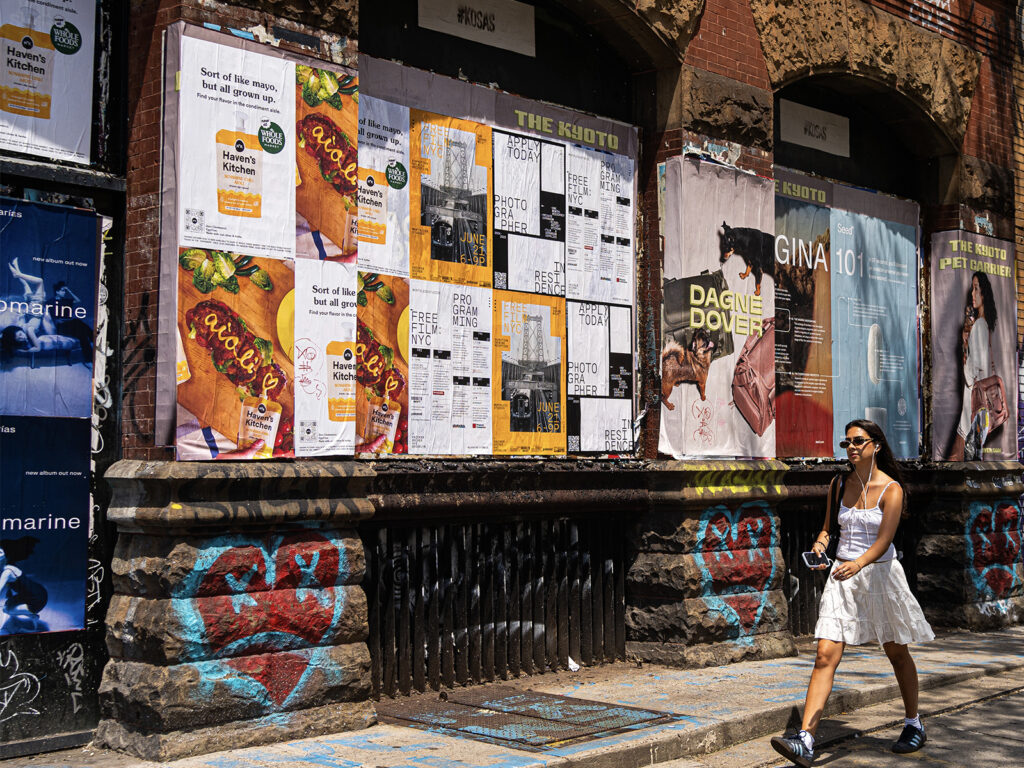
WORTHLESSSTUDIOS is an organization dedicated to fostering creativity by providing artists with the necessary space, materials, and technical support to realize their artistic visions. UNCLE partnered with them on their notable recent imitative “FREE FILM: NYC LES” a public art endeavor that engages both aspiring and professional photographers in documenting specific New York City neighborhoods using analog film. We brought their posters to city streets to drive eyes to the exhibition that focuses on Manhattans Lower East Side.
Their projects emphasize artistic activation, community engagement, and education, aiming to go beyond merely creating artwork. This ‘community first’ attitude does not go unnoticed amongst New York streets that thrive in pulling together factions and uniting them in a history driven by the city itself. This project’s prompt – “ONE SQUARE MILE,” focuses on the Lower East Side, creating a collective archive of images that encapsulate the essence of the area. Already steeped in a deep history, the exhibition acts as a point of camaraderie for the people of Manhattan and beyond.
In the interview we conducted we touched on the studio’s conception, goals and how each photographer contributing to the exhibition is tied to the location itself as well as the broader cultural narrative of New York City. We also explore the work they do outside of this project and how their residency programme elevates its members through public activities like workshops and educational courses. There is more than meets the eye to WORTHLESSSTUDIOS and UNCLE couldn’t wait to delve deeper.
CAN YOU DESCRIBE THE CONCEPT AND GOALS BEHIND FREE FILM : NYC?
FREE FILM : NYC is a public art project engaging a community of photographers, both aspiring and professional, in the documentation of specific New York City neighborhoods using analog film. Each time the program is activated we distribute 100 rolls of 35mm black-white film to local photographers for free. They bring back film shot on a specific prompt, this time “ONE SQUARE MILE”, and we develop, scan, and curate a show and book. We are interested in creating a collective archive of images that describe a time and place, and for the past two years NYC has been the focus.
HOW DID YOU CHOOSE THESE NEIGHBORHOODS AS THE FOCAL POINT FOR THIS ITERATION OF THE FREE FILM PROJECT?
We started with an open call to photographers who applied with a specific neighborhood that they have a special relationship to. They took up residency in our converted 1970’s Airstream Darkroom. During the residency, the selected photographers were asked to run activities open to the public, such as workshops and photowalks, as well as youth education programs in collaboration with our institutional partners, which we identified to serve the local community, through art and photography. The relationship the Photographer in Residence has with the neighborhood is what drove the focal point of the programs.
HOW ARE THESE NEIGHBORHOODS TIED TO A WIDER NYC?
We let the photos taken by the 150+ photographers included in our book and exhibition tell the story. Like previous iterations of FREE FILM we tend to see a lot of overlap in cultural motifs, styles, and iconography throughout the city, no matter which neighborhood you are in. However, there is a distinct attitude and geography that can be seen and felt in each neighborhood that shows how unique and bonded the individuals in the neighborhood are as a community.
WHAT HAVE BEEN SOME OF THE MOST MEMORABLE OR IMPACTFUL PHOTOGRAPHS YOU’VE RECEIVED FROM PARTICIPANTS?
A few images come into my head with this question, all very different. We had really heartwarming moments from families playing during a parade around Sunset Park, a group of young men playing basketball under the FDR Drive with the Brooklyn Bridge as the background around the Lower East Side, a few images of young girls running and playing with the open hydrants during the Bronx’s hottest summer so far. Others are very iconic places such as the Williamsburg bridge, a few churches in Harlem, Lady Liberty seen from Red Hook. Each neighborhood had its own charm, and surprising images.
WHAT ARE SOME OF THE BIGGEST CHALLENGES YOU FACED IN EXECUTING THIS PROJECT?
The biggest challenge at first was to drive the Airstream throughout the city, through the narrowest streets while cars were double parked, but the team was always able to make it work without a scratch.
With the help from picturehouse + thesmalldarkroom we were able to keep all rolls and scans in order to return to the participant photographers, without any mix up on delivering scans and negatives.
Editing the book was also a big challenge, as we collected over 15,000 images, editing down to 124 published images was a great effort, tackled between the Resident Photographers and the WORTHLESSSTUDIOS team.
HOW HAS THE PROJECT EVOLVED SINCE ITS INCEPTION, AND WHAT FUTURE DIRECTIONS DO YOU ENVISION FOR IT?
The project started in 2018 when Neil Hamamoto developed the concept to hand out free 35mm film to strangers for free as a pop up project on Canal Street in lower Manhattan. The participants of FREE FILM : CANAL had 24 hours to take all 36 exposures with the prompt “CANAL” and return the roll of film to us. We spent a week in the darkroom developing the film and using our enlargers to make silver gelatin prints of the selects that really stood out to us. We were amazed as to the way people took the concept in so many directions in such little time. As an organization seeking to assist artists through materials, space, fabrication, and one-on-one guidance we see the future of this project as a Resident Photographer-focused program that helps elevate their body of work and knowledge of the process. Our Photographer in Residence Application is now open for submissions at https://www.worthlessstudios.org/photographer-in-residence
WHAT IMPACT DO YOU HOPE “FREE FILM: NYC LES” FREE FILM WILL HAVE ON THE LOCAL COMMUNITY AND THE BROADER ART SCENE?
WORTHLESSSTUDIOS’ mission to provide space, materials, technical assistance, and resources to artists to realize their creative visions is clearly reflected in FREE FILM. One of our goals is to help photographers keep making analogue photography, as well as helping others get back into it. From years of talking with the participants, the project has been a community builder for them – they have come into a passionate group of analog photographers where they can dig deeper into their art practices.
Our hopes are that these photographers will stay connected with photography, keep practicing it and growing with it, as well as building a community between themselves and WORTHLESSSTUDIOS.
HOW DID YOU DESIGN THE VISUAL COMPONENT OF THE PROJECT?
For the FREE FILM : NYC exhibition we wanted to set a scene reminiscent of each neighborhood program: The Airstream parked in front of a green, graffiti-covered construction wall. Since the Airstream was always onsite we decided to bring it inside and create an immersive environment for the photographs surrounding it. Then we let the photographs do the talking.
When designing the posters and advertising for this project we focused on spreading awareness of our available resources and programs, hence our legibility and clarity-centered digital design.

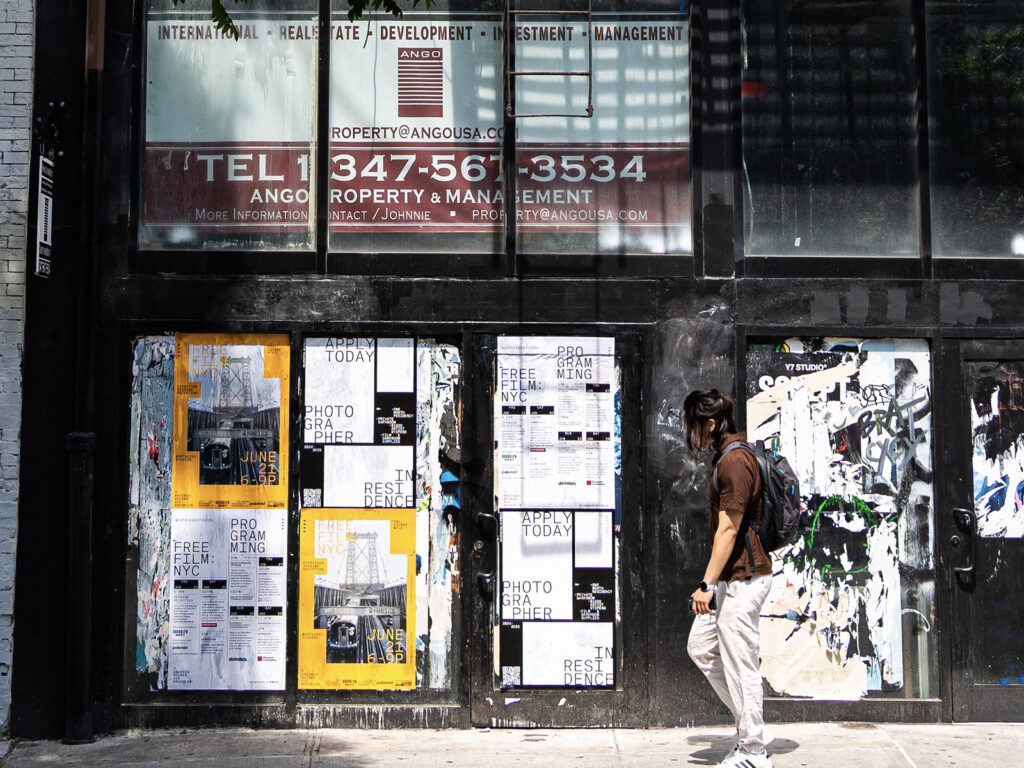
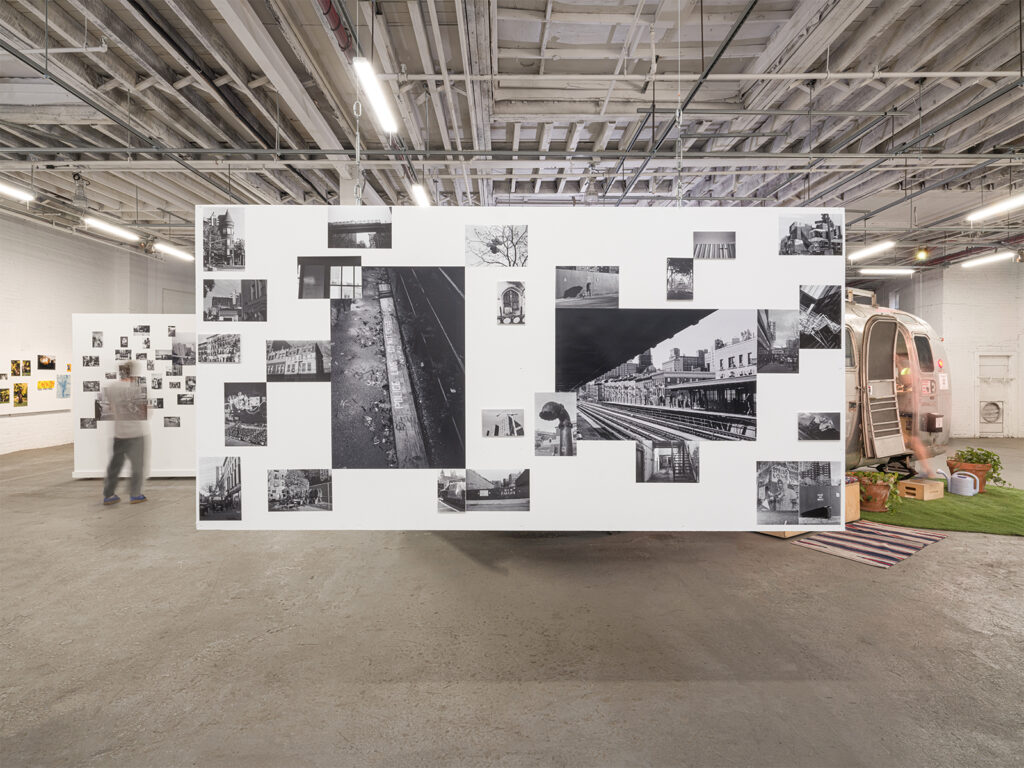
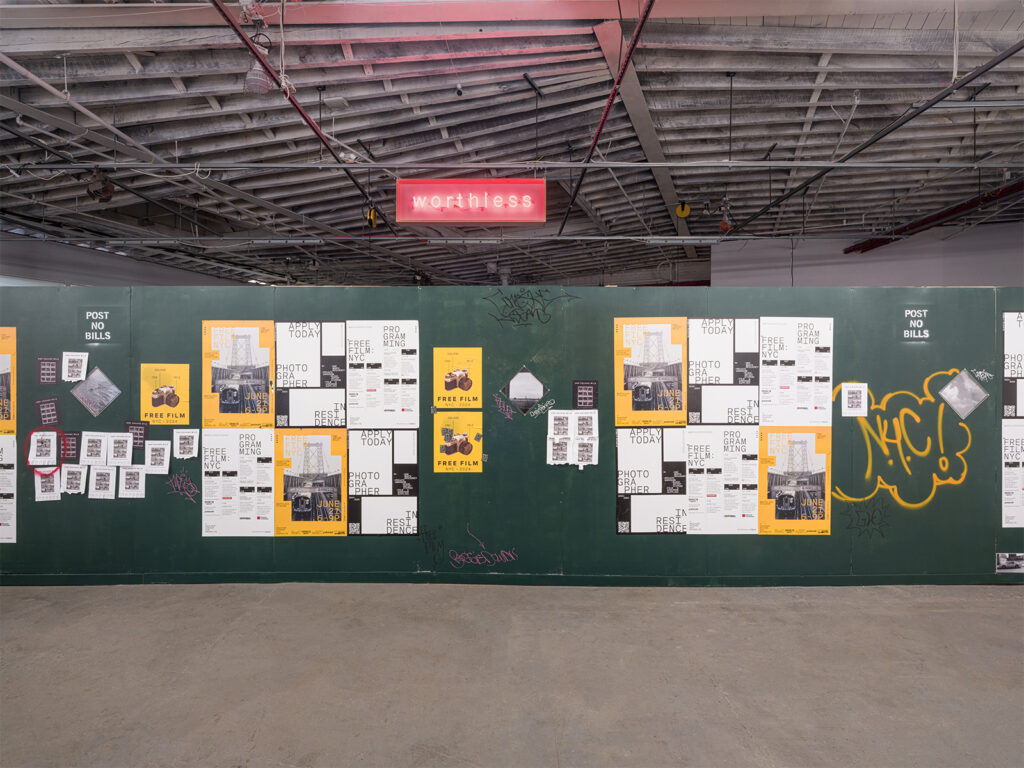
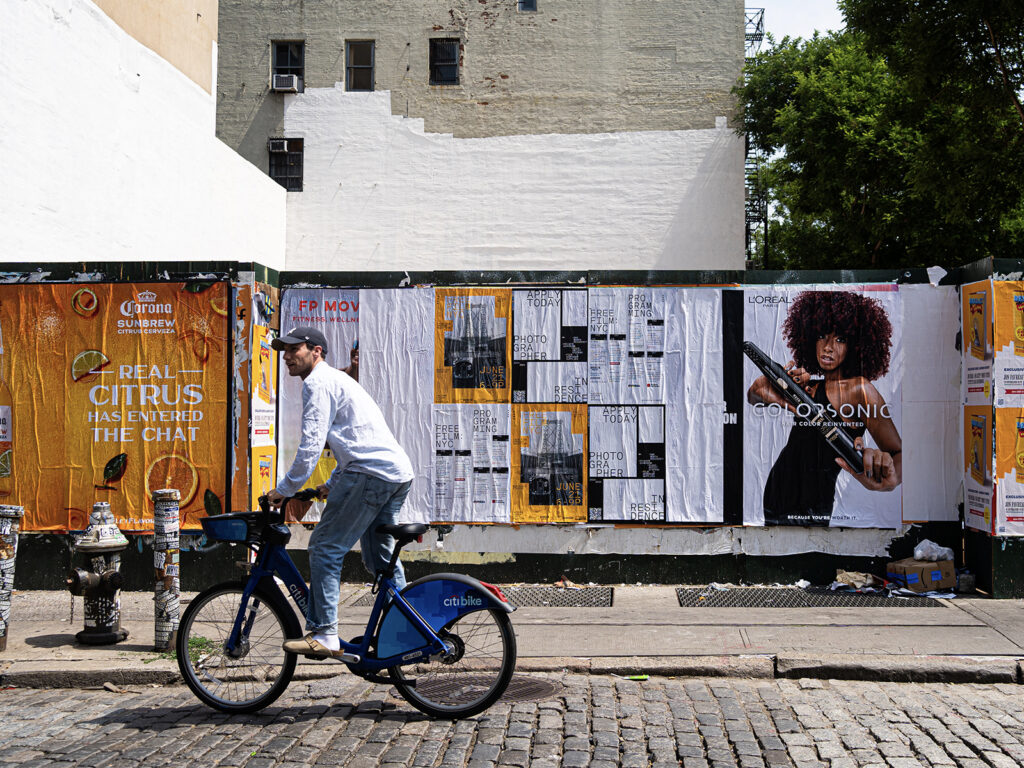
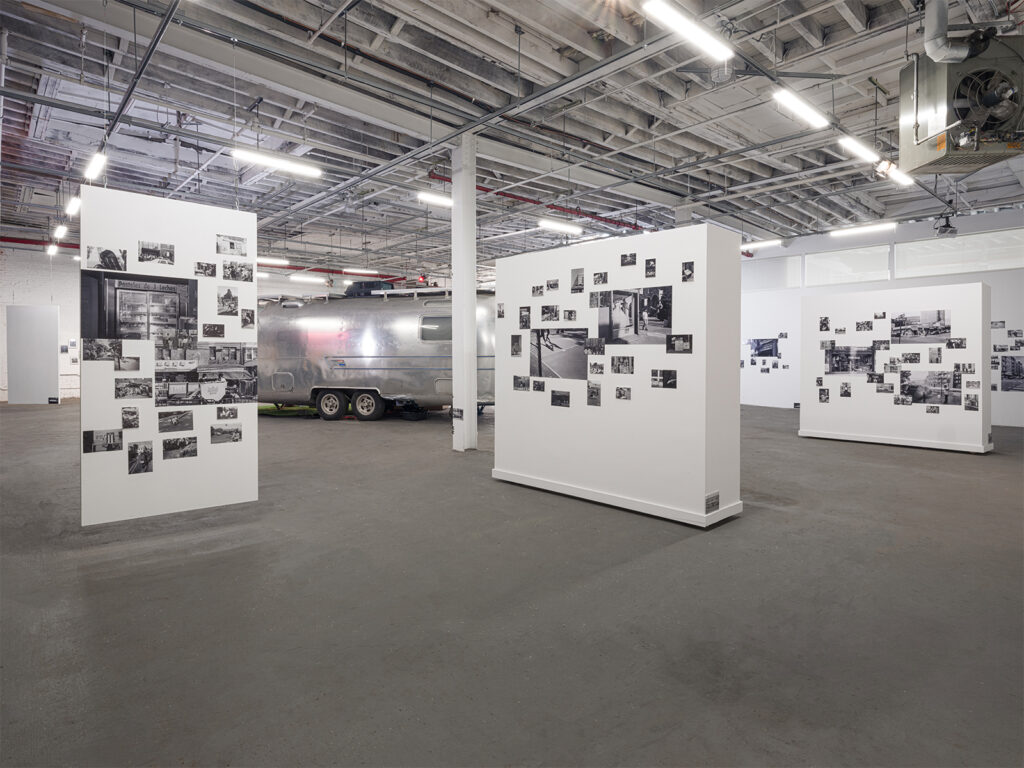
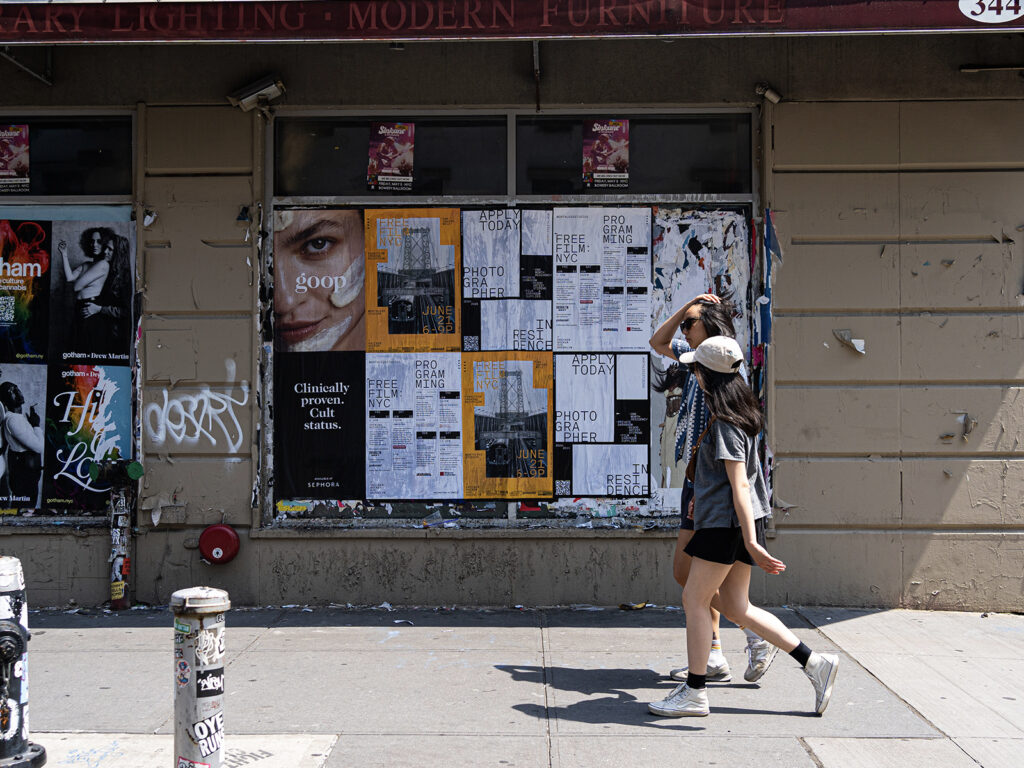
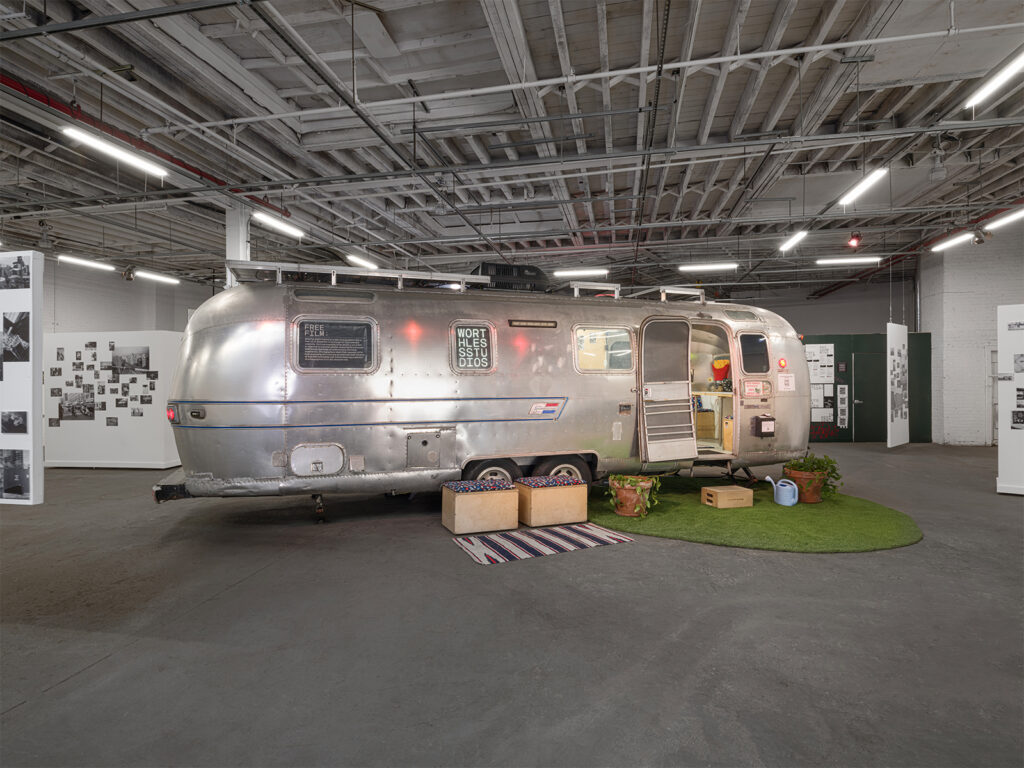
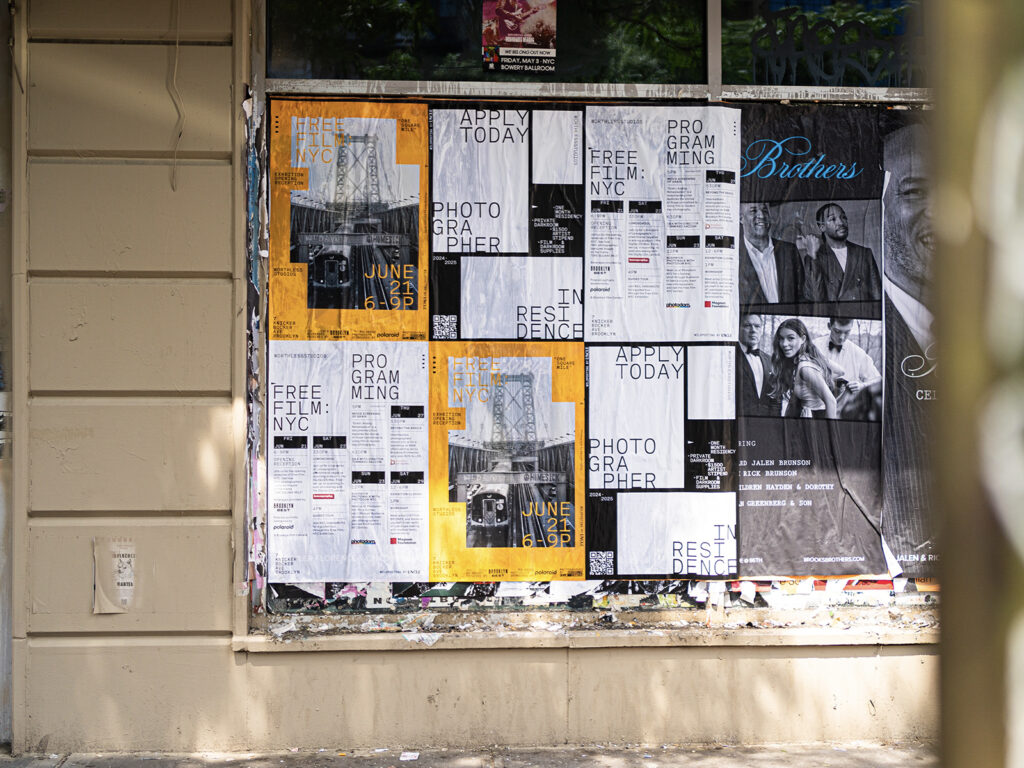
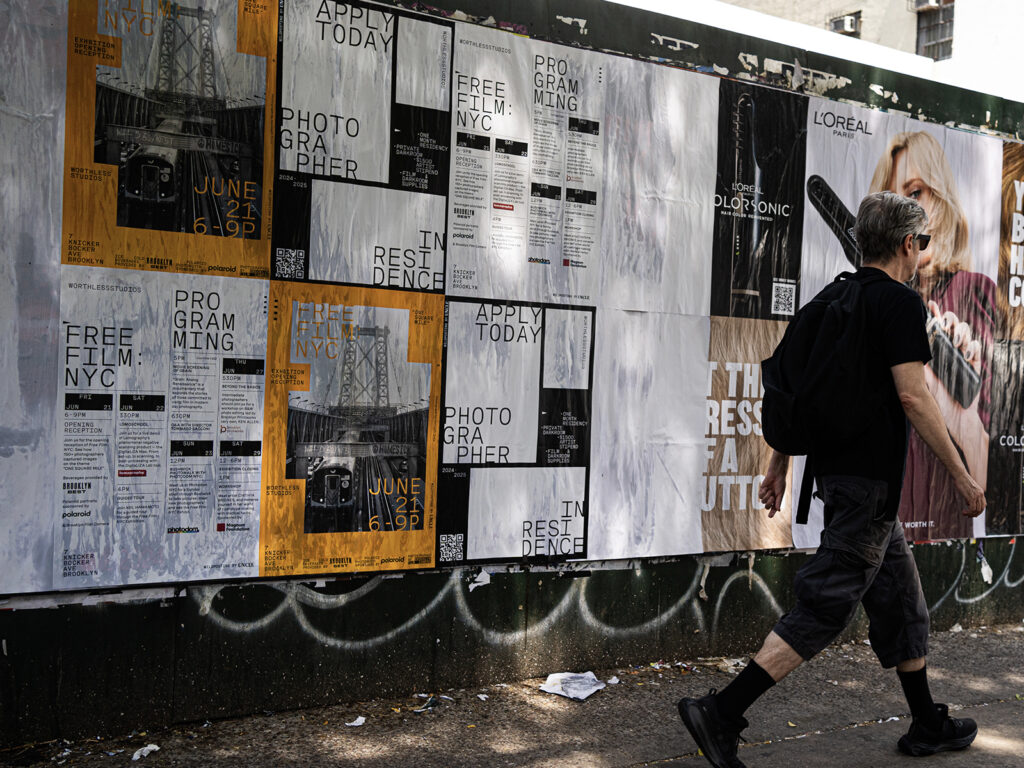
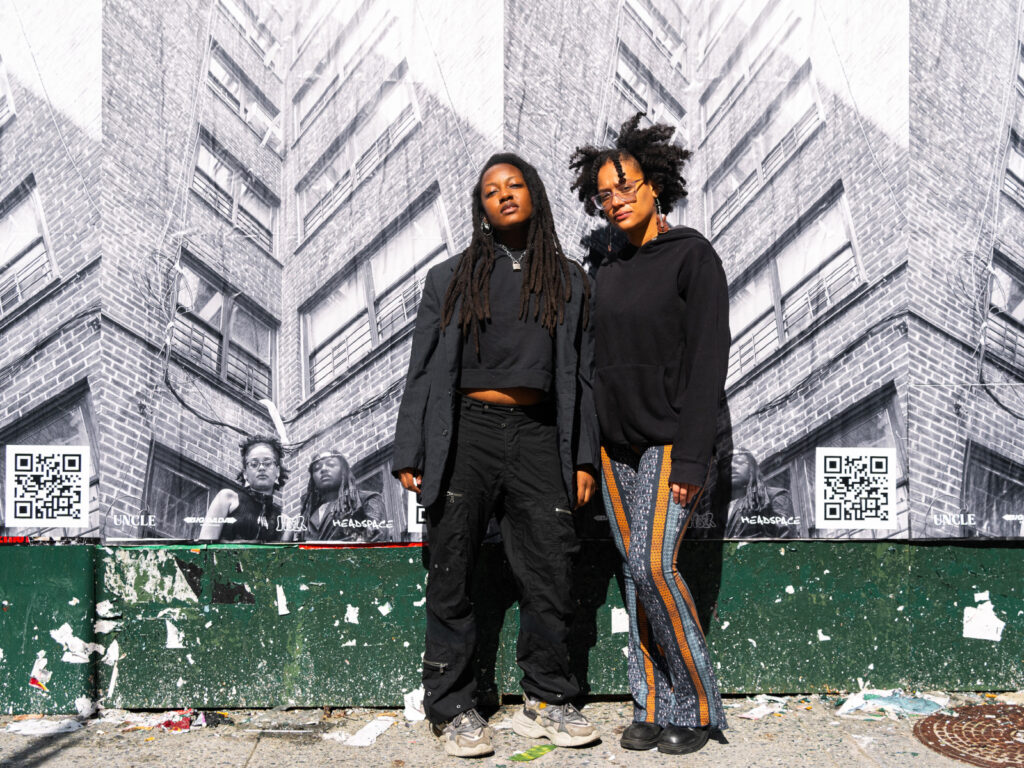
JWords and maassai. An innovative music producer and a poetic, rapping raconteur who met at a low-key gig in New York, embody what’s good about the city’s underground music culture.
Known collectively as H31R (pronounced heir/air), their self-described ‘weird and groovy’ take on Hip Hop embraces the traditions of self and social consciousness found in the heralded East Coast rap of t2he mid-nineties, intermingled with an ethos – sonically and holistically – to never go backwards.
H31R – ‘Backwards’ (Official Video)
maassai was born and raised in Brooklyn and takes great pride in being from the city where rap originates from. Directly influenced by the culture of Hip Hop, the artist grew up around vocalists and got her first experience of taking part in music through church. But by the time of maassai’s EP C0n$truct!0n, released in 2019, it was clear that she was taking on influences from far and wide. With production from the influential keiyaA on that debut project, a composition from South Carolina’s Contour on 2021’s With the Shifts – and an ability to freely weave singing with raps or sub-genres with scenes – maassai’s music galvanises different pockets of ‘what’s what’ in underground music, whilst remaining avant-garde.
Which makes JWords the ideal partner. Raised in New Jersey, JWords cut her teeth as part of a band in Union City’s comparably small music scene before following her growing production credits across the George Washington Bridge to New York. It should be a challenge to cut through the noise in a city where beatmakers are ten-a-penny and everyone and their housemate has an SP-404, but JWords does so with sped-up, club-ready drums and the embracing of synthesisers and drum machines that few are experimenting with. A monthly residency on New York’s crucial creative touchpoint, The Lot Radio, has become a space for JWords to experiment with music in real-time, inviting friends on air for broadcasts that champion New York’s new wave of expressive underground music.
JWords and Keenyn Omari @TheLotRadio 02-19-2024
The duo’s friendship extends beyond the studio and stage, acting as the cornerstone of their latest collaborative album HeadSpace. The record touches on self-acceptance and authenticity, themes that unravel organically thanks to the comfort of creating amongst those who care for each other.
Released at the tail end of 2023 by London-based Big Dada Recordings, an independent level run by people of colour for artists of colour, HeadSpace has further built an audience for H31R outside of Brooklyn where the beatmaker and lyricist originally met. They are soon to tour Europe for the first time off the back of the record, whilst a collaboration with UNCLE will ensure their album is fittingly plastered all over New York – the city where their record came together and a city where life-changing friendships can be made at the next gig you attend.
HeadSpace – Album by H31R | Spotify / https://h31r.bandcamp.com/album/headspace
TELL US ABOUT THE TIME YOU TWO FIRST MET…
JWords: We’ve known each other since the beginning of Fall in 2017. We were both performing at a showcase event. I was playing a beats set and maassai was doing a live set with a sax player and a drummer. She was singing and doing poetry. I didn’t even know maassai was a rapper until after – I thought she was a singer because her voice was so amazing. Then I heard her rap and they were even more amazing.
maassai: Well, that’s because… JWords didn’t see my whole set.
JWords: I was actually upstairs smoking. But when I came down, it was just amazing sounds.
AND YOU TWO HAVE NOW VERY MUCH BECOME FRIENDS OUTSIDE OF MUSIC. WHAT EFFECT DOES THAT HAVE ON THE MUSIC YOU MAKE? AS A RAPPER CAN YOU BE A LITTLE MORE VULNERABLE ABOUT A PRODUCER YOU’RE CLOSE TO, OR AS A PRODUCER, ARE YOU MORE LIKELY TO TAKE A FEW RISKS?
maassai: I generally don’t like to make music with people I don’t like. To be in a group together is a relationship of sorts. We have to get along, care about each other and respect each other to make it work. And make the commitment to working together, too.
JWords: It was probably four years until we started making music together. We made songs together that were used on each other’s solo projects, but even then we knew it was like ‘We need to make an album, we need to make a group.’
maassai: We cultivated our friendship more so first before we got into the weeds of being in a group together.
WHAT IS YOUR CREATIVE PROCESS AS A GROUP LIKE?
JWords: I make a lot of music on my own, but there are specific beats that I will make with maassai in mind. I know what style she wants and what she tends to like. Stuff that is a little unorthodox. Let’s say I make a real good beat, the first person I often want to send it to is maassai, and usually, she feels it.
A perfect example of this was the Backwards beat. We had an upcoming studio session booked in and so I showed her the beat, and she had written that song to it within fifteen minutes.
maassai: She’ll send me packs (of beats) too. I’ll go through them and see what speaks to me.
AND WHAT BEATS DO SPEAK TO YOU?
maassai: I like the gritty, weird beats and the really groovy beats. So somewhere between the two where they have a kind of Hip Hop or housey groove to it, mixed with a load of stuff. All of J’s beats are weird.
JWords: I think the ones with a bassline and some thumping kicks are the ones maassai gravitates towards. Although I think she’d be able to rap on almost all of my beats, even the really fast ones.
HEADSPACE IS NOT H31R’S FIRST RELEASE HAVING RELEASED VE·LOC·I·TY IN 2020. HOW IS THE NEW ALBUM DIFFERENT FROM THE PREVIOUS ONE?
JWords: ve·loc·i·ty was a case of us just compiling all of the songs that we have together, whereas this one feels a little more organised and thought out with a theme in mind. Mutual experiences. Since we’re friends and hang out a lot, we go through many similar experiences. This one was more tied to growth
maassai: And I think sonically this one is more cohesive. It all sounds like it fits whereas the album was everywhere – which was also cool. We were younger on the last album too so there’s more angst and anger. I think HeadSpace is more grown and more mature. We’re more at peace with the world around us.
Even though parts of that are fucked up, it’s about understanding that and accepting that and being like… ‘we’re here.’
ANOTHER DIFFERENCE IS THAT HEADSPACE WAS RELEASED WITH A RECORD LABEL AS OPPOSED TO COMPLETELY INDEPENDENTLY. HOW DID YOU FIND THAT EXPERIENCE?
maassai: It was great to have that support system. We released ve·loc·i·ty on Bandcamp, real quick out of nowhere, a lot of people liked it thankfully. Working with Big Dada on this album, like J said it has been more thought-out, we’ve been able to get feedback on things.
And we’ve still had complete creative control. All of the concepts and creative direction are all us, but the label has been there as a support system to support us do what we want to do. As artists who haven’t had that in the past, to be able to have this experience is great.
JWords: Having the label push it, helping us to get more international press, bringing us into new ears and getting us new fans… the team have been great to work with – and they’re mainly women as well who have been helping us out, which is important to us.
WHAT WAS IT ABOUT BIG DADA THAT MADE THEM AN APPEALING OPTION TO WORK WITH? WERE YOU AWARE OF THEIR HISTORY AND THEIR IDENTITY BEFOREHAND?
JWords: The fact they approached us rather than the other way around was important. And then you look through their history and iconic artists releasing with them – MF DOOM, for example. That kind of approach to Hip Hop is a good fit for our sound.
maassai: It seemed like they were approaching things from a very ethical standpoint. They are run by People of Colour (POC) for POC artists. It seemed like they cared. If we were going to be a part of any label, it felt right that we would be a part of a label like that.
JWords: They care about us, as humans.
maasaai: And they stand for something that we also stand for. That’s cool.
BIG DADA HAS RELEASED THE RECORD ON VINYL AS WELL. IS THAT AN IMPORTANT LANDMARK FOR YOU BOTH?
JWords: It’s important. I feel like our work exists well in physical formats. The last project we released together sold out on cassette, so to have people be able to support this one on vinyl is big. Especially because of how costly it is, so that’s another way the label helped. It’s a dream come true.
maassai: This is my first time on vinyl, ever. I feel like the cover is iconic as well. Our friend Yatta who is a photographer took those pictures of us. It’s the front and back of the record sleeve is one picture. I’m really pleased with how that came out.
ON THAT ‘PHYSICAL’ THEME, THERE’S GOING TO BE A FLYPOSTING CAMPAIGN FROM UNCLE PUTTING THIS PROJECT ALL OVER THE PLACE IN NEW YORK. WHAT ABOUT THAT PROSPECT APPEALED TO YOU?
maassai: First of all, it’s sick. Everyone wants that!
JWords: These social media sites, it feels like they’re dying. I think being able to see promo in real life will be so sick to see. Having that in-real-life connection is going to feel so great. Sometimes it be feeling like so much work to post on Instagram. So doing promo work like this feels good.
maassai: The way the algorithm works online as well, our music is shown to a specific demographic of people. So random people just walking down the street being able to see what our music stands for, to be able to expose our ideas to a whole new demographic of people, that is exciting.
THERE IS AN EXCITING CLUSTER OF PEOPLE MAKING ALTERNATIVE HIP HOP IN NEW YORK RIGHT NOW. PEOPLE LIKE AKAI SOLO, NAPPY NINA, STAS THEE BOSS, MIKE AND ARMAND HAMMER. MANY OF THESE YOU HAVE COLLABORATED WITH OR PERFORMED ON THE SAME LINE-UP AS, SO WHAT IS THE COMMON ETHOS THAT YOU SHARE?
maassai: Everyone that you just named, it’s an honour to be on a list with them. They are all artists who are doing their own thing, breaking boundaries and not following the status quo.
JWords: Yeah they’re all super unorthodox, creating their lane. It’s super cool to be associated with each other because, we don’t really make similar music but we’re able to be a community still. There’s no competition, no one is stepping on each other’s toes. We’re able to co-exist with each other and love each other. It feels like in 20 years we’re going to be able to look back and be like; ‘Wow, we’re iconic…. Legendary.’ (laughs)
STICKING ON NEW YORK, WHAT’S THE BEST THING ABOUT NYC AS FAR AS BEING AN ARTIST GOES?
JWords: The access to so many things, such as the random opportunities and random gigs that are so helpful when it comes to income. And being able to hang out with so many amazing people.
maassai: I’m not gonna be cocky but New York is one of the best cities in the world. If I was feeling a little more cocky I would say it is the best city in the world. It’s also changing a lot, so there are pros and there are cons. It’s very noisy. You’re constantly active but, you’ll never be bored.
AND WHAT’S THE WORST PART OF NEW YORK CITY?
JWords: Gentrification. All the apartments are super expensive right now. It feels like they’re trying to kick us out of there. I love it so much though, I wanna spend all my little coins there and that sucks.
maassai: Yeah it’s also changing a lot. It’s super expensive.
MAASSAI, ON SHADOW SELF (TRACK 7),YOU SAY THAT ‘WE DON’T FEEL SEEN.’ WHAT WAS THAT LYRIC ABOUT?
maassai: That was a play on community. It is a play on this act that sometimes is put on. Sometimes with visibility comes a spectacle, a performance of sorts. And that, if you are performing rather than being authentic, you’re not giving yourself the space actually to be seen.
But it’s difficult to not perform sometimes. Being vulnerable is difficult, so the lyric is not there to condemn those who conform to the spectacle, it’s just a testament to how I want to be in my life – and how Jen wants to be in hers – based on the conversations that we have had.
IF THERE WAS ONE LESSON YOU HOPE LISTENERS TAKE AWAY FROM THE ALBUM, WHAT WOULD IT BE?
JWords: Mine would be about authenticity and staying true to yourself. In this life, we’re going to go through a lot of growing experiences and that’s okay. You don’t have to guilt trip yourself. There are people out there who love you for you and it’s important to gravitate towards those people.
maassai: Self-acceptance. Being on your own vibe and being unapologetically okay with that.
WHERE DO YOU IMAGINE PEOPLE LISTENING TO THE ALBUM?
JWords: A long drive. Time to get into your thoughts, your feelings. Or at the club. Get real emotional in the club and start crying with your soulmate. Or get emotional and meet yourself at the club… what about you maassai?
maassai: I think HeadSpace works at a house party. Not too many people, more of a G2G (get together). With people who you actually like. Y’all are getting lit, but you’re having conversations. That’s perfect.
AND FINALLY, WHAT’S NEXT FOR YOU BOTH?
maassai: We’re going on tour in Europe for the first time which is so exciting. Last time I checked, our biggest location for listeners was in London, so it’ll be great to take the music there. And we gon’ turn up for these performances.
JWords: To sell the vinyl to people in person, to meet some of the fans out there, is something I’m grateful to have the opportunity to do.
maassai: And we gon’ turn up for these performances. This album is a lot of fun to perform – there’s a lot of different energies. At some points, it gets introspective and at others, it’s really dancey.
JWords: The beats sound amazing live. And maassai will be rapping her ass off.
Photography – Gabrielle Beaumont
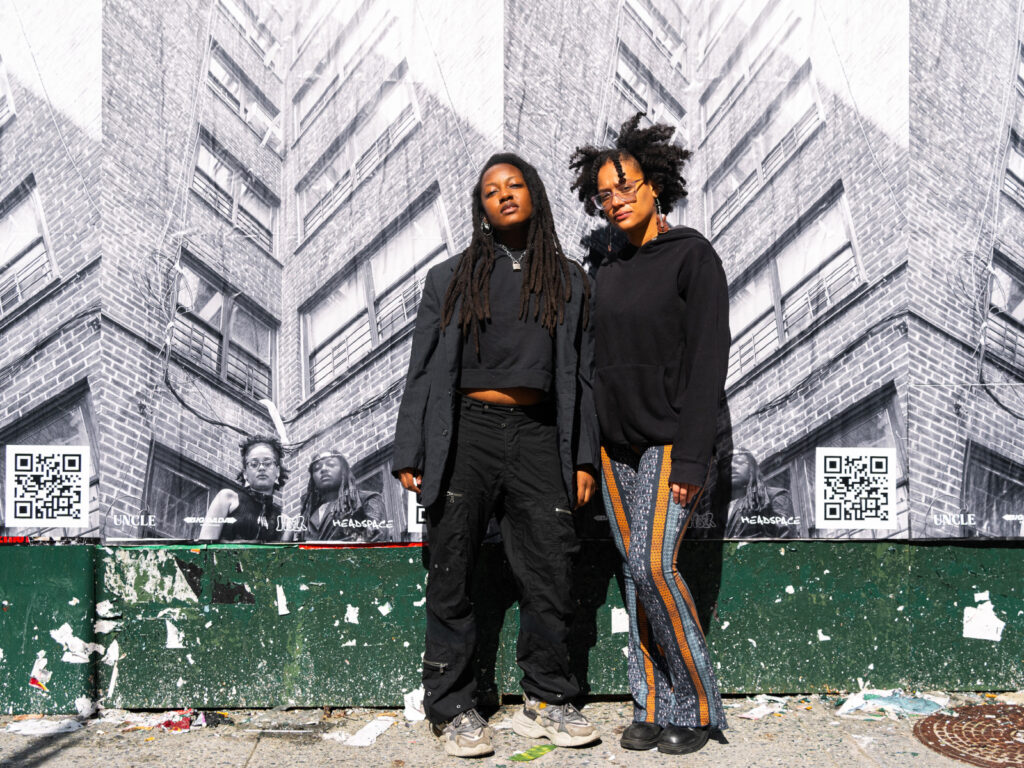
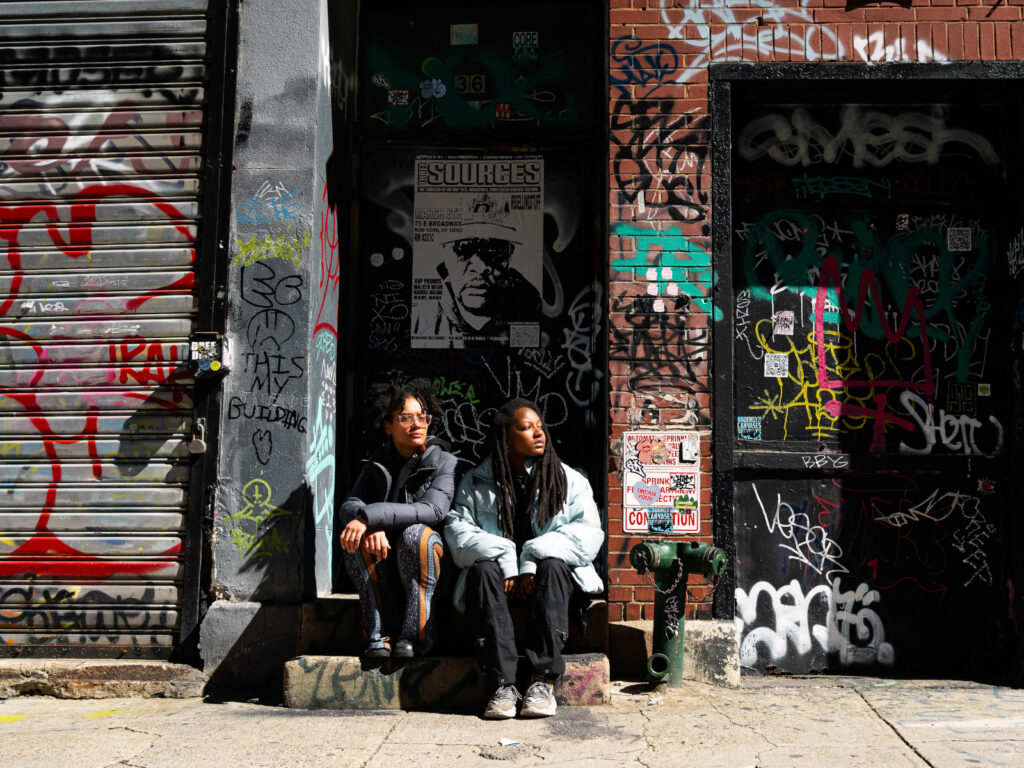
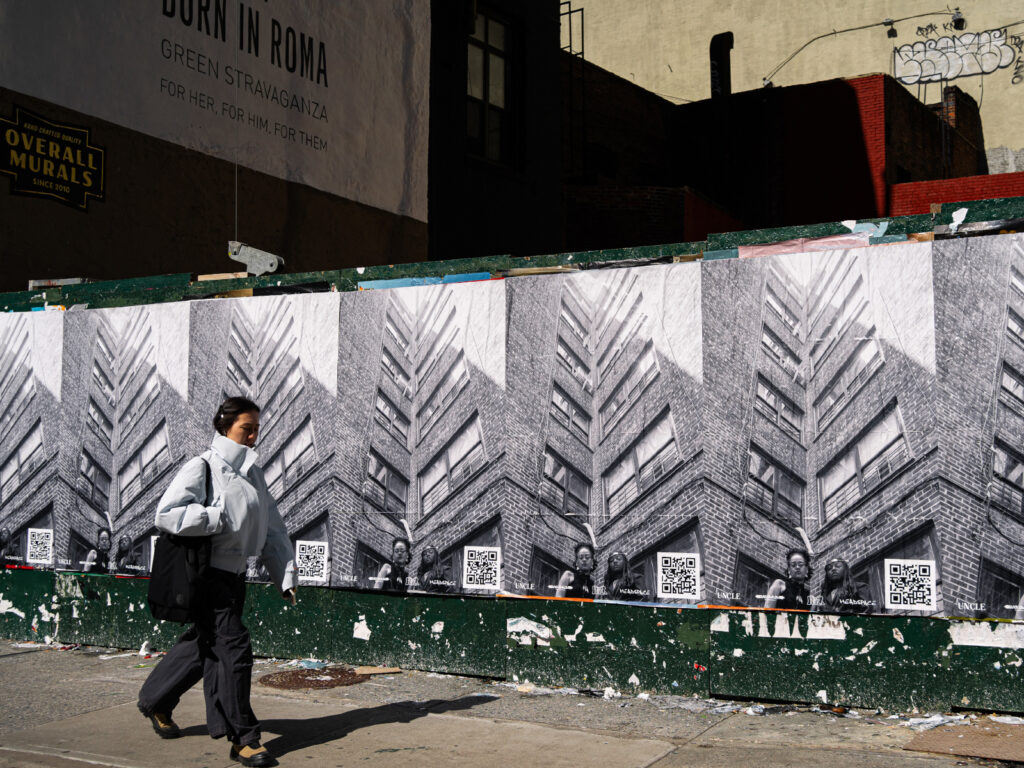
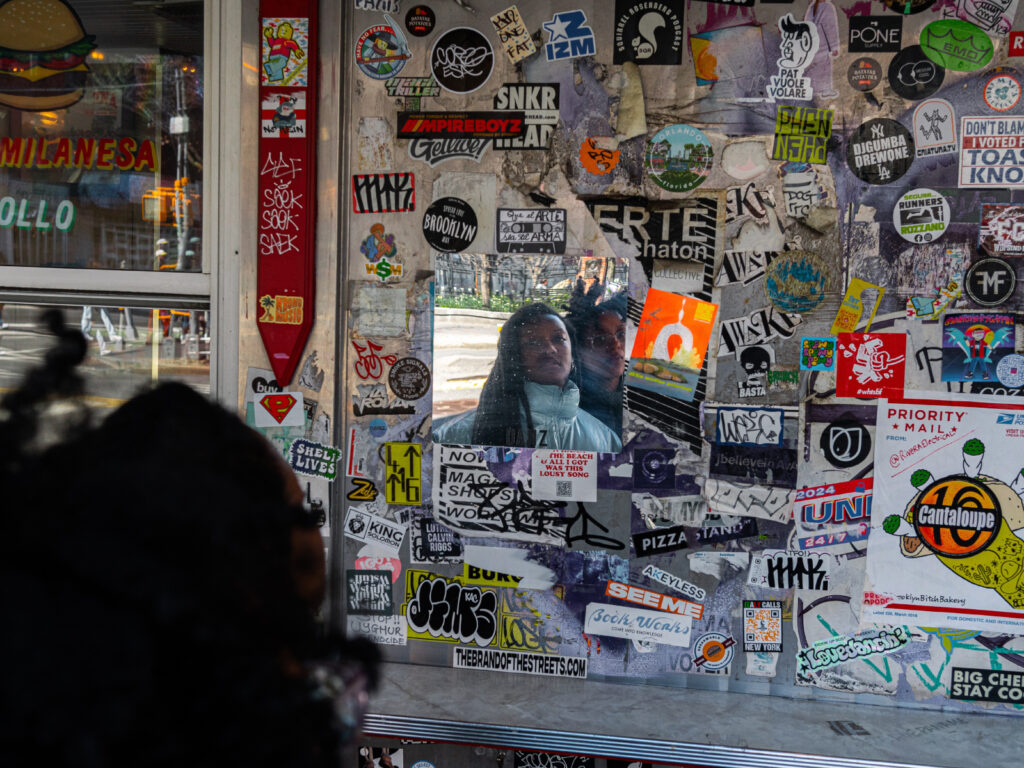

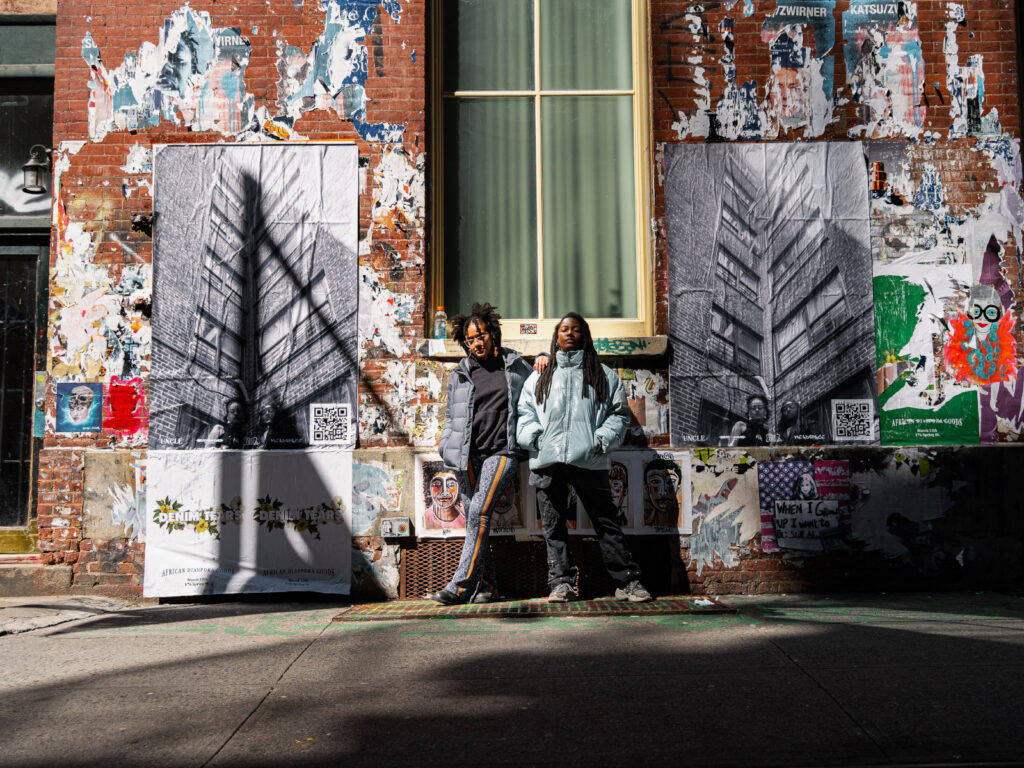
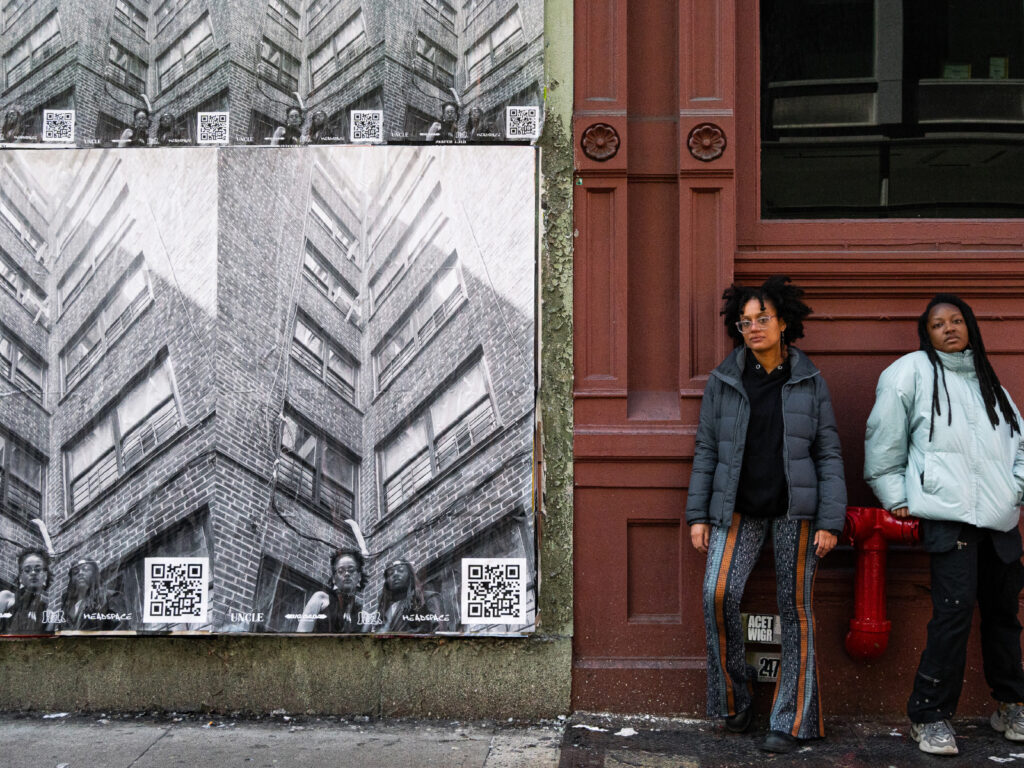

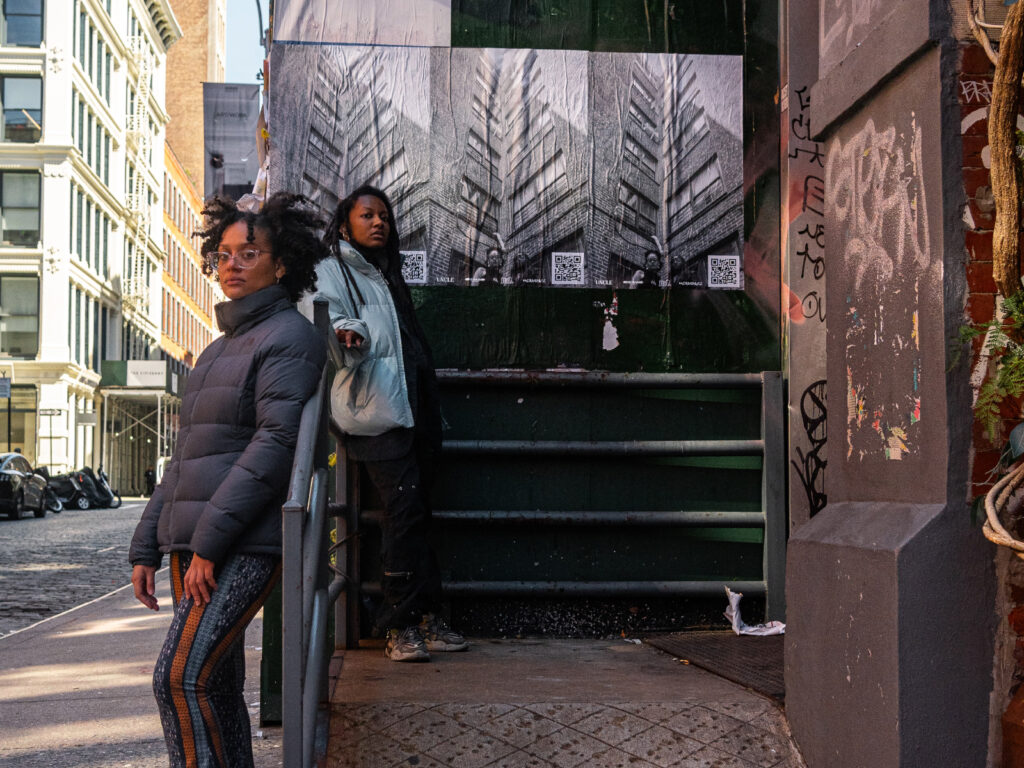
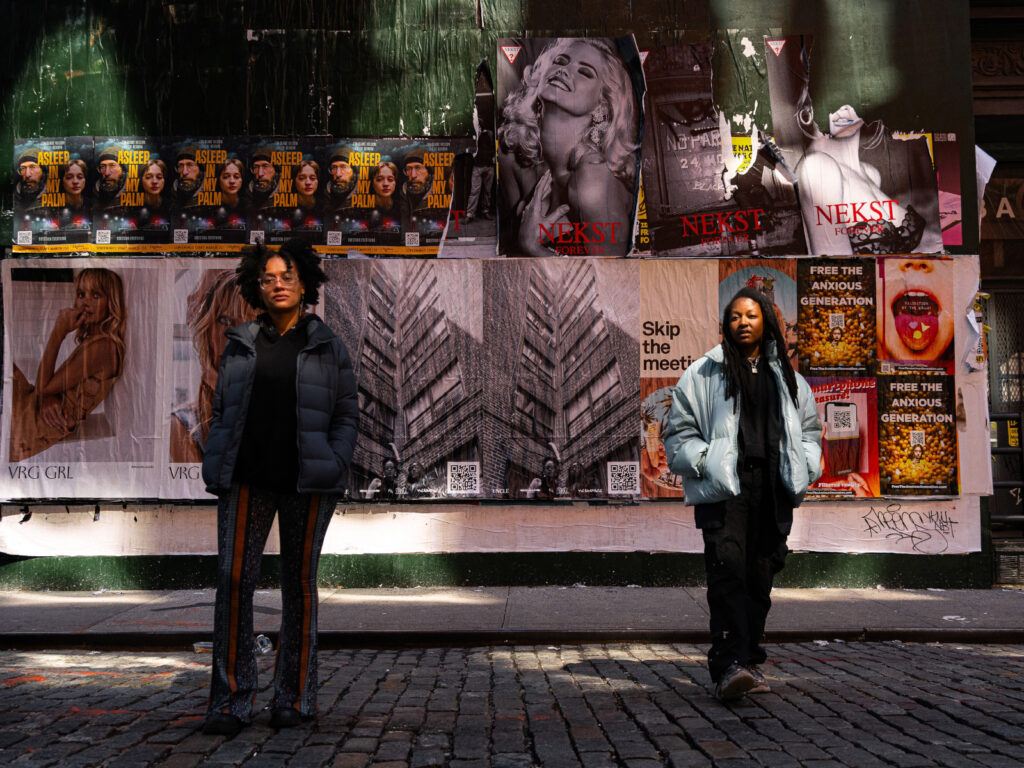

Horrox has been hotting up the fashion scene with a poster campaign popping up internationally courtesy of UNCLE. Our continued partnership with the androgenous clothing brand seems an opportune moment to home in on the effective and varied methods UNCLE uses in cities worldwide to create campaigns worth talking about.
London is the foundation of UNCLE’s existence; we were borne in the rebellious beginnings of the fly format, it’s our roots. Our mindset for our home market tends to be ‘go big or go home’, using all our format types to create a high frequency and saturated campaign across the city. Whether that be three billboards in a row for a street takeover or a paste up to play with a unique square creative, Horrox took advantage of all this city has to offer.
European markets themselves each carry with them individualistic elements that are iconic in their own rights. Amsterdam always makes for a campaign that transitions to the digital well, being a city so instantly recognisable, our sites work wonders across social channels. Barcelona, a sunny haven where pillars cut through crowds, high foot traffic are always on the cards for those who are displayed here. Ever the crowd pleaser is Berlin, a sought-after mecca for brands that like an edge, our sites have an industrial feel, and this grittiness certainly added a sense of intrigue to the Horrox campaign itself. Milan – one of the world’s fashion capitals – it’s sunny streets and refined site design always lead to a clean looking outcome for campaigns, a favourite of brands going for class. Finally, we have Paris, whose arguably most important feature being the context that comes with it – all things fashion needs to have a presence here. A combination of these cities made a unified stamp across the continent for Horrox and built brand image in alignment with each city’s perspective.
Let’s not forget our overseas cousin America – a beast that brands always want to conquer. The cities Horrox appeared in are all key players in the vast market that makes up the country. Whether the relaxed west side with Los Angeles and San Francsico – where your poster can be backdrop to a beach walk and golden sunset or the red-hot west side that offers a streetside catwalk in fashion hub New York or a fiery addition to Miami’s iconic skyline. Horrox is a brand based in Brooklyn, and the campaign felt at home amongst its streets, UNCLE made sure to emphasize the homecoming with a focus on distribution surrounding the area.
Tokyo needs no introduction; the powerhouse city of the east has an unmistakable feel. Formats here are clean cut and perfected – an apt style that seems to reflect the general feel of the city itself. Due to lack of competition with advertising space, Horrox had no trouble standing out against the brutalist architecture. The striking red was a key colour in eyeline with all onlookers, working perhaps best on the digital screens that offer a distinct look that posters cannot replicate.
The true definition of global includes that of Australia; laid-back and homegrown posters here feel part of the woodwork and have no trouble looking like they belong. Sydney makes for a city that offers a casual edge that capitals tend not to include, this only grounded the Horrox campaign and approachability is important within advertisement. Whereas Melbourne delivers on locations that are unmissable, want to be noticed? Melbourne is the one for you if you want eyes down under.
Every city offers its own opportunities, and if you can align yourself with the pulse of that city you can appeal to its onlookers. Horrox was at home in all markets, reaping the benefits of the cultural markers and standing out amongst the grey.

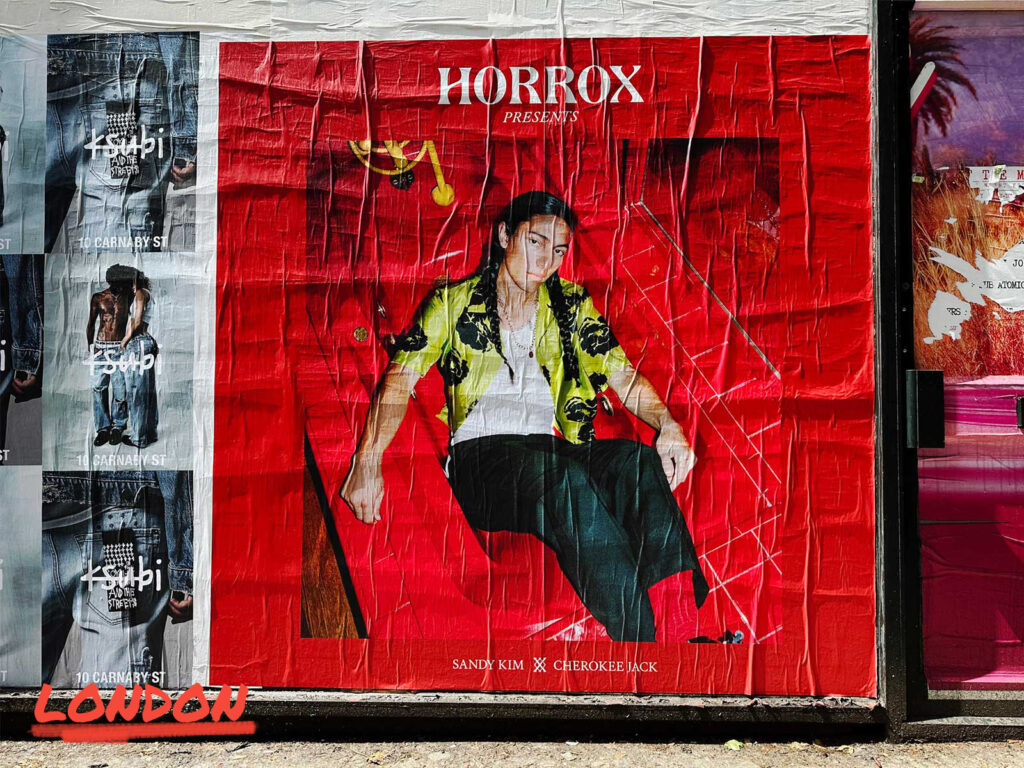

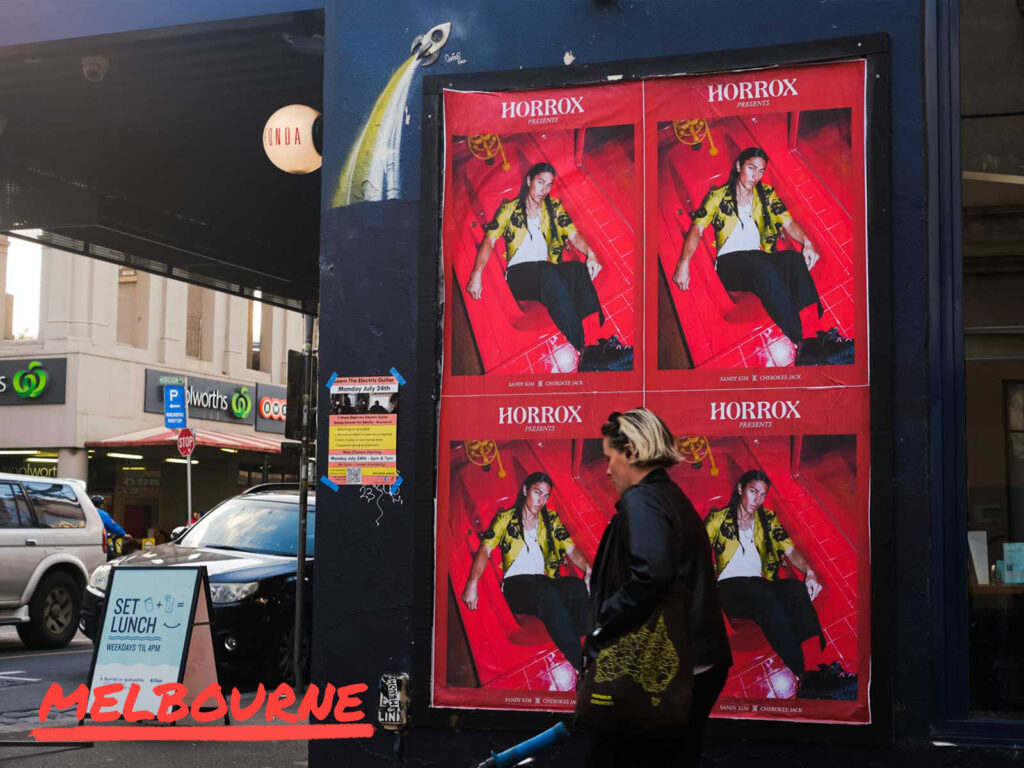

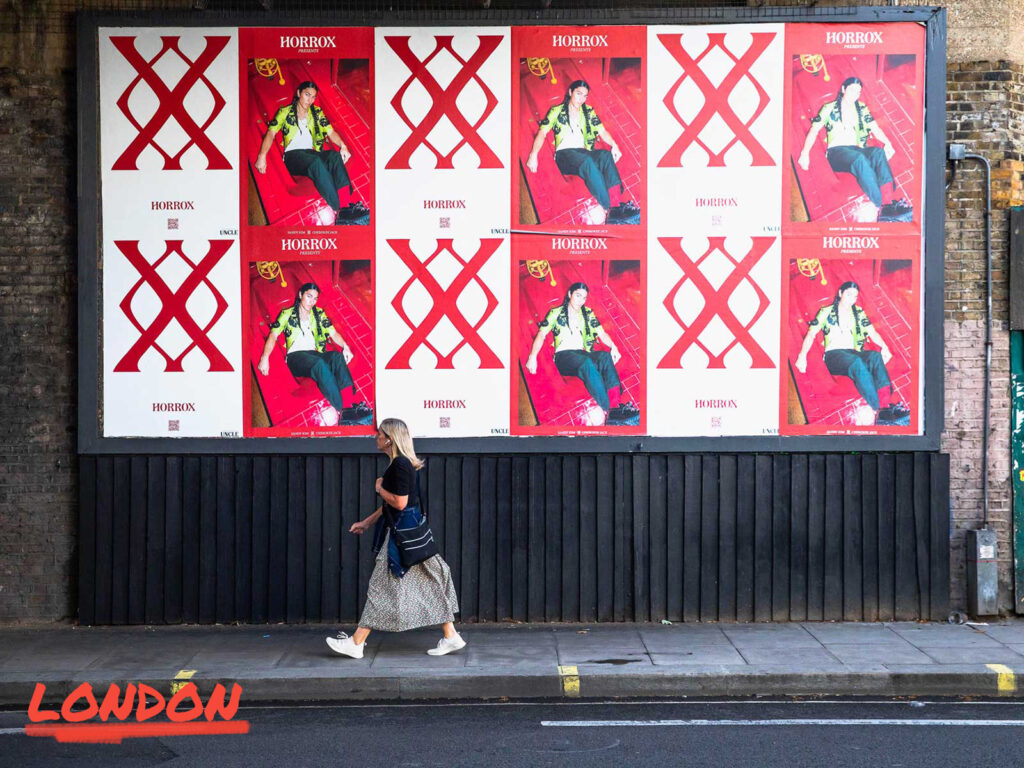
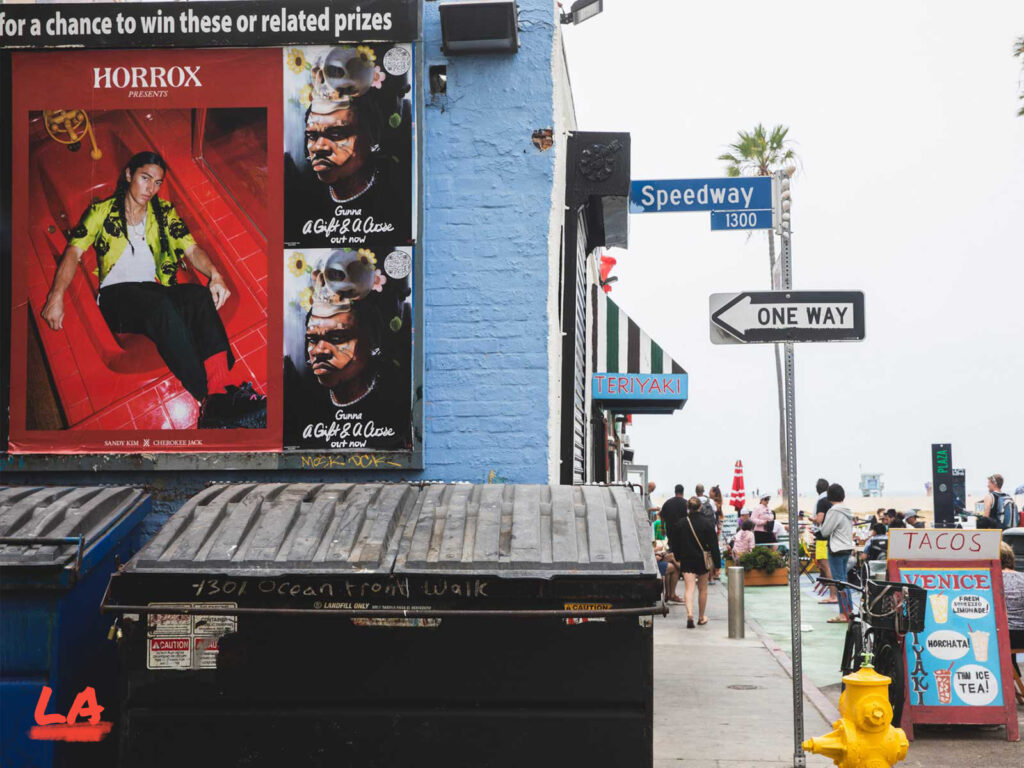
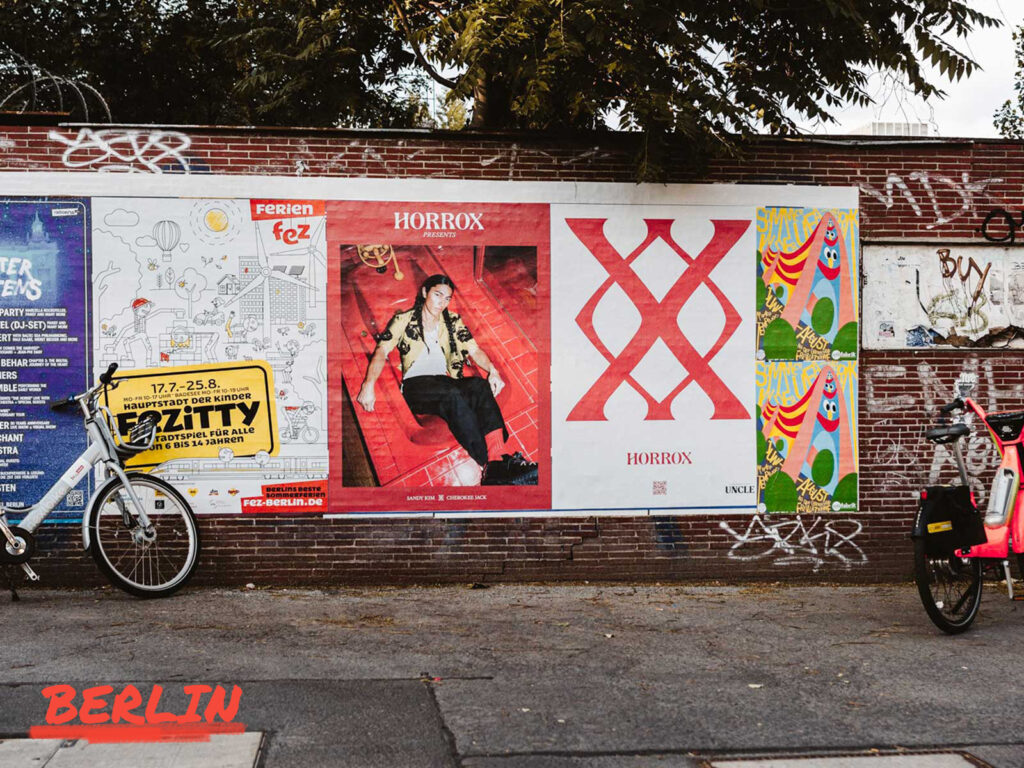
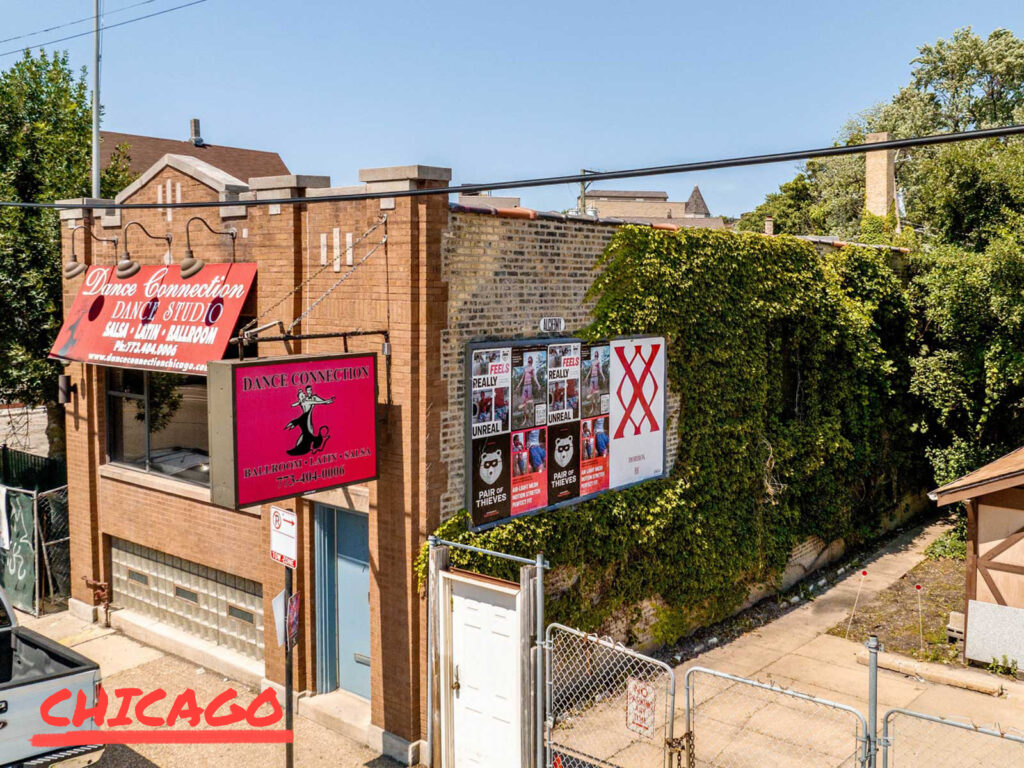
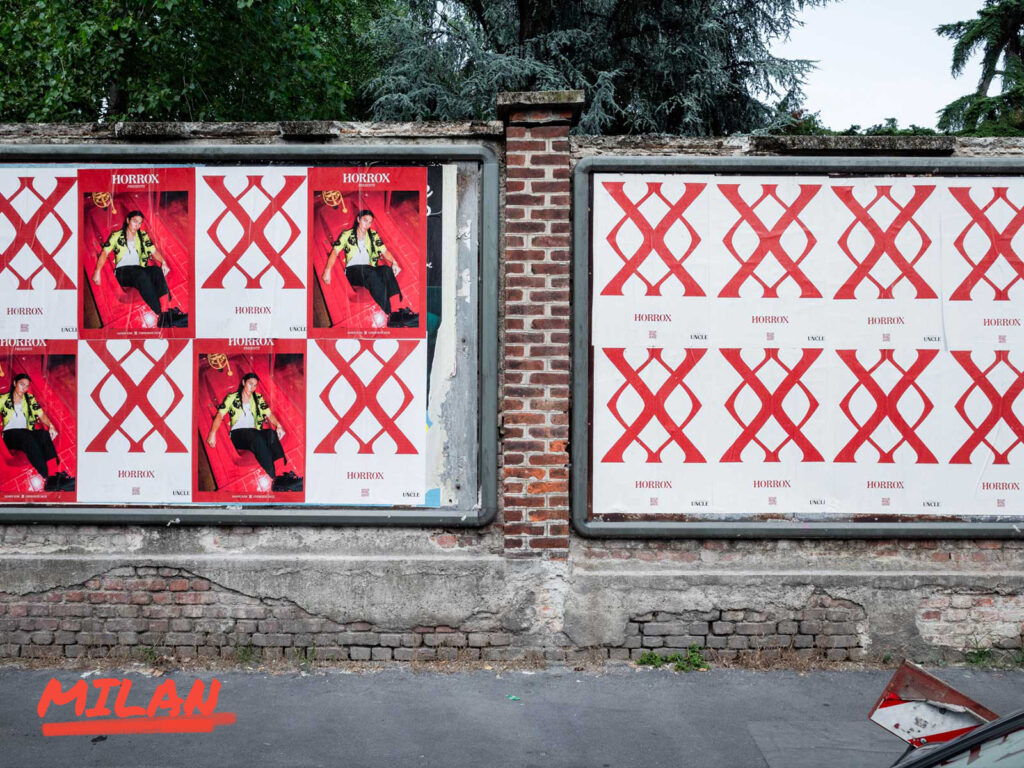

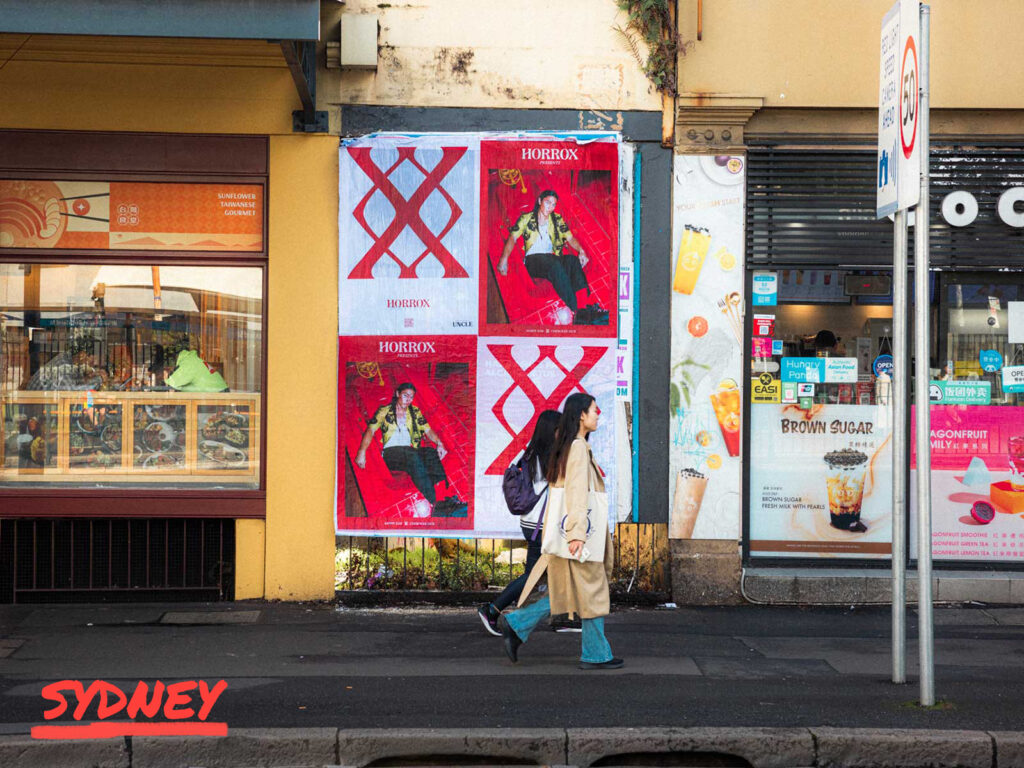

Horrox is not a brand that exclusively pulls from the past but also the present, with some of its most prominent pieces being collaborations with artists and charities. In continuation of UNCLE’s partnership with Horrox we put a spotlight on one of these collaborators. JV Aranda, an artist based in San Francisco uses a mixture of colour, printing and repetition to make an impact with his graphic designs. His playful graphics prioritise impactful, layered motifs that are reminiscent of a pop art and dadaism which seemed a fitting match for the first collaboration of Horrox as the brand also borrows from the past for its creative direction. We took a spotlight and enquired about how his contemporary techniques and style have developed as he’s grown as a creator.
HOW DID YOU GET INTO ART?
Fortuitous museum visits during my formative years. For instance, in 1998, while on a trip to Los Angeles to celebrate my 16th birthday, I had the good fortune of being introduced to the work of Yayoi Kusama via a retrospective exhibition of her work at LACMA, which was mind-blowing and incredibly influential in a multitude of ways: from her enthusiastic experimentation across different mediums to how her practice overlapped with her mental health, nationality, gender, era, and pure intuitive visual talent. Her work has always served as a wonderful example of the limitlessness of Art as a storytelling device and her resilience and prolific output continues to be an inspiration.
WHY COLLAGE?
Collage was always a medium that just made sense to me since first being introduced to it at school. The materials needed were accessible and the process of destruction, manipulation and reinvention has always felt liberating and cathartic.
Additionally, with the amount of content being generated daily in this day and age, Collage has grown in importance as a method to utilise the world’s growing collective archive, showcasing and re-contextualising imagery that would otherwise be ignored or forgotten.
DESCRIBE YOUR DESIGN PROCESS?
It’s a mix of following my intuition and problem-solving. I’ve always loved being commissioned and receiving a brief to interpret with various constraints to meet. So the design process can vary due to the project at hand, and my favourite experiences have been the ones that allowed me the opportunity to widen my scope and try new things, like working with Horrox, which gave me the chance to use the comic-strip panel format as a structural device and incorporate speech bubbles in my work for the first time.
WHAT IS THE THING YOU LIKE MOST ABOUT BEING AN ARTIST?
I love how artwork can form a life of its own while retaining that psychic link to its creator, who essentially become visually invisible when the work is finished. As a Queer, Person of Colour, creating artwork feels like one of the few realms in which I’m not immediately judged by any of my physical or sociological attributes, though my work is always representative of all of those things purely from being filtered through my vantage point.
TELL US MORE ABOUT THE COLLABORATION WITH HORROX?
Legs somehow found my work out there in the ether and got in touch with her vision for the prints that she had wanted to commission for Horrox. I was enthused after being introduced to her work and learning where she wanted to go conceptually with the prints and was pleasantly surprised to discover the strange parallels we had with one another; Namely that I was an American living in the U.K. at the time and that she was British and living and working in my home state of California.
WHY ARE YOU DRAWN TO USING COMIC STRIPS IN YOUR WORK?
When working with Comics, I’ve primarily been drawn to utilising work from the Golden Age of American comics, which spans from the 1940’s and 50’s, since I not only enjoy the aesthetics of that era but additionally have gotten a kick out of re-contextualising work that was originally found in arguably quite wholesome environments, and reconfiguring the work with more modern narratives that reflect our current realities and collective discourse.
HOW HAS CALIFORNIA AND LONDON INFLUENCED YOUR WORK?
Growing up in California, I was surrounded by pop culture and the grandeur of nature. I was essentially raised by cartoons and theme parks. And I’ve often felt that the hyper-saturated colour palette of my work is very much informed by being a Californian. Living in London was quite a contrast and helped me realize that pursuing the arts was not only valid but important, and it was incredibly inspiring to be in such a global and diverse city, absorbing such a range of stories. My work may be incredibly influenced by California conceptually, but I learned how to become an artist thanks to London.
HOW HAS SAN FRANCISCO HELPED SHAPED YOU AS A DESIGNER?
When Legs got in touch about the commission, I was living in London and when she mentioned she was based in San Francisco at the time and wanted the prints to reflect the city and it’s musical history, specifically during the Jazz age, I was absolutely delighted as a former San Franciscan, previously living there for a number of years in the early 2000’s, back before I even realized I was an Artist and Designer. So, I’d say my time in San Francisco planted a lot of seeds, that still grow to this day. There’s an organized chaos to the city, or rather, a battle between structure and hedonism, that definitely shapes my work.
DOES THE CITY INSPIRE YOU?
Absolutely. Living in San Francisco was my first experience as a young adult with the wonder and perils of embracing spontaneity. I was raised in San Diego, which is very much a car-based city, so it was quite liberating living in San Francisco, which is much more pedestrian friendly. I’ve always been inspired just walking around the city and getting immersed with the different personalities of both the different neighbourhoods and the characters who happen to be around on any given day.
WHAT ARE SOME OF YOUR FAVOURITE PLACES THERE?
I’m biased towards the neighbourhoods I previously lived in: the Castro and the Mission, which includes my absolute favourite place in the city, smack dab in the middle of those areas: Mission Dolores Park, which is situated on an incline with a gorgeous view of Downtown San Francisco, and has been the setting of many meditative walks, sunny celebrations and heartfelt conversations with loved ones in the past.
WHAT’S NEXT FOR YOU?
More Collages! Currently, I work as an Editorial illustrator for a variety of clients. Most recently, I’ve been working with the esteemed American automobile magazine, Road & Track, creating collages for a column called the ‘Department of Overthinking’ and I’ve also begun to participate in different art fairs, showcasing all of the different adaptations of my Collage work, in preparation of opening Sinewy Sea Fine Art, which will be a hybrid of an Arts Space, Tea Lounge and Gift Shop, showcasing modern curiosities and storytelling, to be based in San Diego.

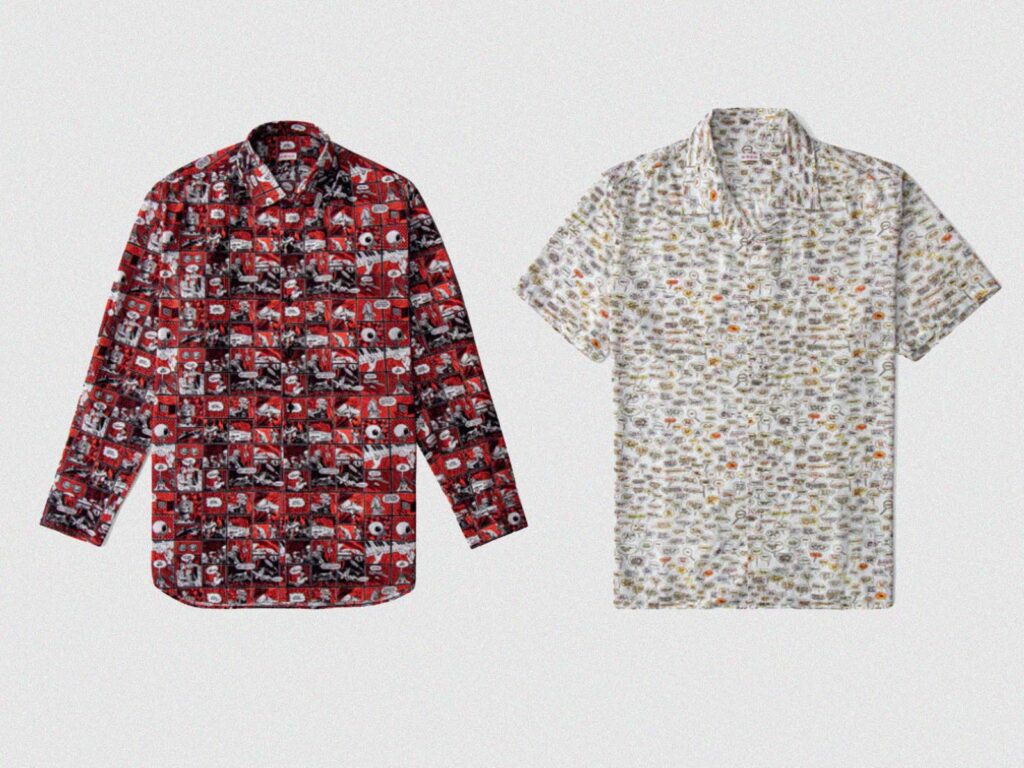
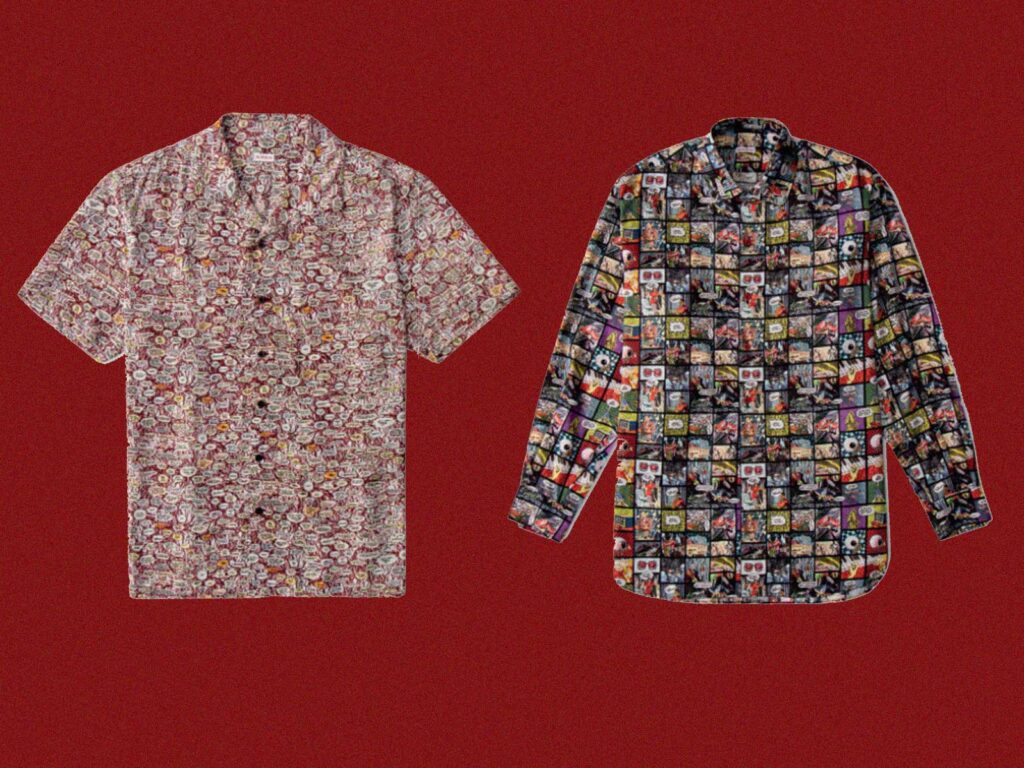
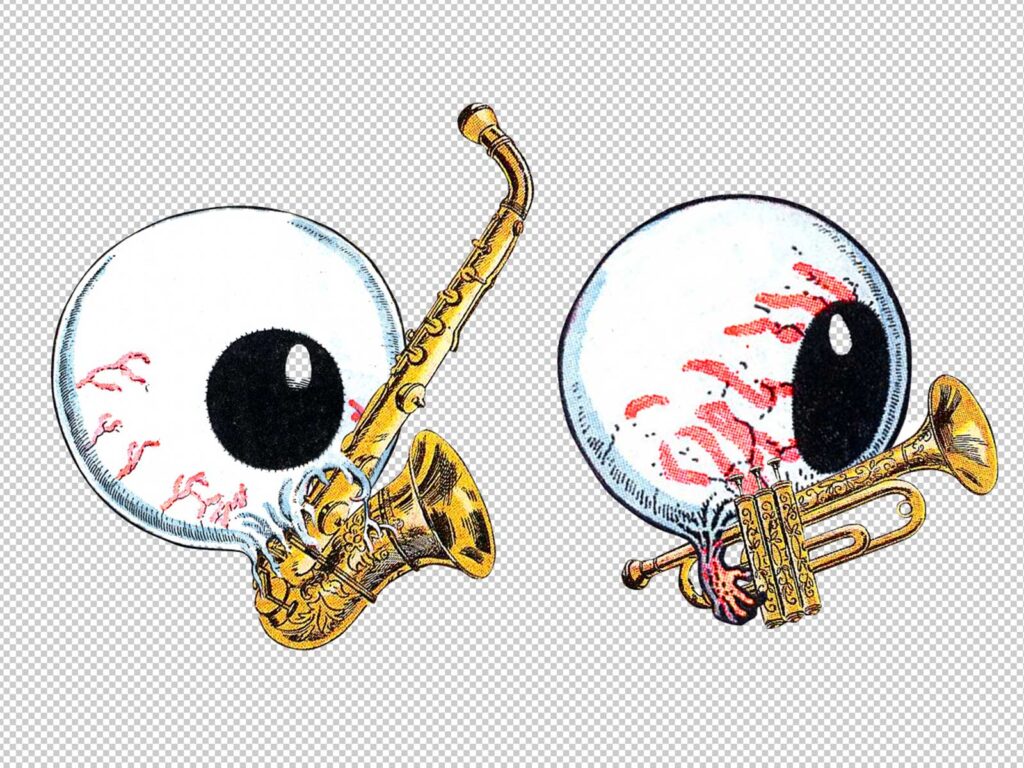
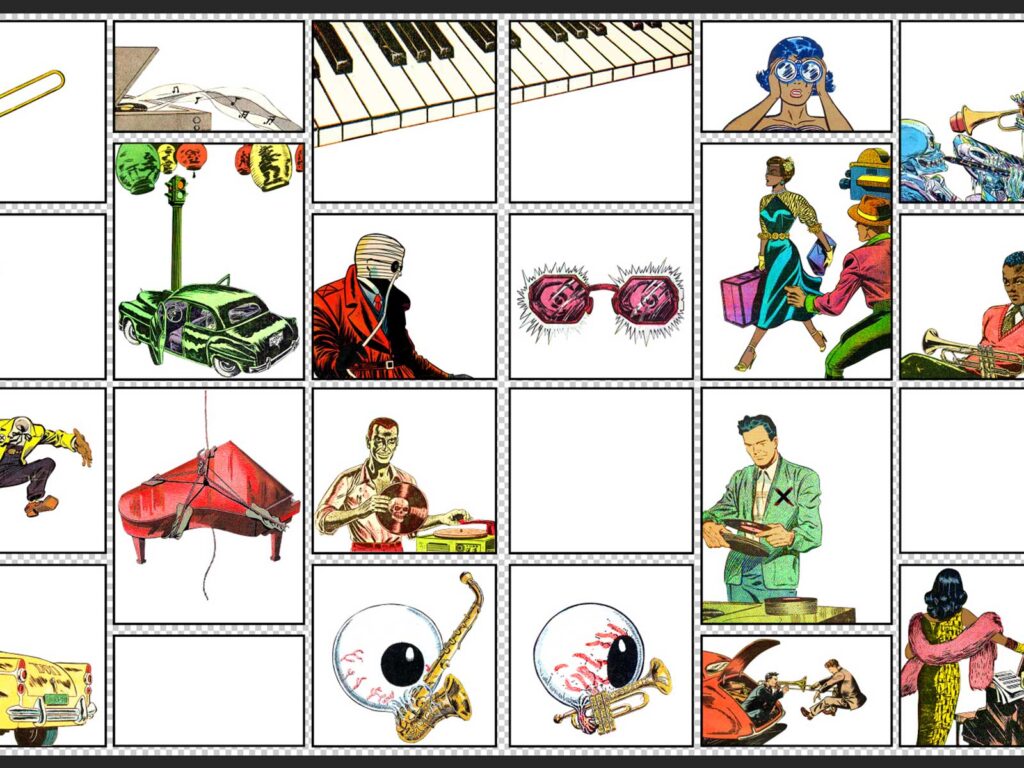
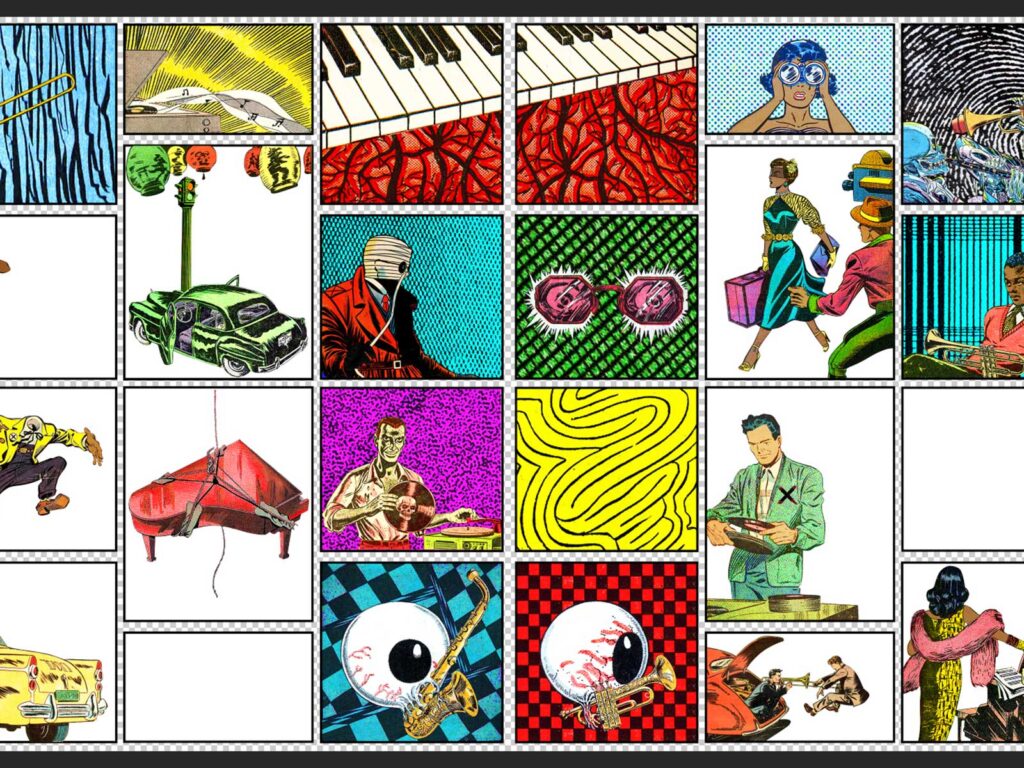
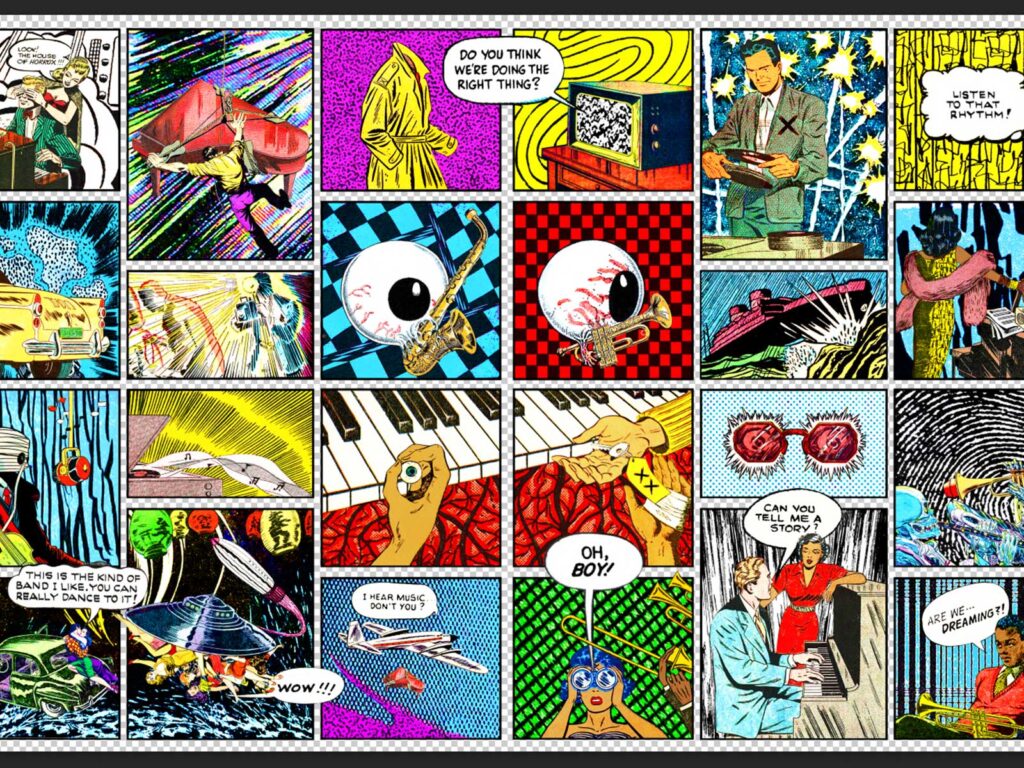
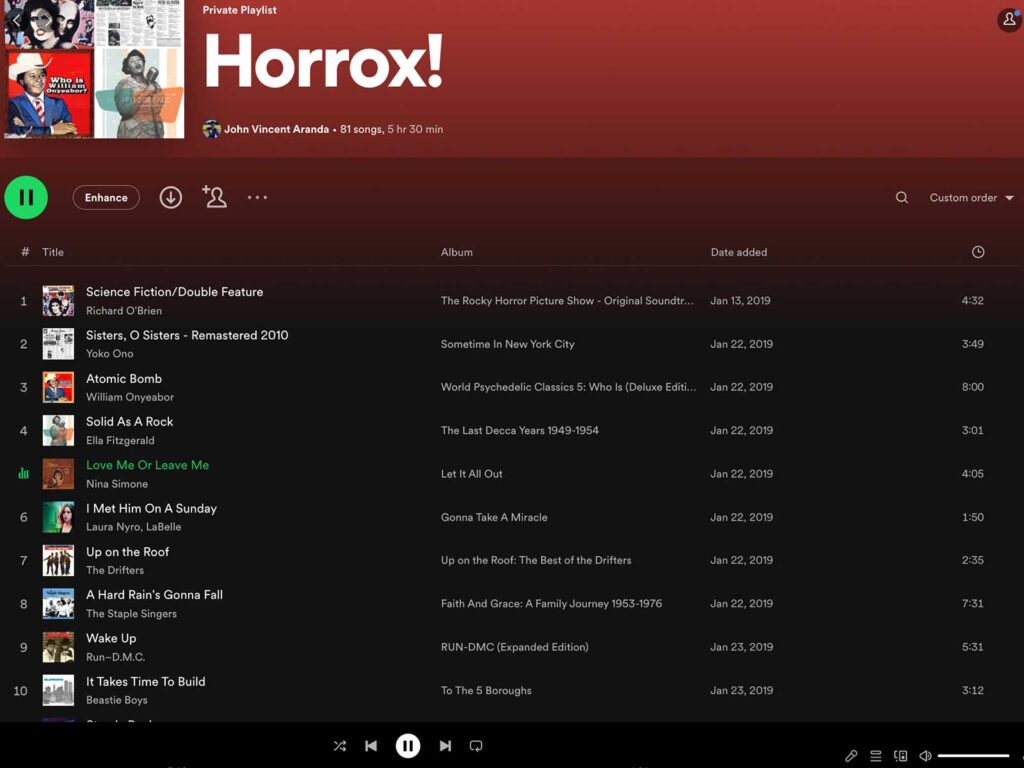
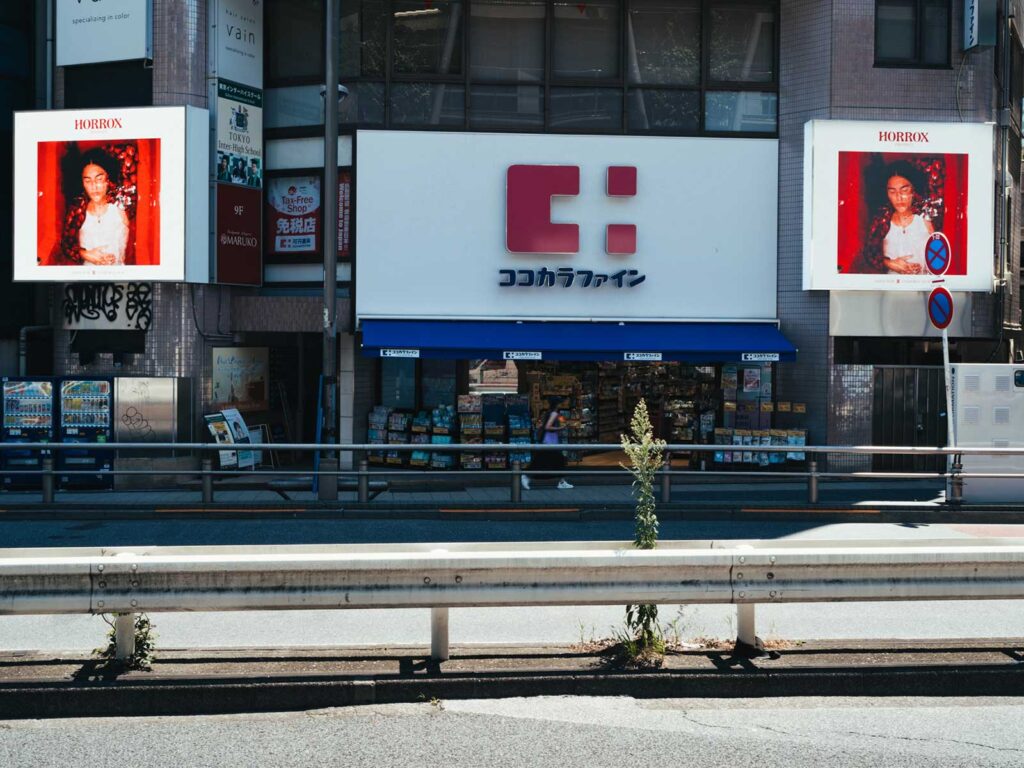
Based in Brooklyn, New York fashion brand Horrox are launching their debut collection to a global audience promising to deliver on an informed and cultural array of designs. Horrox marries culture, art, music and collaboration with fashion that culminates in an informed yet edgy drop. This emerging fashion brand seemed a great match for UNCLE to support in their beginnings with a partnership.
Horrox was born of music. From the intrigue of record sleeves and music publications, to clothing synonymous with music subcultures throughout history, it all serves as muse for the core Horrox product. Whether it be the new wave stylings of Talking Heads or punk rock powerhouse The Clash, the brand infuses distinctive eras into its pieces with a modern edge. These aesthetic choices could often misinterpreted as vapid, but instead are rooted in politics, class structure and other poignant moments within the zeitgeist. Horrox revels in research that elevates design beyond the visual and strikes a balance between concept and composition.
The brand’s founder – Riona Horrox – a graduate of the Royal College of Art used Motifs have most commonly been drawn from the ‘77 punk era, alongside elements that borrow and modernise 50s and 60s styles. Shrunken t-shirts and jeans lend themselves well to the inherited seventies influence on the west coast.
As part of the partnership, UNCLE will be continuing to dive deeper into the core of the brand with interviews with collaborators. This is only the beginning. Fashion can be a portal of education for its audience. Horrox is a brand that plays with nostalgia; style can intertwine with who you are and pull you into whichever community you wish to be a part of – let Horrox be yours.
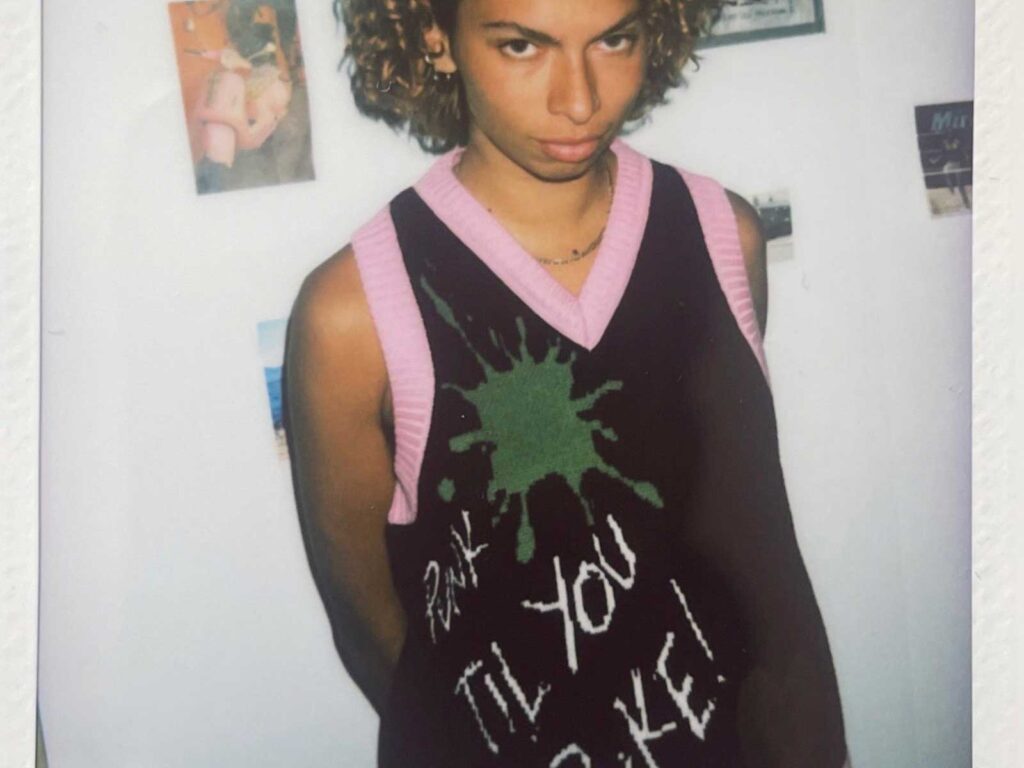

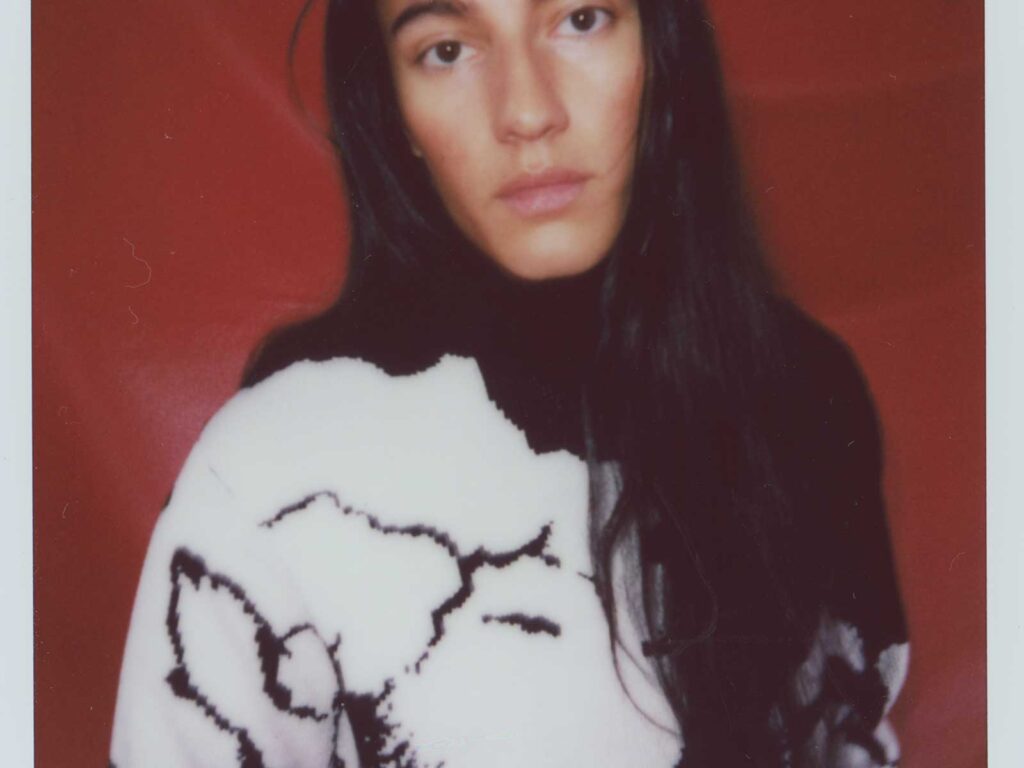

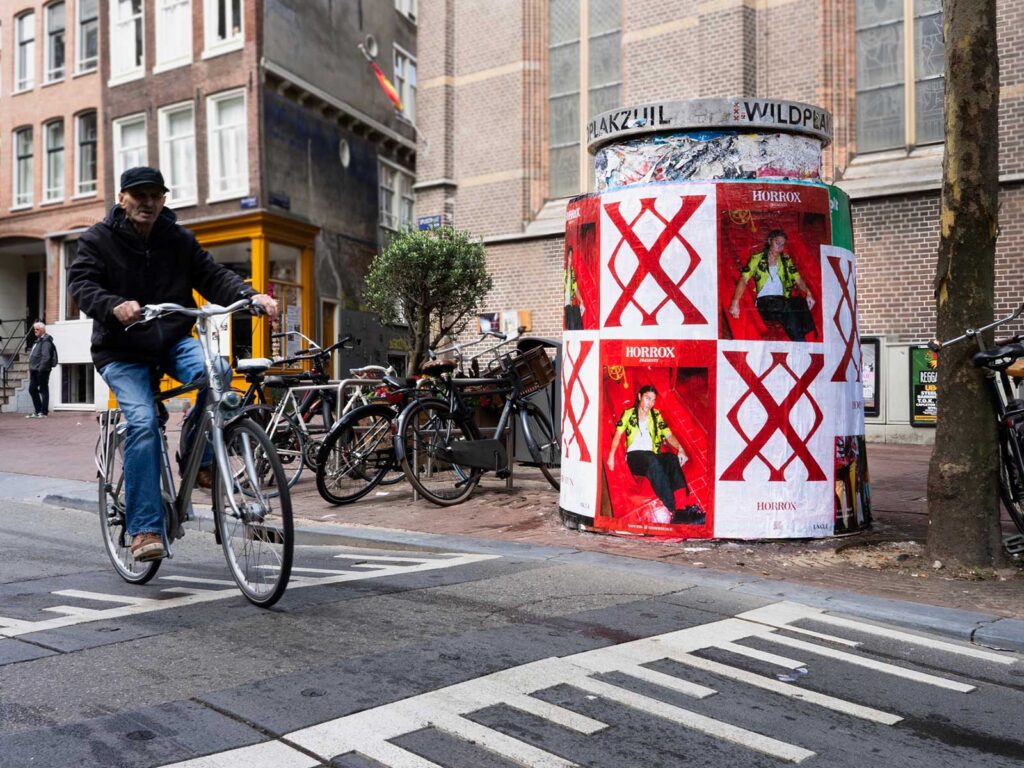

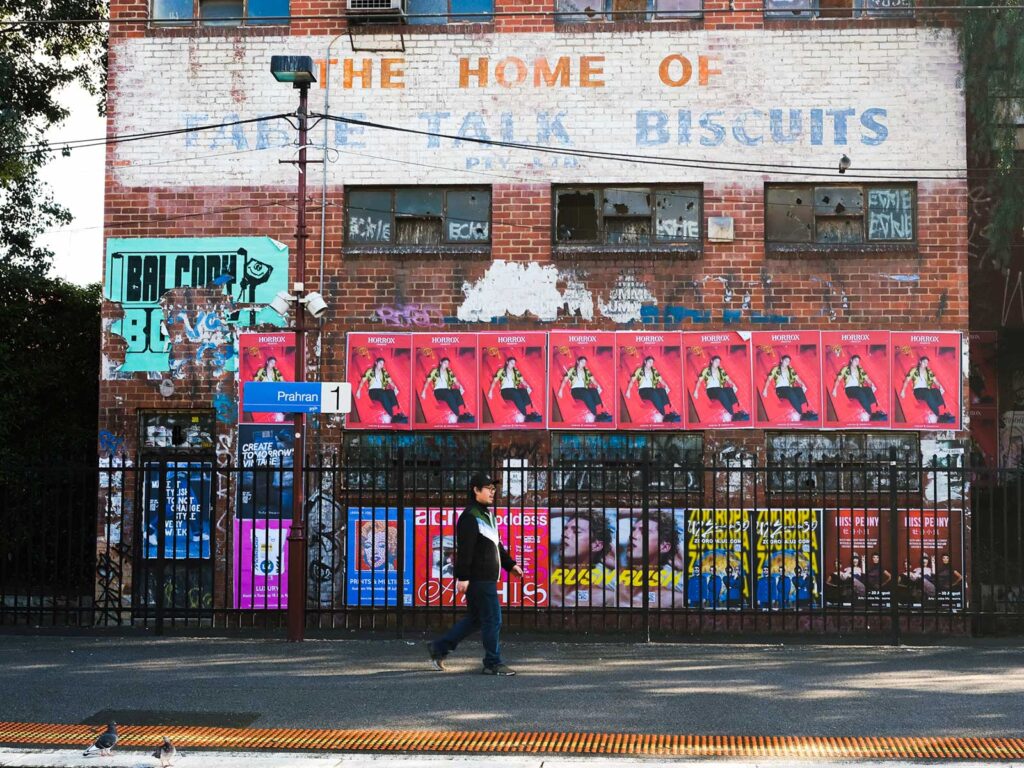
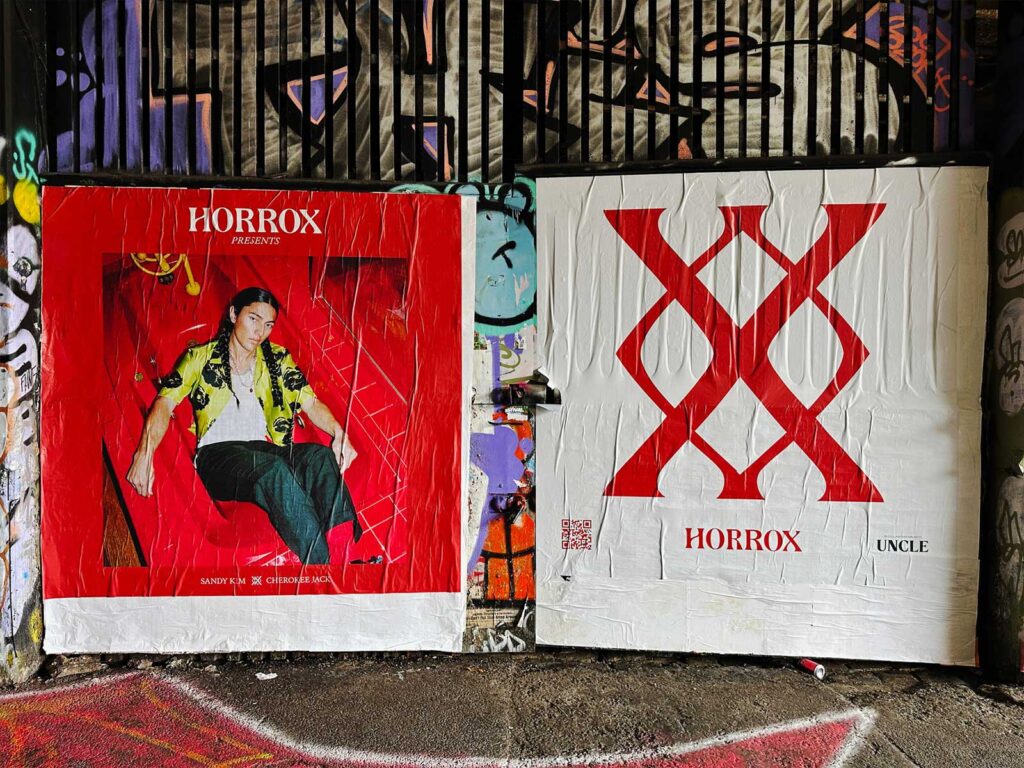

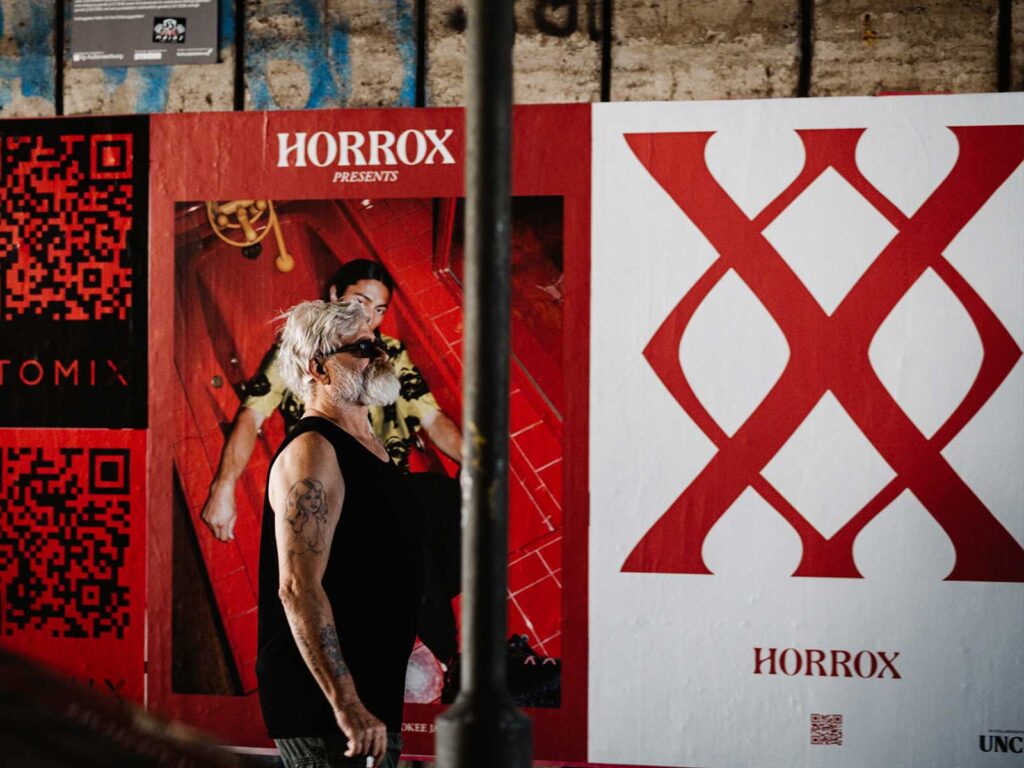

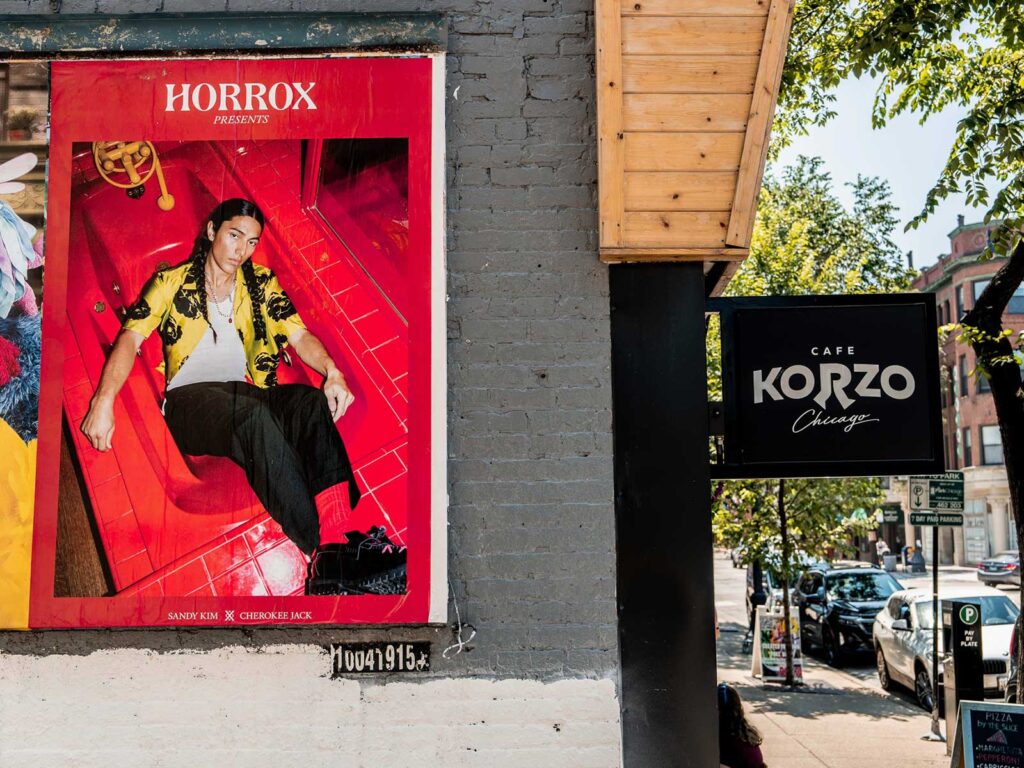
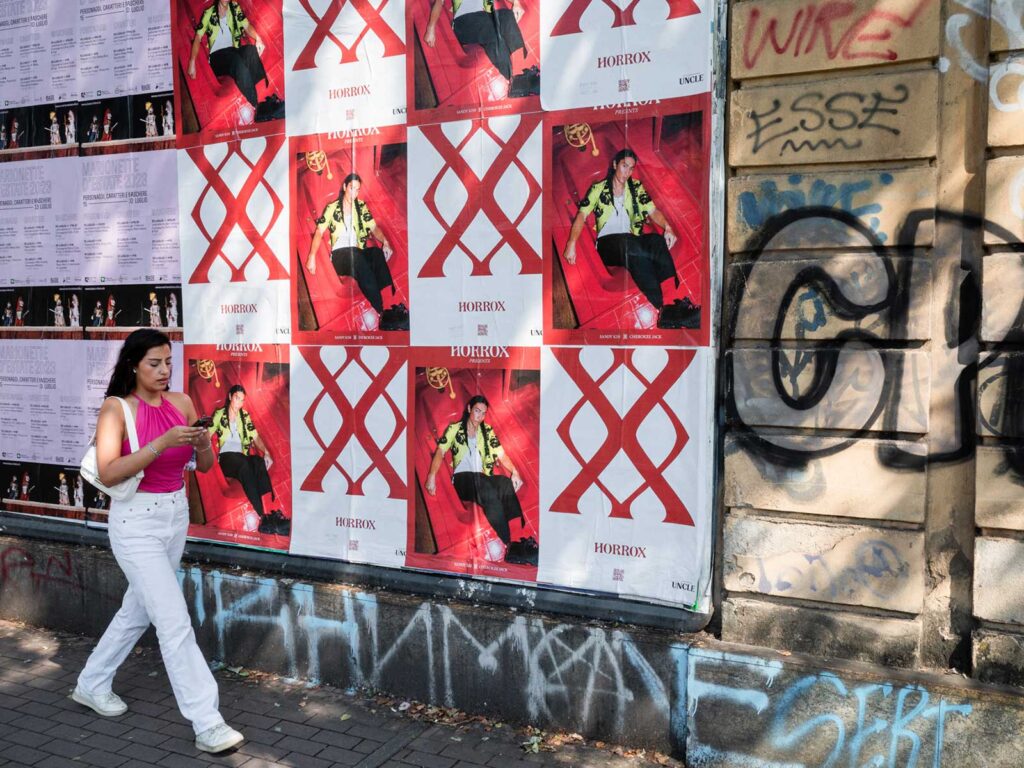


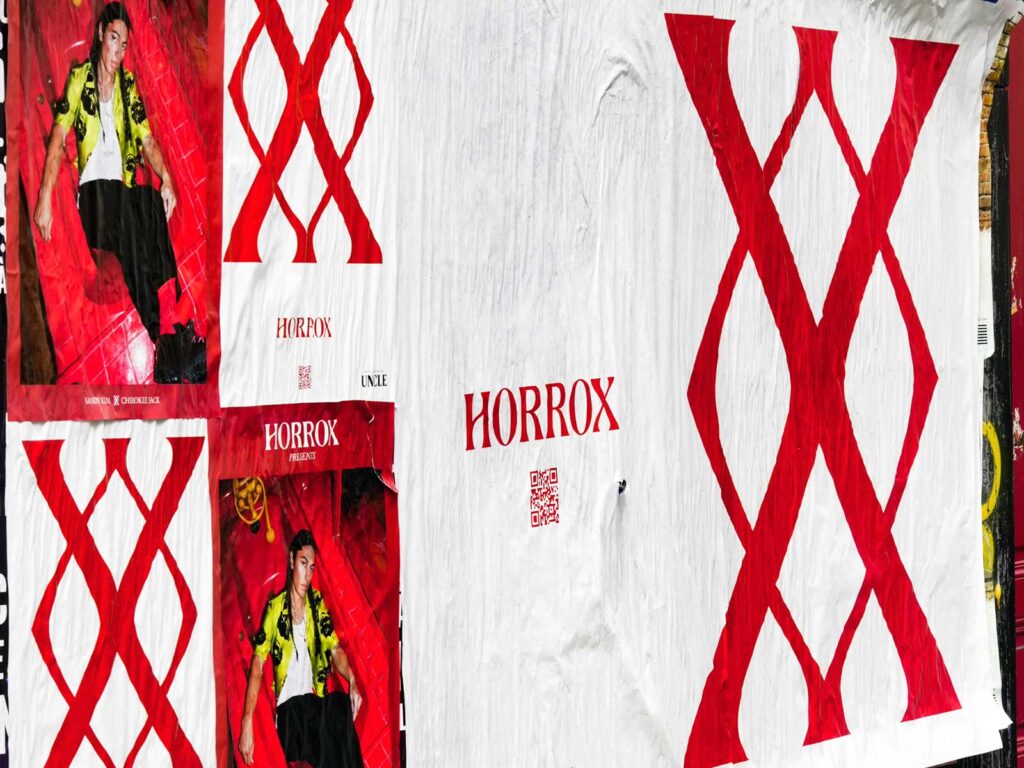
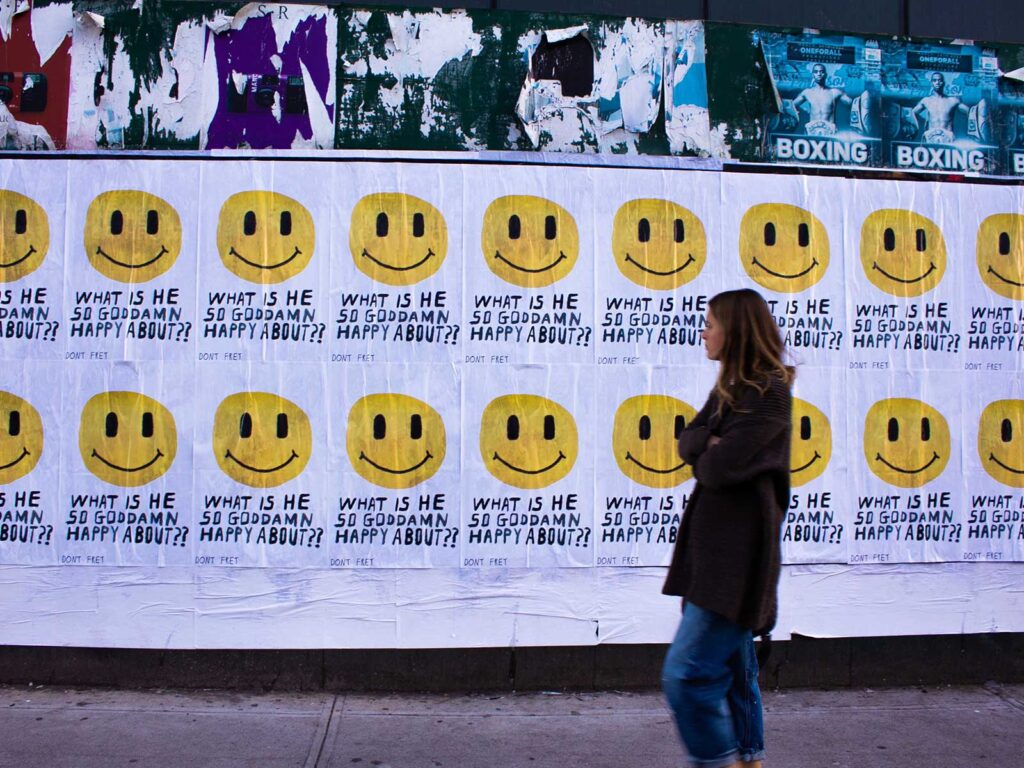
Anonymity and intrigue form the perfect storm for Chicago based artist DONT FRET. His signature illustrated portraits feature a combination of witty remarks rooted in societal commentary and humour. DONT FRET has been able to carve out a place in the zeitgeist that takes advantage of modern-day oversaturation by offering refined and funny critique.
DONT FRET got his start with paste ups and murals so a collaboration with UNCLE felt like a natural fit. We got to work bringing a selection of his pieces to both New York and London. The collaboration features four designs that blend irreverence with thought provoking sentiment – in a world more introspective than ever, his sharp takes feel relevant without being intrusive.
His selection of artwork worked well in the fast-paced cities as a visual break for passers-by. He used sarcasm to pose a question to a smiley face – “What is he so goddamn happy about?” in New York whilst across London he was equally tongue-in-cheek playing with politics and voting habits as well as a metaphoric fly and light – “I know it will kill me but I can’t resist it…”. Perhaps his most famous motif is portraiture and his final offering features a face behind a wall quoting “What are you hiding from? I am hiding from myself”. The collection sees DONT FRET sparking conversation on the streets – winking as he goes.
This is a collaboration with Flying Leaps who are constantly bringing forward thinking artists and their work to light. Check out their website for more on DONT FRET and other upcoming artist spotlights.

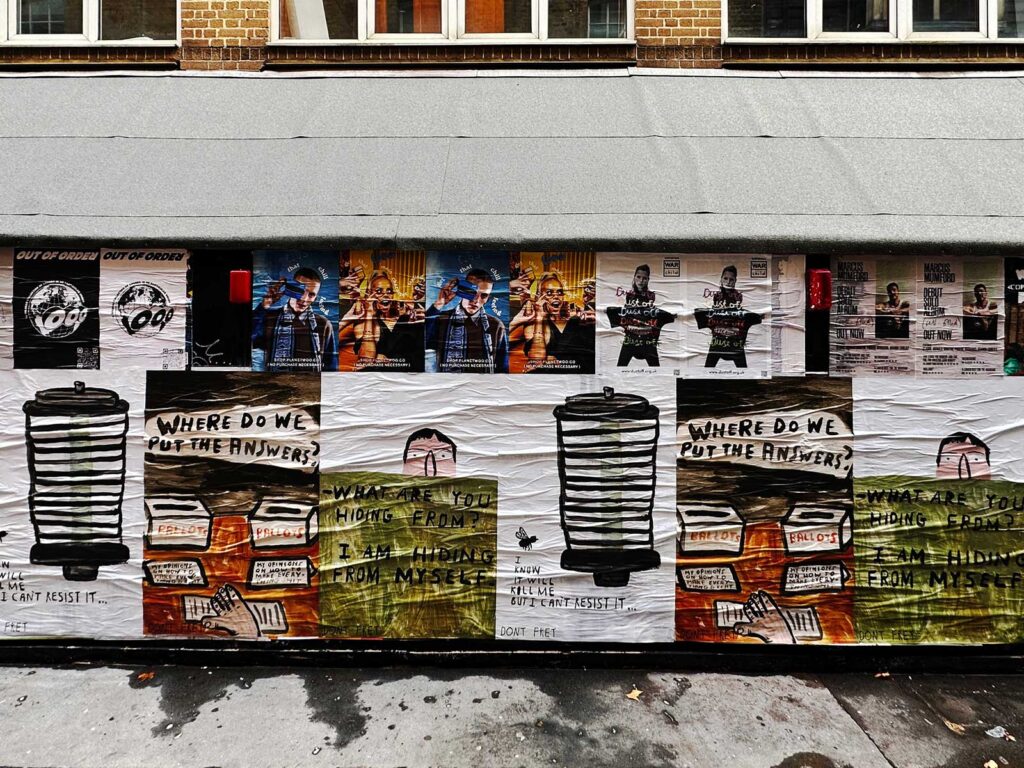
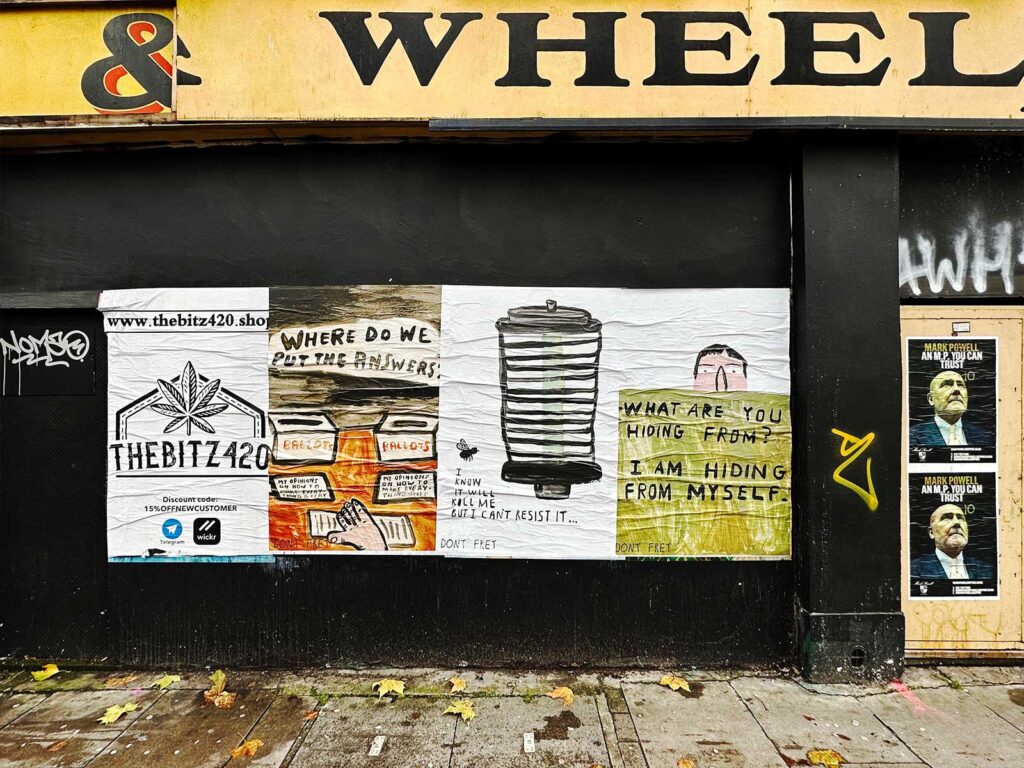
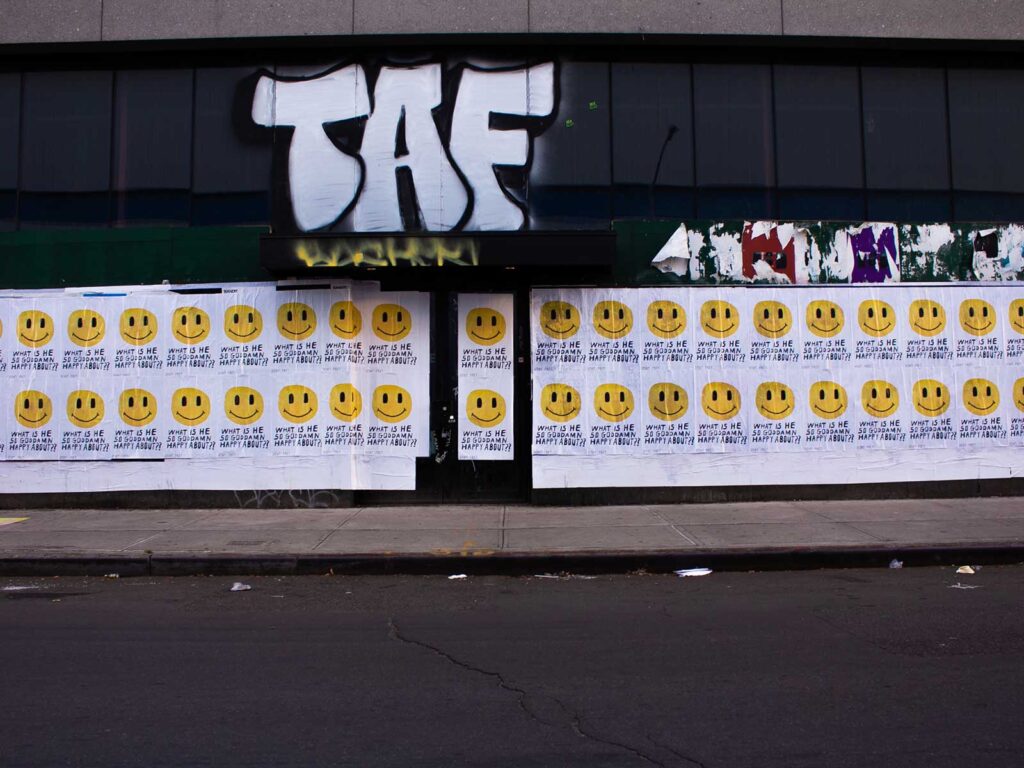
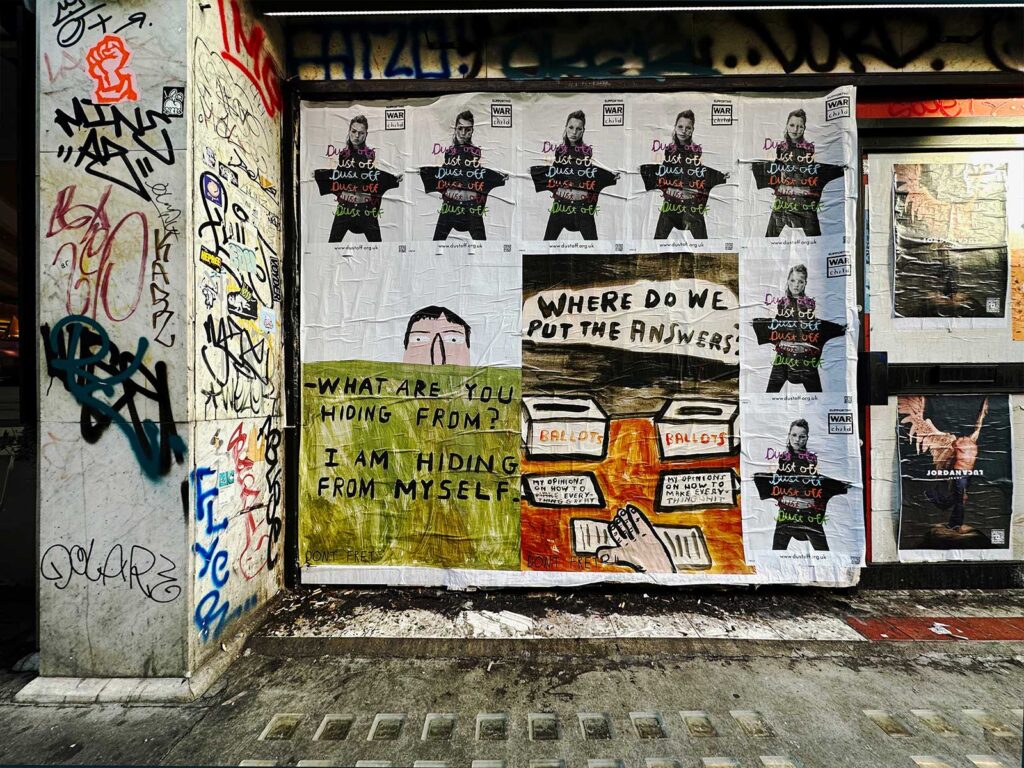
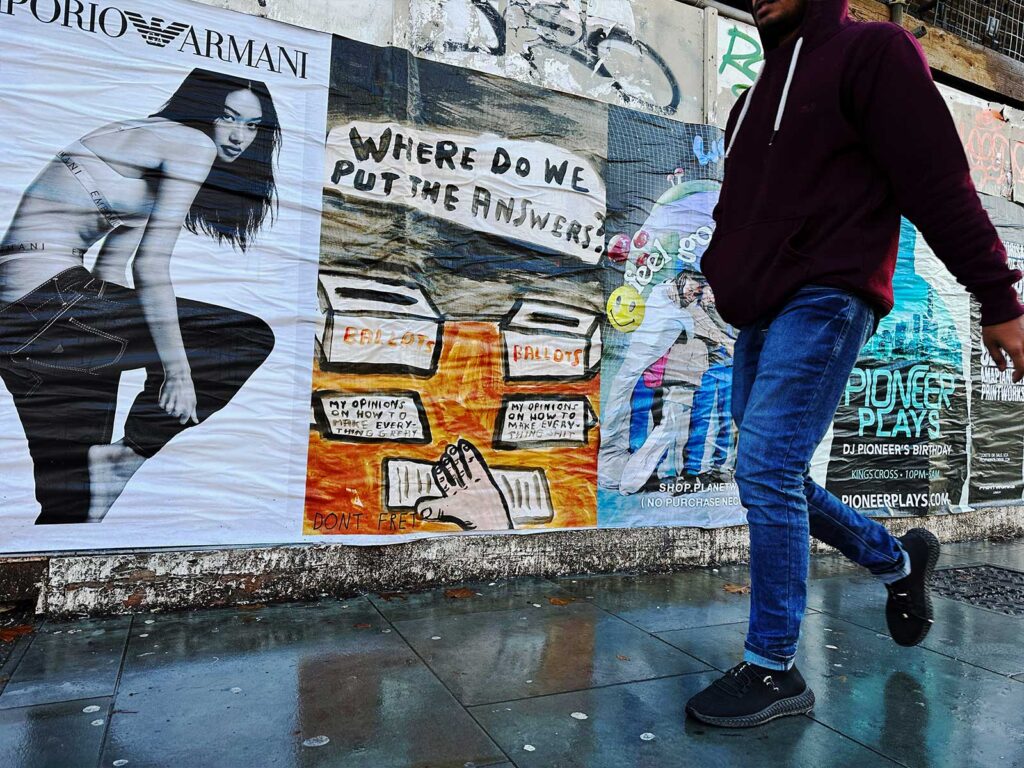
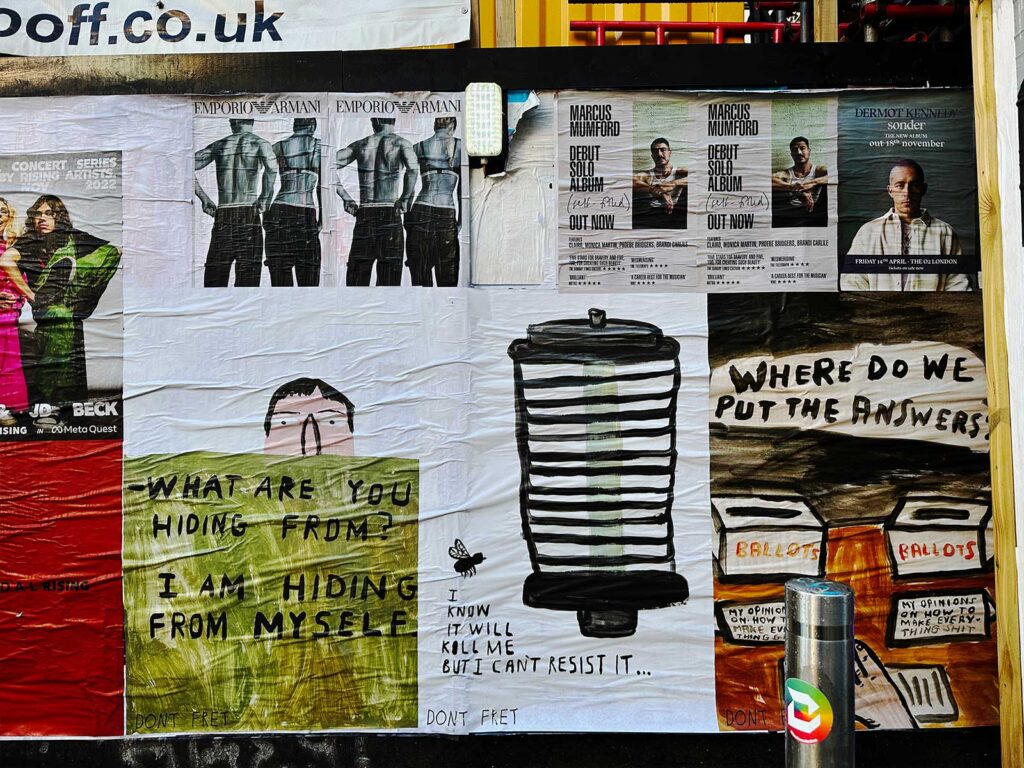
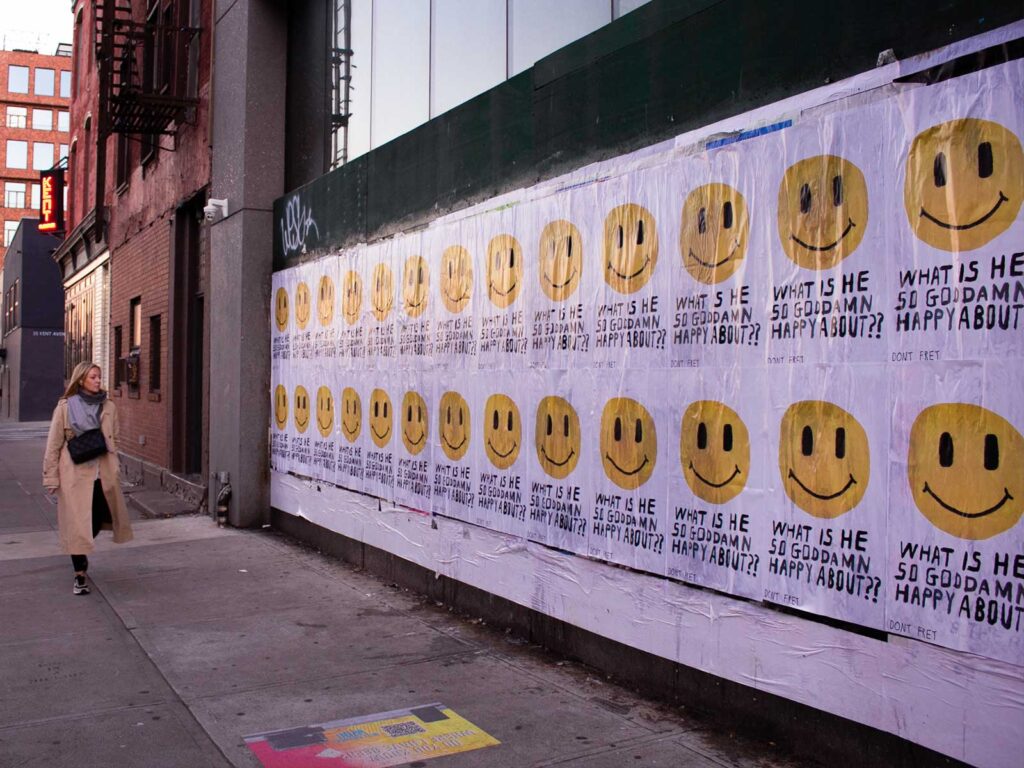
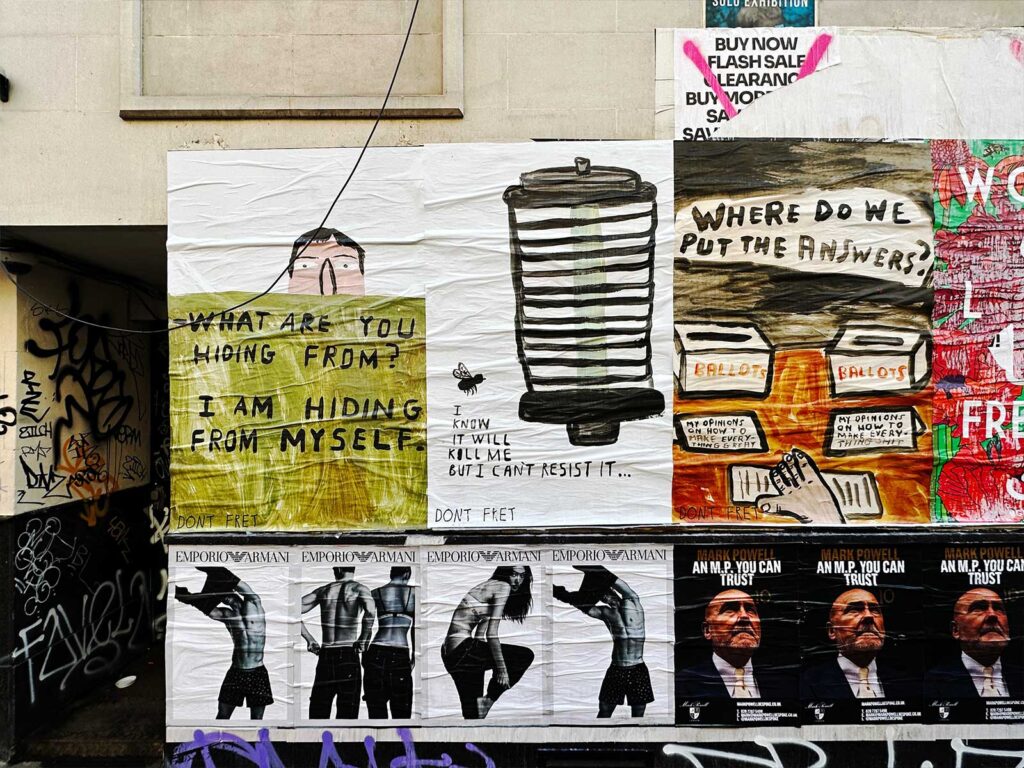
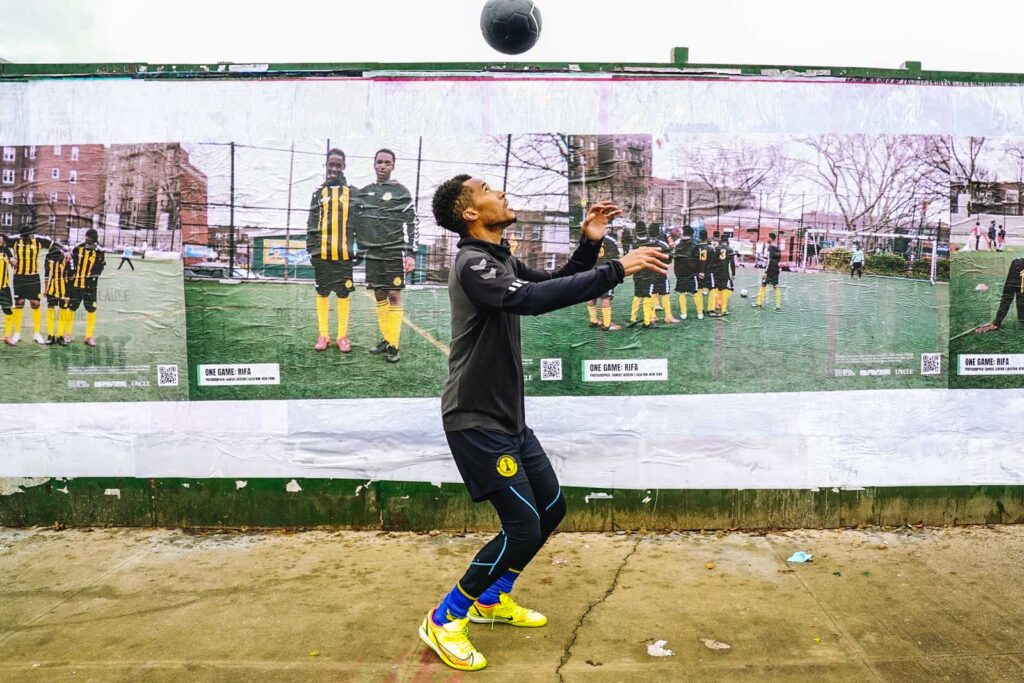
With all eyes on football this month, UNCLE have teamed up with Goal Click on project One Game to celebrate the unity football can bring to communities across the globe. Goal Click are an international football storytelling organisation who specialise in bringing real stories to light via an assortment of mediums. UNCLE have collaborated with Goal Click to show how football can be used as a force for good for people across the globe. We have adorned our poster sites with beautiful photography showcasing extraordinary stories that exhibit the true power of the beautiful game.
Project One Game is bringing visibility to the movement worldwide; Goal Click have provided important stories that range from the USA to Europe. Across UNCLE’s three poster designs we showcase Maria Romanchenko, Fatima Rouina and Samuel Gedeon. We wildposted their respective cities – London, Paris and NYC – with imagery indicative of the countless ways football can fit into the lives of many. Football is the most popular sport in the world, but not every game is played on a pitch, and it is this flexibility that allows the sport to touch so many. The stories told by One Game hope to portray this range and the transformative nature of the game.
Maria Romanchenko is a Ukranian refugee now living in London, she played at a professional level in Odesa, Ukraine. Football has shaped who she is, playing a formative part of her settling into her new home – “Football gave me a lot: friends, endurance, character and determination. This is something that I will never tire of doing. With the help of football, I maintain my physical and spiritual health”.
Fatima Rouina champions the beauty and freedom of street football, she is empowered by the versatility of the game – “Football is the place where I feel myself the most. I love playing on the street. There is freedom to play in the city. Football has this magic of being a sport that brings people together without borders. My friend Sarah was juggling the ball in a typical street of Montmarte area. You just need a ball to play on any type of field”.
Finally, is Samuel Gedeon, a refugee originally from Haiti, and aspiring diplomat, who sought out Rooklyn (RIFA) – a disadvantaged youth charity that provide integration into New York City life through football – “I tried to show how passion for soccer has brought immigrants from different countries together and created a community”.
We orchestrated a visit to their respective sites so they could see the impact that their story can have on the masses – reflecting the very ethos of Goal Click. The project is in partnership with BUILDHOLLYWOOD who have also set up sites exploring UK based communities. Please visit the Goal Click website to learn more about the positive impact they make and to read the full stories of those involved in the One Game project.
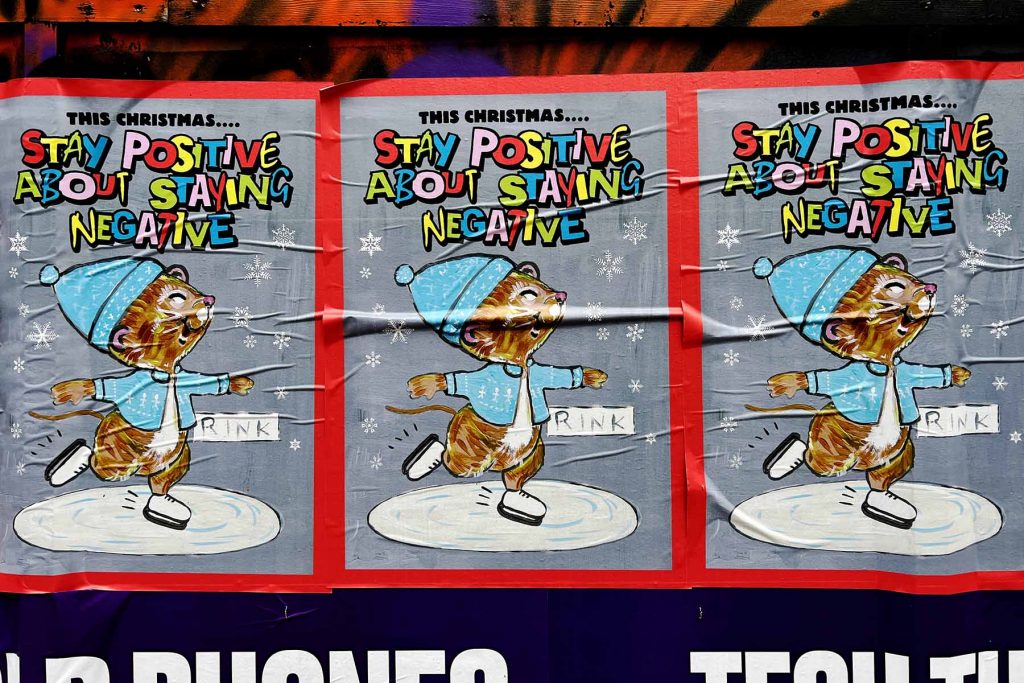
Artist and illustrator Magda Archer’s irreverent, colourful pieces play with nostalgia and innocence to convey relatable feelings. We partnered with Archer to bring that tongue-in-cheek relatability to the streets with posters featuring an ice-skating, happy mouse with the headline “THIS CHRISTMAS…STAY POSITIVE ABOUT STAYING NEGATIVE.”
Playing with the fatigue that we all felt entering yet another Christmas during the COVID-19 pandemic, Archer’s unique and upbeat style offers a different perspective. We pasted the posters on the streets of London and New York, brightening up the world at Yuletide. Posting on Instagram, Archer said, “WE’RE TRYING HERE little ice-skating mouse in the hand-knit!” and got a major positive response from her followers, which is all you can really ask for!
Archer is an accomplished artist with an instantly recognisable style. She trained at Ravensbourne College of Art, Chelsea School of Art and the Royal College of Art. Her CV includes a number of group exhibitions, the children’s book Watch Out Arthur!, and a solo show in Manchester. Speaking to Ingenue Magazine about developing her unique style, she said, “It’s something that changes, that develops, all the time. Simply put, I paint what I would like to see. My paintings tend to be little references to things that are happening to me. Why they look how they look is a bit of a mystery to me, but they have evolved. That’s the way it works. I like bright, cheerful colours and I do laugh when things go wrong in my life – so I guess these things come out in what I am painting.”
That ability to not take things too seriously is needed during such a dark time, and we’re proud to have brought just a little bit of that levity to our struggling city streets and passers-by.
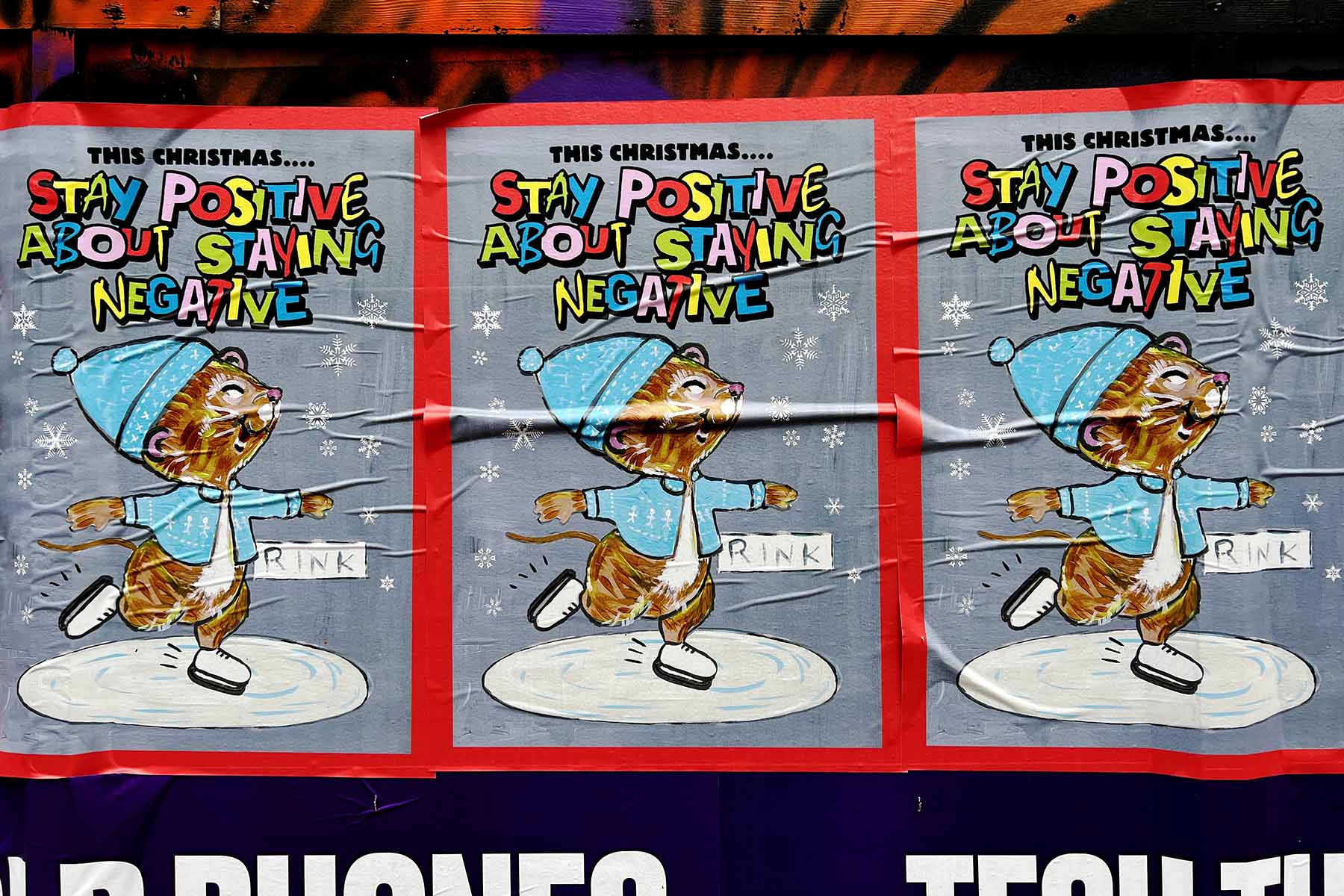
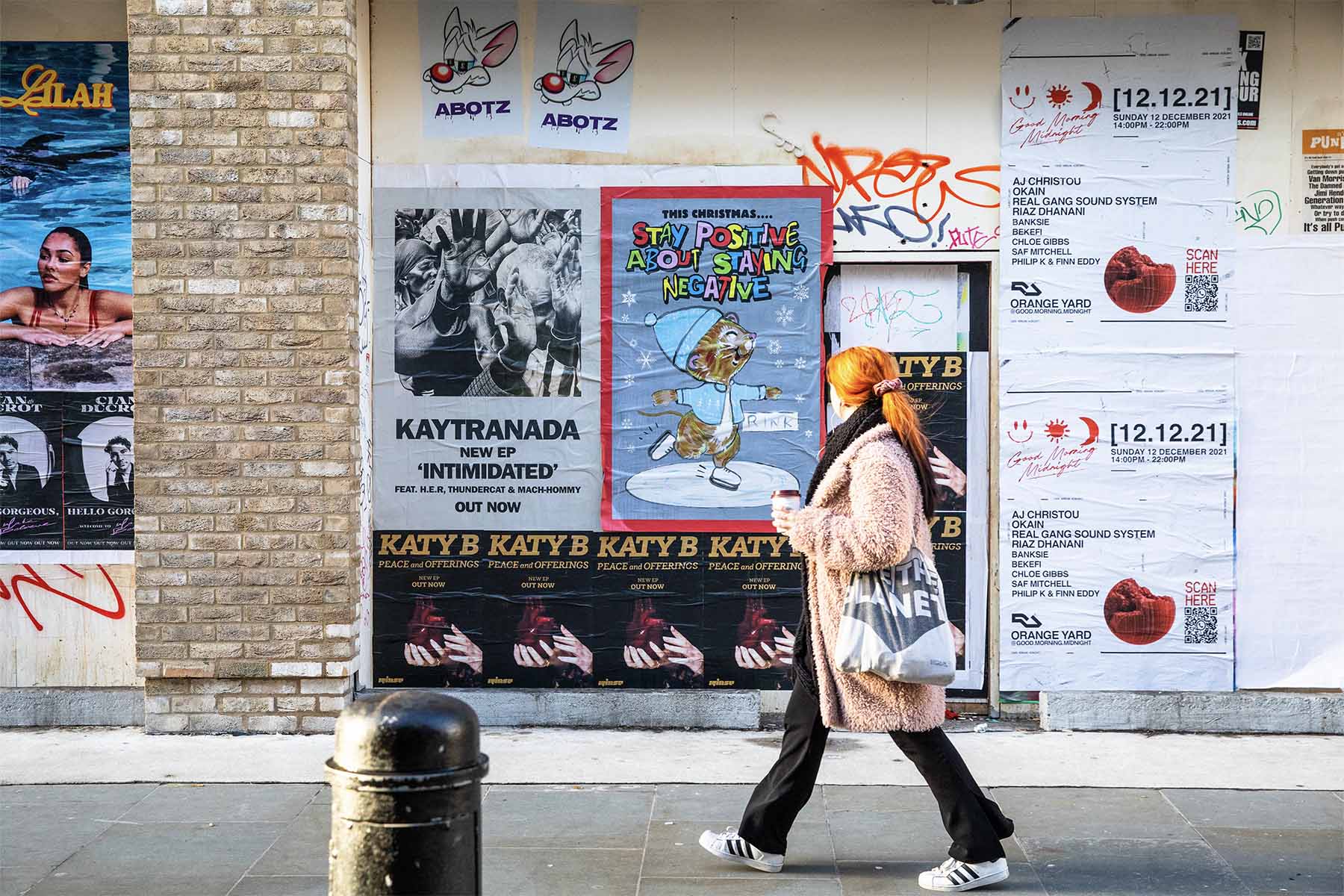
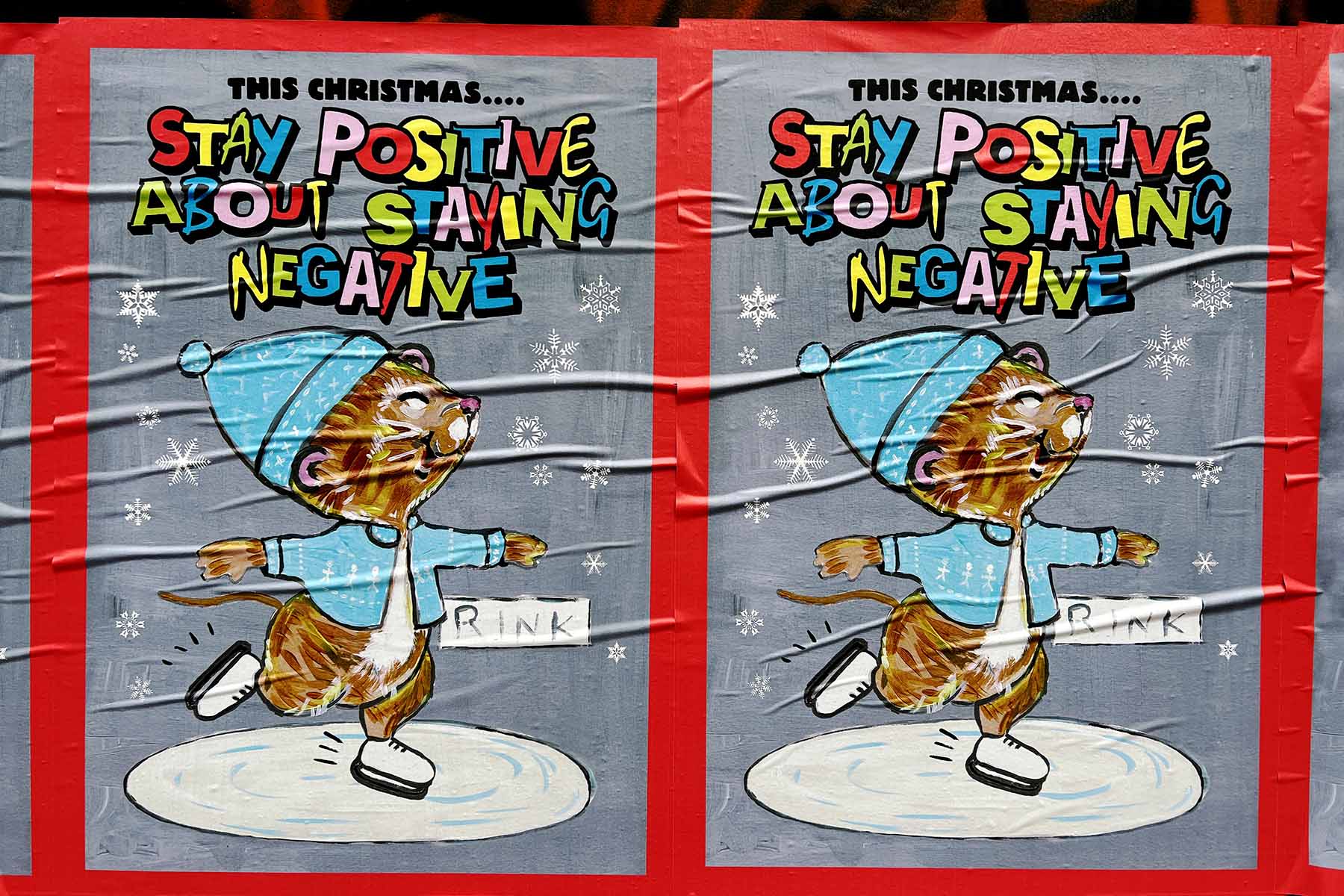
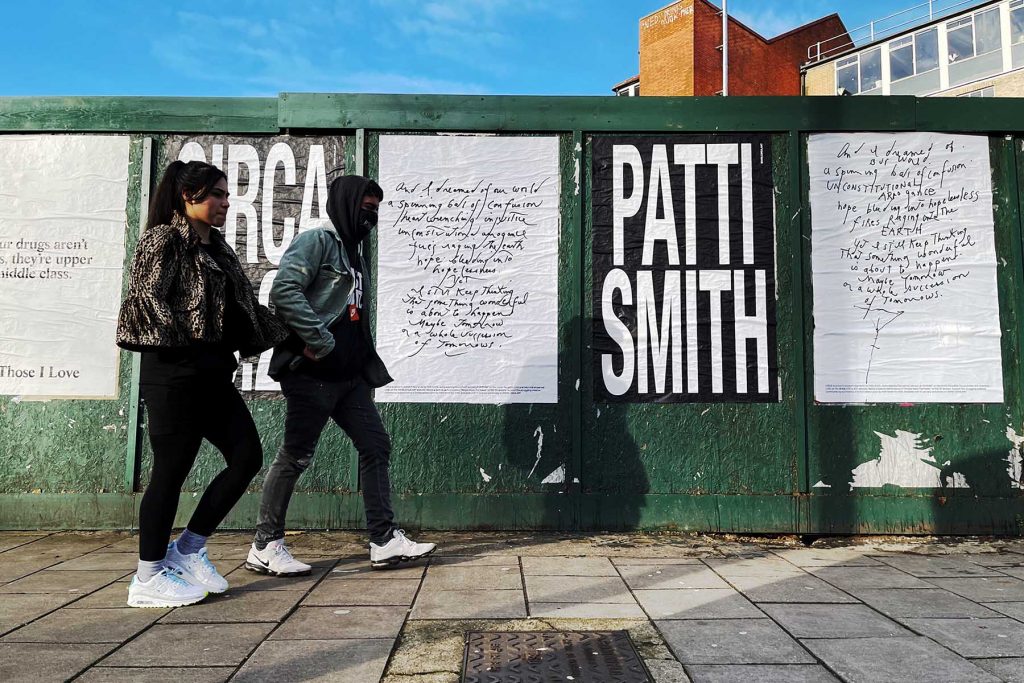
Patti Smith needs no introduction. The punk poet laureate has been making her unmistakable mark on our culture since the ‘70s, inspiring artists as iconic in their own right as Shirley Manson, Courtney Love and Madonna. Her unique fusion of poetry and awe-inspiring rock makes her a voice for our times, as epitomised by her collab with CIRCA Art. CIRCA is an art and culture platform with a purpose, collaborating with vision-driven artists like Ai Wei Wei, David Hockney and Jenny Holzer to stop the clock and spread important messaging every single day at 20:21. Their billboards and projections are seen across the world, and they seemed a natural partner for Patti Smith’s impactful words.
CIRCA commissioned a series of curated poems, imagery and texts to celebrate Greta Thunberg’s 18th birthday, featuring this handwritten poem by Smith calling Thunberg a herald of “wonderful tomorrows”. In an effort to bring attention to the dire effects of climate change that Thunberg herself has been so adept at raising awareness of, the posters celebrate a tomorrow that can only happen if we join together. As well as the posters and imagery, “A NEW YEAR” by Patti Smith streamed online every evening throughout January at 20:21.


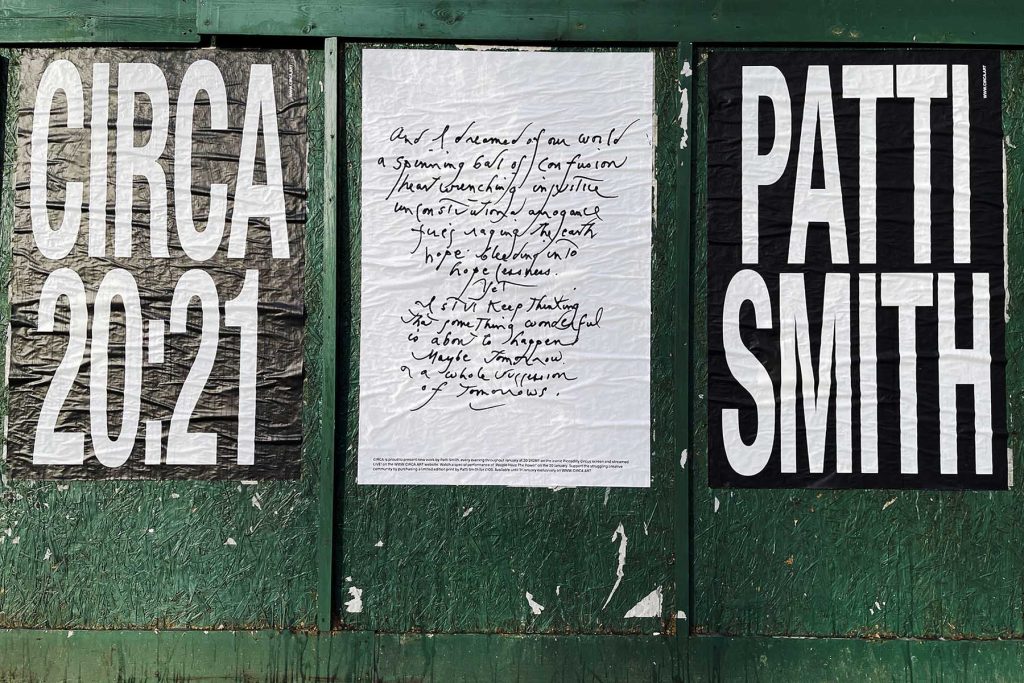
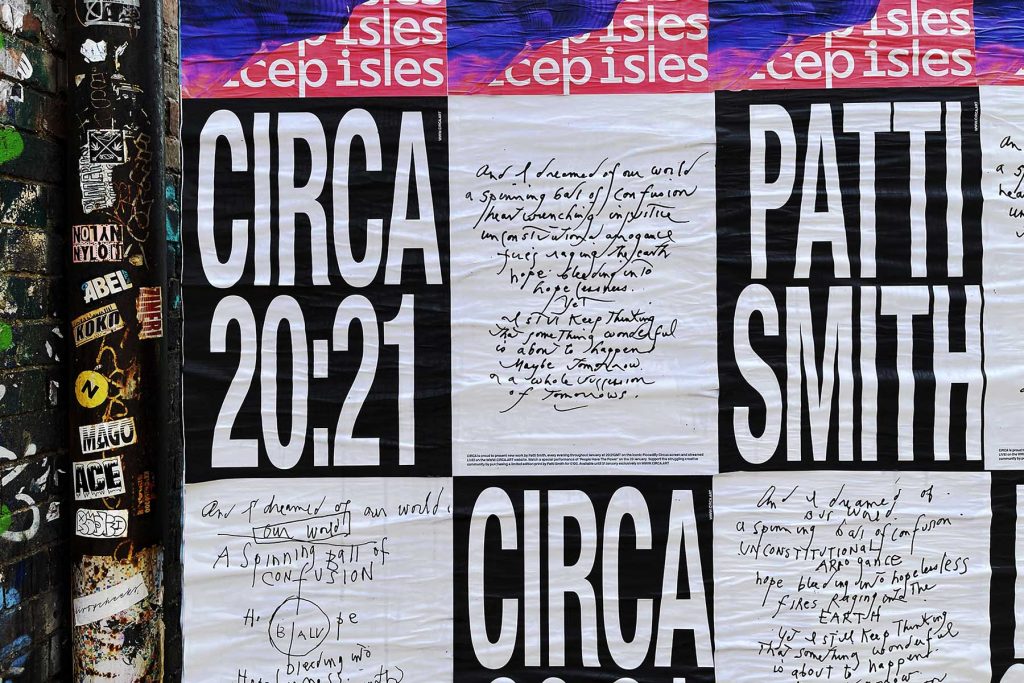
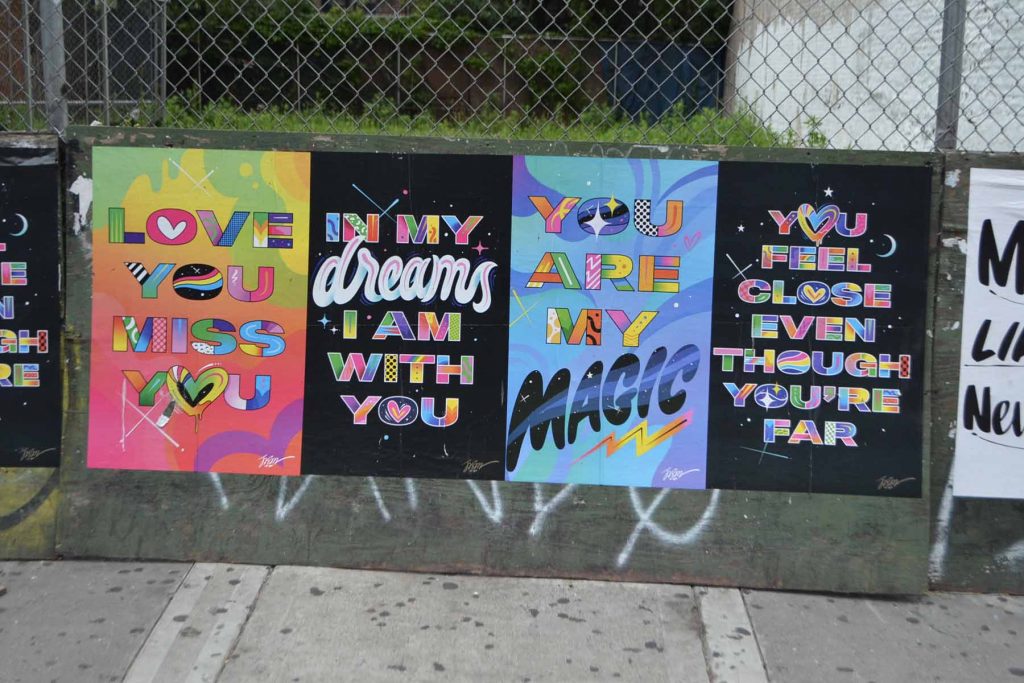
Award-winning artist, designer, and creative director Jason Naylor has a pretty impressive background. With clients including Guess, Xbox, Fenty and Space NK, Naylor was previously working in the Creative Department of MAC Cosmetics and brings that flair for colour to his art. For our collaboration, he crafted large-scale typography featuring phrases like “Love you miss you” and “You are my magic” and “You feel close even though you’re far” with colourful lettering, bold backdrops, and plenty of clashes.
The project was pasted on the streets of New York City during the first lockdown, an attempt at uplifting the citizens during a dark, gloomy time. Naylor is passionate about spreading life and colour across his own projects and the world. Based in Brooklyn, he has a BFA in graphic design and runs his own studio. According to his website, his work contains messages of love and positivity because he believes “that kindness is the key to success”. Working across all types of media, Naylor has won awards for his work.
Speaking to Roger Smith, Naylor said that his passion for street art is deep-seated, but that he was scared to try it until he had to. He said that he was asked to create a mural for Microsoft for their SXSW installation when “The wall graphics fell through. It was very last minute, and I didn’t have time to worry about tools.” He added that street art is therapeutic: “Painting in the street, in public is the most meditative place I have. Despite being in public, it’s a very peaceful, magical place I go when doing it. I love the energy of people watching, it energizes me to stay focused and productive. The process can be gruelling, going up and down a ladder all day, but it’s very rewarding.”
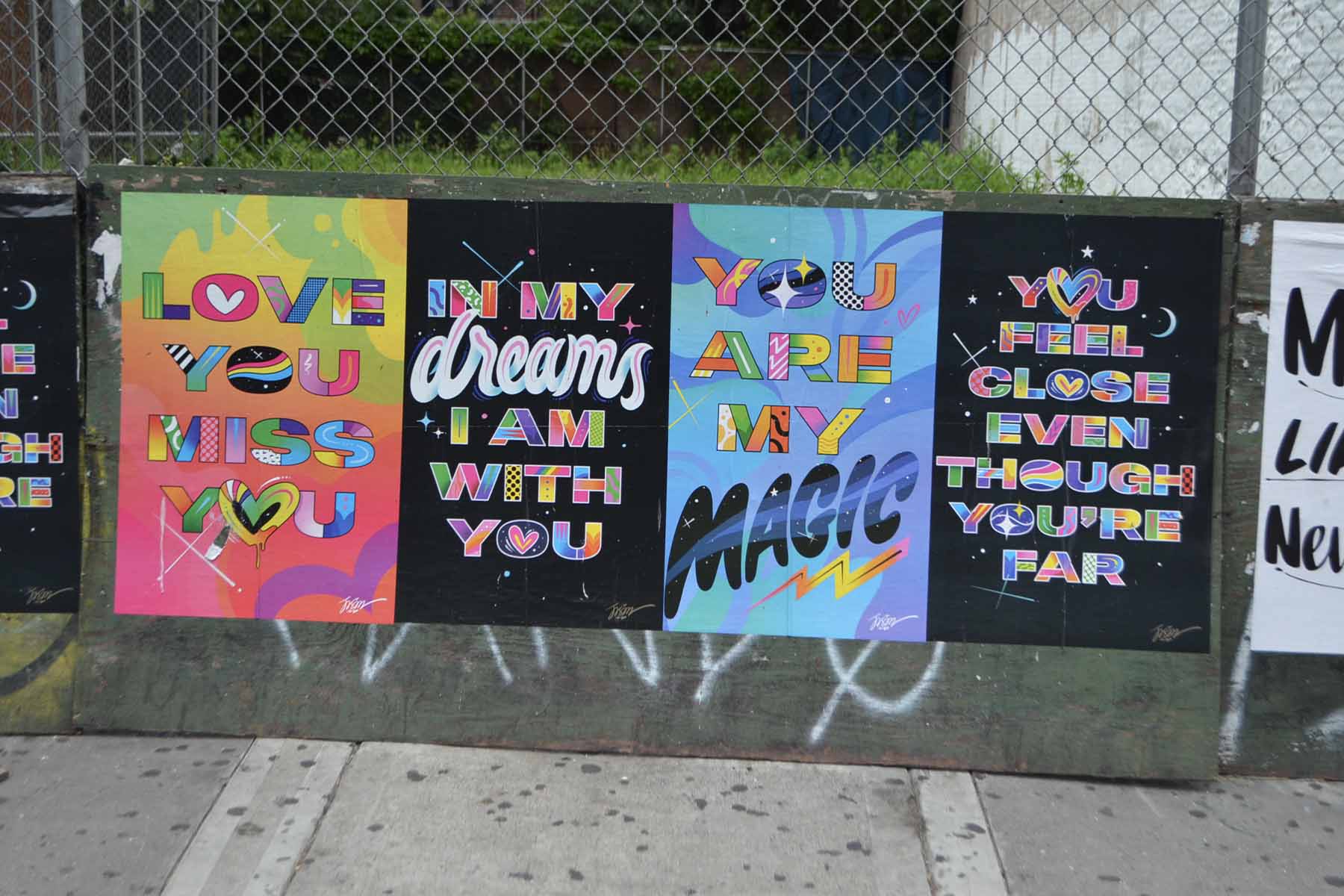
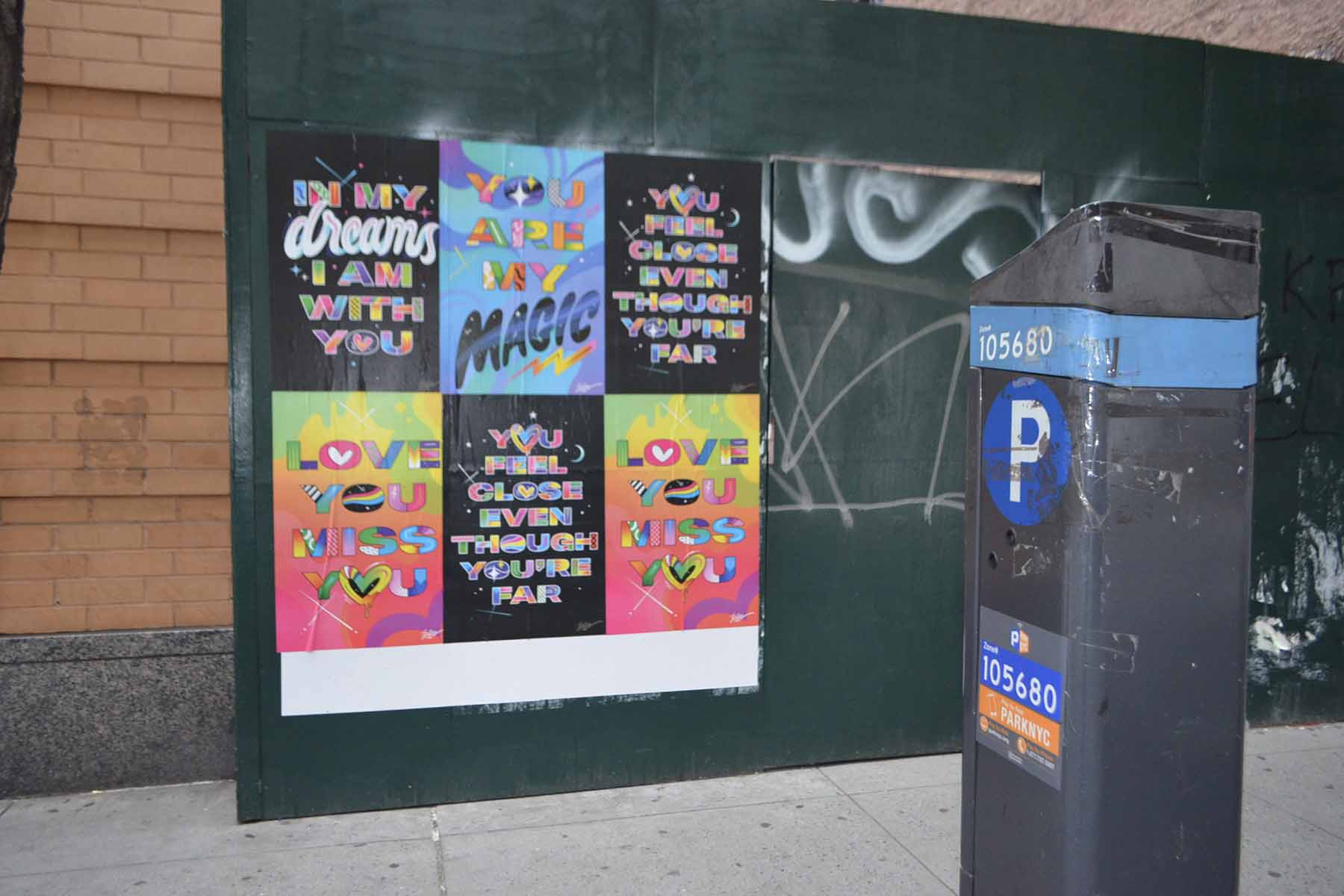
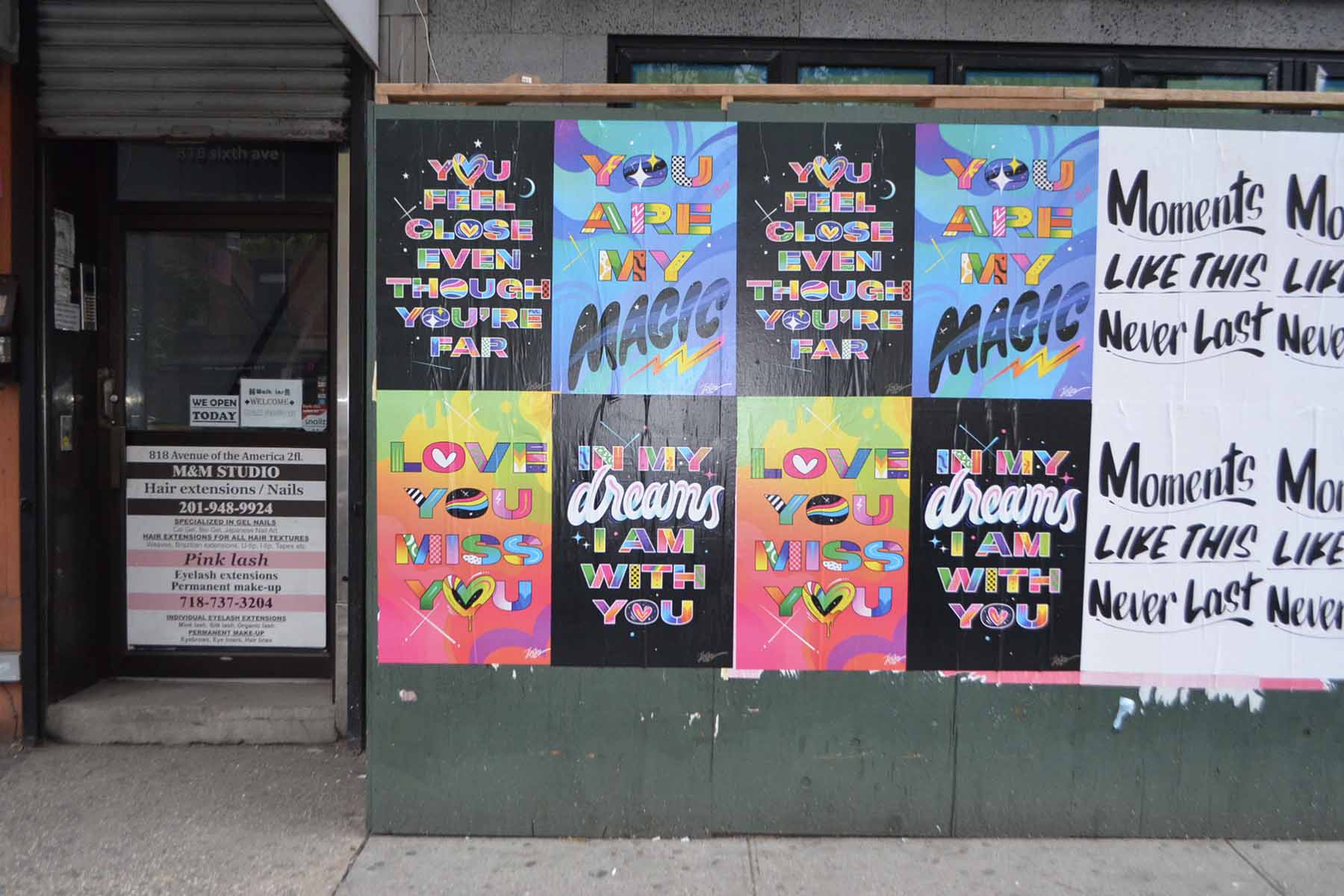
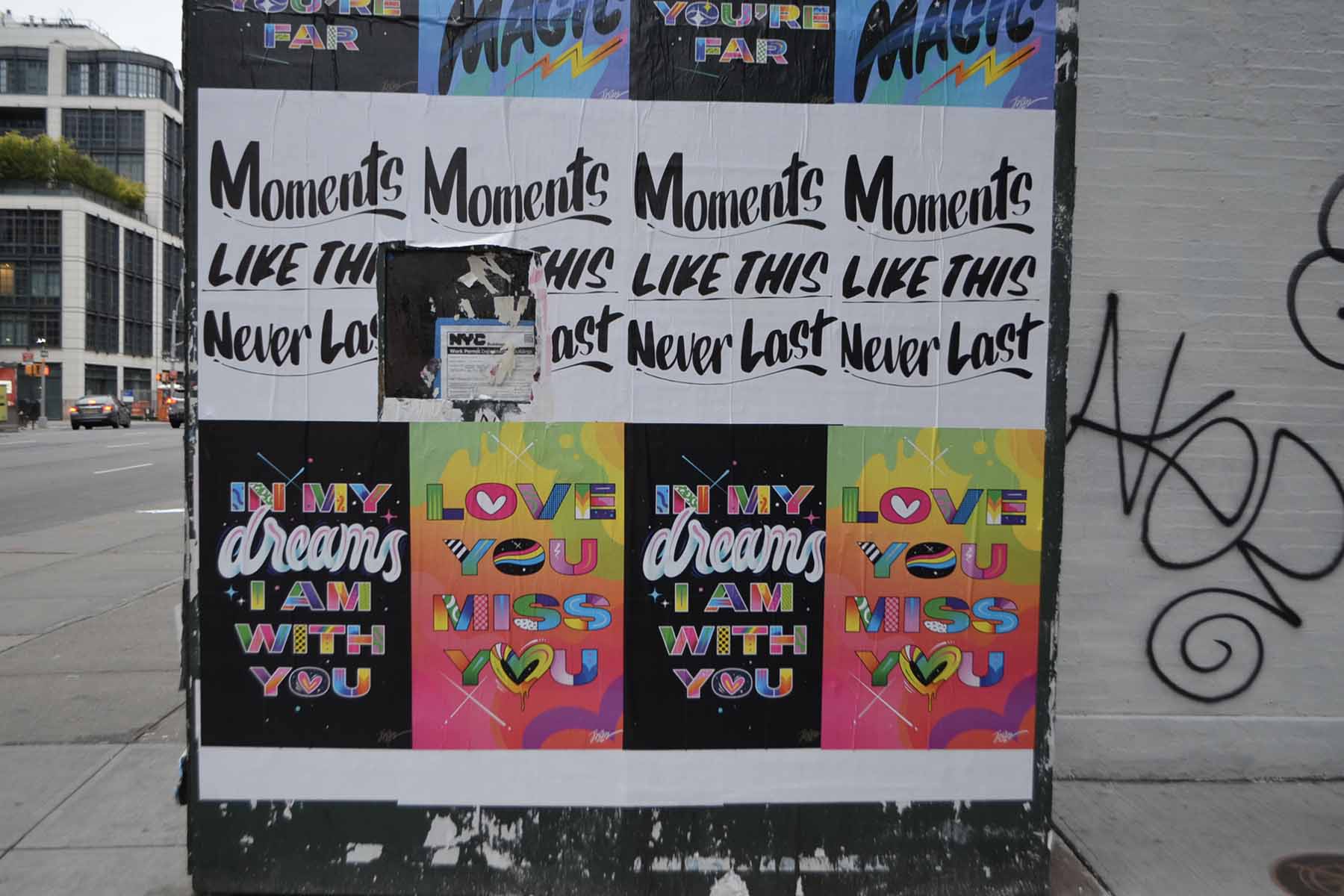
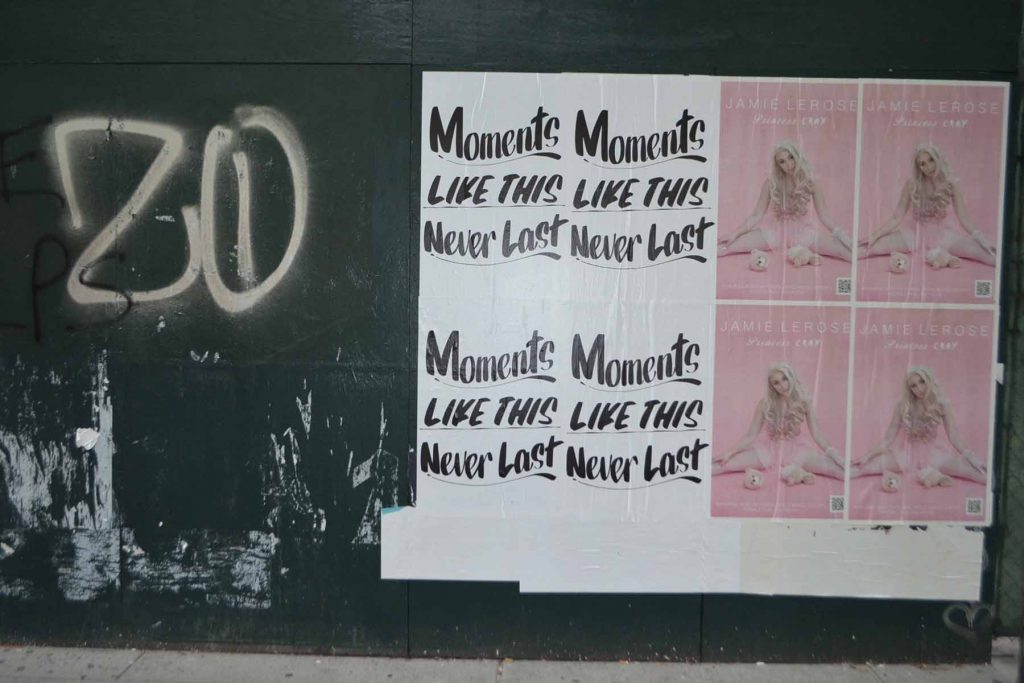
Baron Von Fancy, AKA Gordon Stevenson, is a New York born-and-bred artist working across mediums. Stevenson’s trademark is typography of boundary-pushing, funny, often cliché, always current phrases like “Mercury was in fucking retrograde”, “You don’t have to be crazy to do this, but it does help” and “Against all authority except my mom’s”.
As long-time fans of his work, we wanted to collaborate with Stevenson on something special. During the first lockdown, when New York City was experiencing a dark, lonely time, we teamed up with him on a series of posters that intended to bring some light to the streets.
Featuring the uplifting phrase “Moments like this never last”, the series combined his trademark typography with a simple white background to get across a message of hope and togetherness at a time when optimism felt distant. It served as a powerful reminder that this too will pass, however painful for now.
Known for his public art and bold messaging, Stevenson “Constantly strives to push the boundaries of his art and designs, employing boldly expressive lettering, incredibly vivid colours, and a range of materials including fluorescents, glue, dyes, and reactive paint.” Born to a hedge fund father in New York City and privately educated, Stevenson partly got his start in the art world via Instagram, sharing pictures of his works to an audience of over 77k. Speaking to High Lark, he said, “Instagram has been the most valuable thing to me in terms of my career.”
His website says that he “Seeks to question conventions by infusing his work with elements of street art that have inspired him since he was a child,” and that energy comes through in our collab, pasted on the streets of New York. We wanted to play with his unique style, bringing some levity to a difficult time for the inhabitants of his home city.
